The Cathars and Huguenots: The History and Legacy of the Major French Christian Groups Who Were Persecuted by the Catholics
By Charles River Editors

Chen Siyuan’s panorama of Carcassonne
About Charles River Editors

Charles River Editors is a boutique digital publishing company, specializing in bringing history back to life with educational and engaging books on a wide range of topics. Keep up to date with our new and free offerings with this 5 second sign up on our weekly mailing list, and visit Our Kindle Author Page to see other recently published Kindle titles.
We make these books for you and always want to know our readers’ opinions, so we encourage you to leave reviews and look forward to publishing new and exciting titles each week.
Introduction
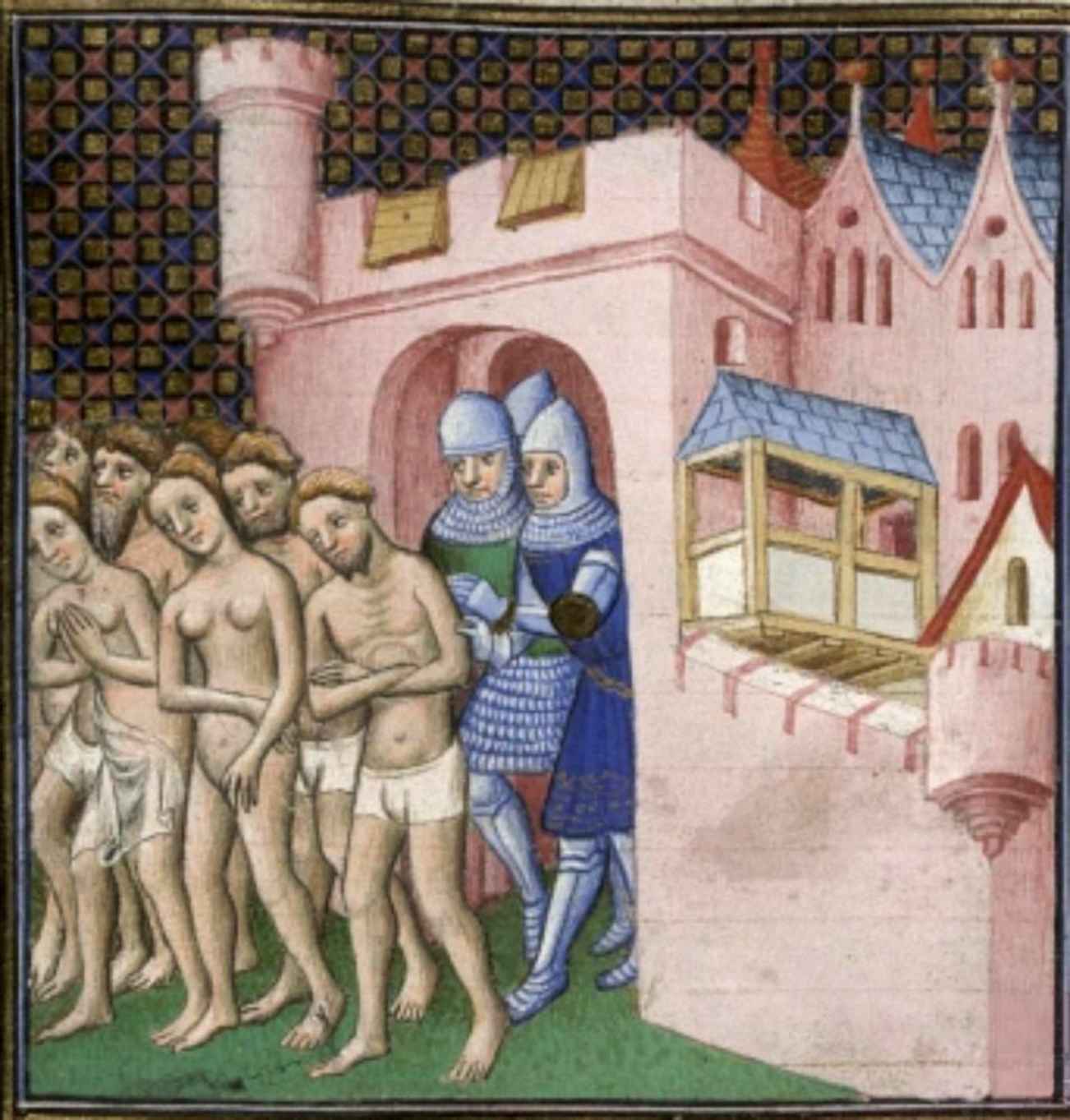
A medieval depiction of Cathars being expelled from Carcassonne in 1209
“The Roman Church...[says] that the heretics they persecute are the church of wolves. But this is absurd, for the wolves have always pursued and killed the sheep, and today it would have to be the other way around for the sheep to be so mad as to bite, pursue, and kill the wolves, and for the wolves to be so patient as to let the sheep devour them!” – Excerpt from the alleged writings of the Cathars
“A dog barks if he sees someone attacking his master; I would indeed be cowardly if, seeing the truth of God thus attacked, I played the mute, without saying a word.” – John Calvin to Marguerite, Queen of Navarre, April 1545
Carcassonne today is the capital of the Aude department in the Occitanie region of southwestern France, about 58 miles from Toulouse. It lies by the “eastward bend” of the glittering cobalt waters of the River Aude, which serves as a barrier between the two towns of the city: the Cité and the Ville Basse. It is the old Cité that attracts most of Carcassonne's visitors (3 million of them each year), for it houses the historic fortress that looks like it came straight out of a fairy tale and supposedly became the muse behind the captivating castles featured in Walt Disney's acclaimed 1959 classic Sleeping Beauty. But this breathtaking town is so much more than just the perfect spot for wedding shoots and social media narcissism, for it is a place that oozes medieval history.
This land is also home to several legends and local traditions. When the earth is drenched by heavy storms, the crumbling red soil drifts into the River Aude, staining the water with crimson. This beautiful, yet haunting phenomenon, which the locals call the “blood of the Cathars,” is a symbolic reminder of the blood shed by these “heretics” at the hands of the Catholic Church.
Despite the controversial events, and their supposed heresy, it seemed that the fall of the Cathars brought an everlasting curse upon the region. As one unnamed farmer, documented by French medievalist Jean Duernoy, put it, “Since the heretics were chased away from Sabartes, there is no longer good weather in this area.” Another notary from Tarn echoed his sentiments, asserting, “When the heretics lived in these lands, we did not have so many storms and lightning. Now that we are with Franciscans and Dominicans, the lightning strikes more frequently...”
In the 16th century, corruption, debauchery, and the general perversion of ethics were running rampant within the Roman Catholic Church. The public began to grow leery of the crooked church, and soon, they could no longer bite their tongues. Among the church's most vocal opponents was Martin Luther, whose publication of the 95 Theses gave rise to the Protestant movement.
This reformed brand of Christianity gradually spread throughout Europe, planting flags across the continent. France was among the first to latch onto the movement, and these new-wave Protestants became known as the “Huguenots.” The exact origins of the Huguenot name is still disputed to this day, but most historians have agreed it is a French and German translation of the Swiss-German term, “eidgenossen,” meaning “oath-fellowship.” The Huguenots mostly resided in the southern regions of France, along with the northern regions of Normandy and Picardy. They shared quite a few similarities with the Protestant Walloons, who lived in what is now Belgium, but the two groups were unique communities. Even so, both groups frequently convened to worship together as refugees.
The Huguenots, whose belief system incorporated a blend of unorthodox Waldensian and Calvinist teachings, continued to bloom, which did not sit well with the authorities. Critics attributed the rise of Protestant-led riots to the no-good Huguenots. The Huguenots were known iconoclasts who rejected statues, paintings, idols, and other religious images, as often seen in the numerous statues and stained glass artwork in Catholic churches. Across Europe, rebellious Protestants seized Catholic churches and swiped all heretical images, destroying them with axes and hurling them into roaring bonfires. The string of ambushes included the 1562 Looting of the Churches in Lyon, which were followed by similar attacks in Zurich, Copenhagen, Geneva, and many more.
Even in the face of persecution, the Huguenot influence gained momentum in France. A year before the looting, 2,500 Protestant congregations had already been established across the nation. The Huguenots held their services behind the curtains of secrecy, most commonly in the dead of the night. Some historians believe this clandestine operation could be related to the origin of their name. “Le roi Huguet,” meaning “King Huguet,” referred to purgatory spirits who haunted the living at night. Their perseverance eventually caught the eye of a pallid-faced Venetian ambassador, who purportedly warned his Catholic superiors that “3/4 of France was contaminated with the heretical doctrine.”
The Huguenots' burgeoning power and alleged attempts to infiltrate the world of politics soon alarmed the French authorities. They suspected that these Huguenots were low-profile republicans, involved in a terrible conspiracy to conjure up an uprising to overthrow the monarchy and re-brand France as a federal state. The royal government of France would attempt to tread lightly in the beginning, keeping their hands clean on neutral grounds, but a nightmare was about to unfold.
In the 1560s, French authorities called for the violent and bloody persecution of all Huguenots. This hostile period of 36 years, fraught with conflict, upheaval, and civil vendettas between the Huguenots and Catholics, is now known as the “French Wars of Religion,” or simply, the “Huguenot Wars.” A short stretch of peace would later emerge as the wars began to wind down, but bloodshed was once again resurrected by rebellions brought forth by the persecuted.
The Cathars and Huguenots: The History and Legacy of the Major French Christian Groups Who Were Persecuted by the Catholics examines the origins of the groups and the results of the persecution against them. Along with pictures depicting important people, places, and events, you will learn about the Cathars and Huguenots like never before.
The Cathars and Huguenots: The History and Legacy of the Major French Christian Groups Who Were Persecuted by the Catholics
Councils, Synods, and Portentous Preludes
Modern Developments at Carcassonne
Free Books by Charles River Editors
Discounted Books by Charles River Editors
The Legend of Dame Carcas
“Yet could I these 2 days have spent,
While still the autumn sweetly shone,
Ah, me! I might have died content,
When I had looked on Carcassonne.”
“Carcassonne,” – French poet Gustave Nadaud, 1887
Posted by the Porte Narbonne, or Narbonne Gate, the entrance of the fabled La Cite in Carcassonne, is a striking bust that is often missed upon first glance, for it is overshadowed by the exquisitely preserved, millennia-old citadel in its background. But standing before the porte, her face draws one in – round, with plump cheeks, thin arches for eyebrows that follow the shape of her large, downturned eyes, wavy hair peeking out of her wimple – reminiscent of the “celestial” suns with human faces often seen in the bedroom décor of a hip, teenage girl from the '90s. Gaze upon her from a certain angle and distance, and it seems as if one of the iconic conical roofs behind her doubles as a russet-hued hennin.
Garbed in a fine gown with flower accents embroidered on her sleeves and a fussy wimple and veil, the joyfully radiant face that welcomes visitors into the citadel hardly appears to be the “heroine” type. Rather, the way she is depicted here is what usually springs to mind at the mention of a classic damsel in distress. That being said, while this particular damsel was indeed distressed, she relied on no one to not only save herself from the plight at hand, but the entire citadel itself.
This damsel, as inscribed on the plaque underneath the bust, is the beloved Dame Carcas, often billed by the locals as the star of the town's origin story.
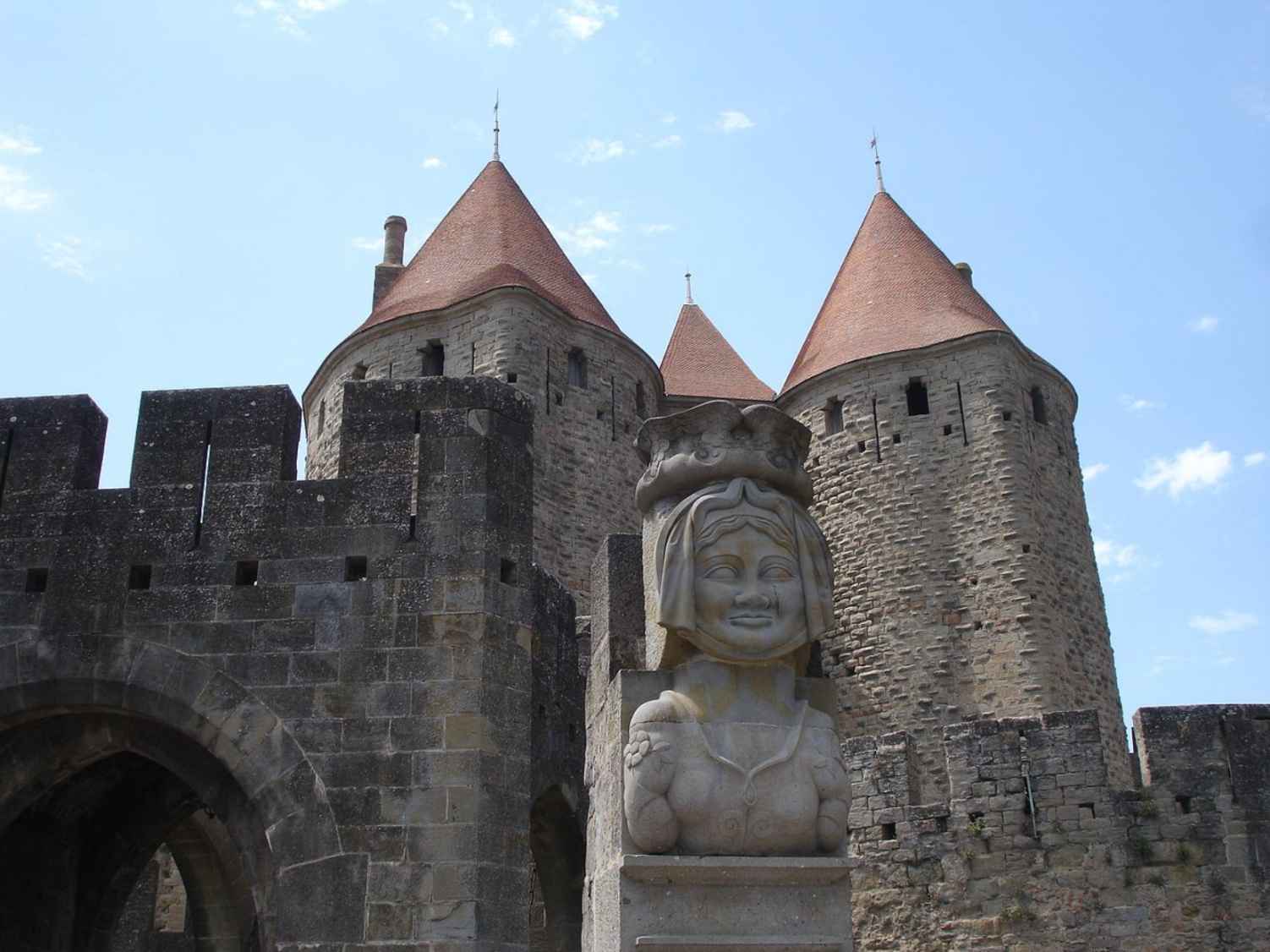
A replica of Lady Carcas’s bust
By the mid-8th century CE, the mighty Saracens from North Africa had conquered almost all of Spain, and having triumphantly trekked across the Pyrenees, they were well on their way to ticking off what is now the Occitanie region in southern France. The Moorish Emir Balaak, whose men seized the Carcassonnian castle shortly after their arrival, had moved into the spectacular complex, intending to make it his permanent residence.
Legend has it that the emir, though regarded by his enemies as a bloodthirsty, ruthless heathen of a prince, was anything but. Though aggressive and fearsome in times of war and conquest, Balaak, they say, was a compassionate, merciful man. Contrary to the rumors floating around the district, Balaak did not feast on the hearts of his prisoners, nor did he ornament the castle walls with the rotting, maggot-riddled corpses of his victims. He was charming, kind to his subjects, and reportedly even took it upon himself to educate the children of his prisoners in the “new science of mathematics.”
His wife, the boundlessly wise and diversely gifted Dame Carcas, was just as, if not more adored by their subjects. Carcas was steadfastly loyal and attentive to the needs of her people and what she believed to be the greater good. Obey them, she vowed to her subjects, and no one in the kingdom will ever lay their head to rest with a bare stomach ever again.
The locals took her proposal to heart and heeded the word of their new rulers, and the royals fulfilled their end of the deal. Every echelon of society was well-fed, literacy was on the upswing, and despite the initially rough transition, peace reigned. That was, until Frankish King and Holy Roman Emperor Charlemagne began to experience a serious case of castle envy, and became increasingly resentful towards the warm reception Balaak and Carcas were apparently met with. Above all, the emperor refused to accept the idea of “infidel” sovereigns governing the magnificent Carcassonne, which he deemed to be God's land, and pledged to return her to her rightful owner.
Charlemagne, accompanied by a dozen of his trusty paladins and a tremendous battalion of close to 3,000 soldiers, charged down the Montagne Noire (Black Mountain) like a cascade of ants spilling out of their knoll, and headed for the citadel. Meanwhile, the guards from the watchtowers, who had spotted the alarming sight, alerted Balaak and Carcas, who in turn, ordered them to prepare their defenses at once. The Saracen soldiers scrambled into action, but within moments, they were surrounded.
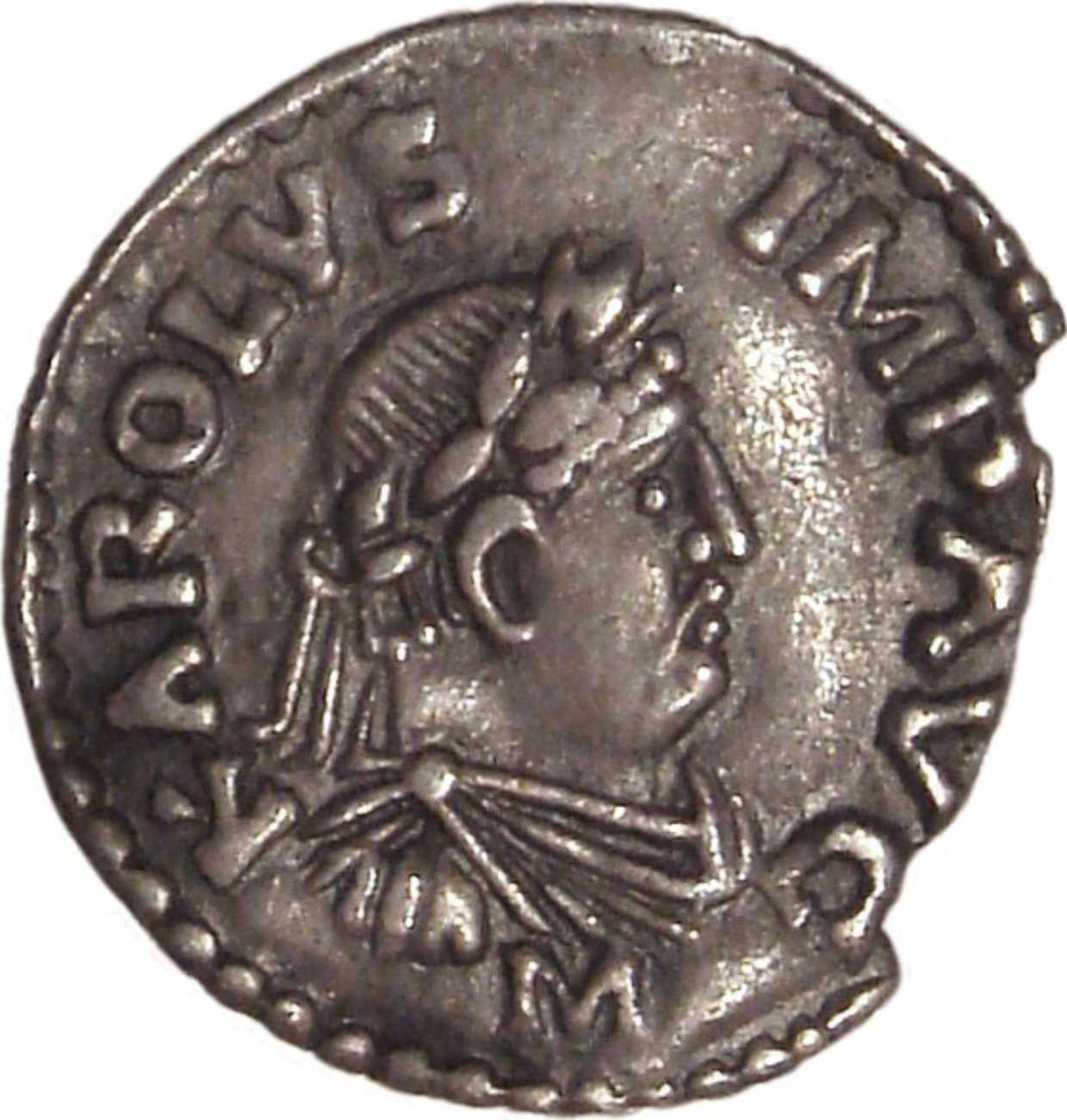
A 9th century coin depicting Charlemagne
The citadel rumbled and rocked with the boulders and other projectiles slamming into the gates and walls of the threatened complex. Arrows and javelins rained from the sky, smiting the hapless soldiers and inhabitants stumbling over each other in the chaos. From the opposite side of the fortress walls came the riotous cries of the Roman soldiers, along with the echoing voice of their leader, Charlemagne, demanding for those inside to surrender.
Though clearly outnumbered, the Saracens, joined by the royals, clambered up to the ramparts and turrets and faced their foes head on. They hurled spears, reciprocated the arrows, and resorted to a series of creative defense tactics, such as hurling at them logs, rocks, and debris, and dumping barrels of boiling water, oil, molten lead, and feces over the walls. “The harder the harvest, the happier the reaper!” a red-faced Balaak reminded his men. “By Allah, my accomplices, we will greatly mow!”
As resolute in their defense as they were, the swiftly dwindling Saracens knew that they could not hold on for much longer. And so, a new plan was hatched. Taking with him what remained of the soldiers, Balaak bade the love of his life farewell and marched out of the citadel gates to confront the assailants, and hopefully, arrive at an understanding. Alas, it did not take long for the negotiations to go awry, and in the resulting bedlam, Balaak, along with every last one of his men, were slaughtered.
Carcas's heart shattered at the news of her husband's death. At the same time, she knew that her people now needed her more than ever, and could not afford for her to lose her head. She promptly gathered all the women, children, and the elderly, and decking them with whatever weapons were left strewn about, ordered them up to the ramparts.
Digging up and donning her husband's old gear, Carcas proceeded to strip the clothes and armor off the dead and dressed up dozens of straw mannequins, which she then placed in turrets and other strategic locations to give the appearance of a fully manned fortress. Utilizing all the knightly training she received as a young woman, she flitted from one mannequin to another, firing arrows and launching spears, scythes, odd rocks, and whatever else that was within reach. The resilient Saracen villagers' battle cries, coupled with Carcas' exceptional agility intimidated Charlemagne's troops into reluctance and inaction, who had (correctly) assumed that they had already killed the last of the Saracen warriors. Charlemagne was so astounded by his foes' hardiness that even he turned to his paladins and declared: “It is a miracle that the warriors continue to dwell there!”
Carcas's strategy, while ingenious, was not built for longevity; it would not take long before those inside began to run out of steam. Charlemagne's men had taken their water supply hostage, and obstructed all exits, thereby preventing any food and supplies from entering the citadel. Even so, as the story goes, Carcas succeeded in holding down the citadel for another 5 years.
Naturally, all things must come to an end. By the fifth year, all the wells inside were completely drained, and only about 30% of the population remained. Worse yet, the crops were long gone, and all the livestock – even pets – were slaughtered for sustenance, all but one bony pig and a tub of sweet corn. The villagers presented the last of the food to Carcas, but rather than sate her growling gut, she beckoned the pig forward, crammed it with sweet corn, and flung the squealing pig over the wall.
Carcas leaned over the parapet, and with bated breath, watched as the overstuffed pig burst on the ground upon impact, its stomach showering Charlemagne and other nearby knights with innards and undigested kernels of sweet corn. The dame delighted in the look of bafflement and defeat on the Christian soldiers' faces. Charlemagne seemed most distraught of all. He grumbled with rage, “This place is overflowing with food! How numerous and vigorous they must still be if they can still give wheat to the most vile beasts!” Believing that they had accomplished nothing with their siege, the dispirited Frankish troops turned around and began the long, grueling journey home.
Needless to say, Carcas was exhilarated by her unlikely victory, and in a fit of glee, she ran a lap around the city, ringing every bell from every tower. The silvery peals of the chiming bells were so loud that they drifted into the distance, and were heard by Charlemagne's men. One of the paladins galloped up to Charlemagne, frantically exclaiming, “Carcas sonne! (Carcas sounds!)” But the emperor, whose eardrums had practically been splintered by the deafening trebuchet blasts, failed to hear anything but the ringing in his ears, and he brushed it off as a collective hallucination. Others say Charlemagne heard the bells crystal-clear, but unable to fathom the thought of being outwitted by a woman, he feigned ignorance and simply told his men to march on, never again to look back...
This, the locals say, is how Carcassonne received her name, but as compelling as this tale is, it is exactly that. On top of the fact that the story fails to coincide with events established by ancient records and historians in the timeline of Carcassonnian history, Dame Carcas herself is a fictitious character, one of a rather modern invention. As maintained by Sylvie Caucanas, the Director of the Departmental Archives of Aude, Carcas made her first appearance in literature as an “allegorical figure” in a poem penned by Jean Dupré in 1534, wherein he creatively lists heroes and heroines that inspired the names of various countries and continents, such as Asia, Europe, Libya, and Mantua.
Be that as it may, this legend resides in a special place in the locals' hearts, for the heroine still lives on in many parts of Carcassonne today. Apart from the bust, there are streets, rustic inns and suites, as well as restaurants dedicated to her, such as the Auberge de Dame Carcas, or the “Hostel of the Dame Carcas.” Attached to it is an eatery that serves an assortment of wines, dark coffees, cassoulet (a type of stew with pork skin and white beans), and honeyed pigs as a tribute to the swine that saved Carcassonne. In the local bakeries one will also find delicious almond cakes, or le petit carcassonnais,” either shaped like castles, or clothed in castle-print wrappers, as well as tins of shortbread biscuits called the “friandises de Dame Carcas (Treats of Dame Carcas).”
The dame is also celebrated annually in the Château Comtal of the medieval citadel. In an effort to keep the tradition alive among the younger generations, the Center for French National Monuments hosts a weekend-long family-friendly extravaganza packed with various workshops, musical and dance performances, treasure hunts, and story-telling that revolved around the Dame's heroics. During Sunday teatime, a massive chocolate pig is carted out to the dining hall in the castle, where it is hammered apart to reveal, not sweet corn, but a horde of miniature chocolate piglets for the children to enjoy.
Of course, all of this still leaves questions. How was Carcassonne actually given its name, and what is it about this enchanting place that reels in millions of visitors every year?
The Dawn of a Great Citadel
“Petit a petit, l'oiseau fait son nid.” (“Little by little, the bird makes its nest”) – ancient French proverb
Even prehistoric humans seemed spellbound by the lush, tillable swathe of land that eventually became Carcassonne, for she appeared to be eternally blessed with pleasant weather, but it was her prime location that sealed the deal. If one were to stand atop her hill, one would be presented with a sweeping view of stunning mountain ranges, habitable valleys, and the verdant Aude plain, which would soon belong to her, and better yet, a bird's eye view of potential trade routes. What would one day become Carcassonne sat on a slab of land sandwiched between a route that connected the Atlantic Ocean to the Mediterranean Sea, and another that linked the Massif Central to the Pyrenees.
Little information exists about the Neolithic Iberians who archaeologists believe were indigenous to these parts. Prior to the break of the Neolithic Age, mankind roamed the earth with their families, both immediate and extended, as nomads. They were genuine free spirits, albeit more for necessity than for independence-seeking reasons, who lived in interim shelters and lived free of possessions, excluding a few weapons, tools, or whatever they could carry in a pouch. The men hunted beasts and the women collected edible plant life for the entire clan, which was to be consumed in the same day, lest the precious food be spoiled. Once resources dried up and food became scarce, or perhaps, to escape the unforgiving chills of the winter season, they wandered over to their next destination, never staying in one place for more than a couple of months.
The first Neolithic settlement in what is now Carcassonne is estimated to have sprung up sometime between 3500–3000 BCE. The rise of the new age brought about a revolutionary new way of life. These former nomads found permanent homes in this promising patch of land, and gradually developed a society to call their own. Capitalizing on the seemingly bottomless resources around them, they fashioned stone tools through the then-novel concepts of grinding and polishing. They experimented with and eventually created the art of farming, and rather than rely on hunting, learned to domesticate the beasts around them. The flourishing settlement also instituted a primitive version of weaving, as well as pottery making, the latter mostly used to store harvested crops.
About 2,300 years later, the land was inhabited by a tribe with Celtic-Gaulish roots known as the “Volques Tectosages.” The tribe arrived first in the plain and valleys of Roussillon in the Eastern Pyrenees, and from there, poured westward to Toulouse, and later, to the area of Carcassonne. At this time, the land occupied by the Volques settlements, which sat on a plateau to the west of the modern-day Cité measured no more than 25 to 30 hectares (61.8 to 74 acres), just a sliver of the 6,509 hectares under Carcassonnian dominian today.
The tribesmen were among the first to punch deep pits into the earth, otherwise known as silos, to store their grain, which were later transformed into at least 500 silo towers. For shelter, they dwelled in small, simple huts constructed out of clay, straw, and stones, capped with tiled roofs. As innovative as they were, the Volques Tectosages were a superstitious people, and spent much of their time hoarding gold, silver, copper, amber, obsidian, lead ingots, gem stones, beads, and other currencies to appease their pagan gods; only by offering such valuables, they believed, would the gods smile down upon them and bless them with good weather and fortune.
Though much of their day was devoted to collecting these treasures for the gods, the Volques Tectosages opted to live plainly, with austerity and productivity at the core of their culture. Most worked in agriculture, collecting the grains stored in silos and crushing them with stones and wheels to produce cereals. Some tended growing herds of sheep, goats, and pigs. Others prowled about in the woods, hunting deer, boars, and other wild beasts.
Another portion of the population made their bread and butter in trade, working as merchants, clothes-spinners, craftsmen, and so forth. Ceramic workers and pot makers produced a wide array of everyday items, particularly vases, goblets, amphoras for wine and olive oil, and other containers. Blacksmiths produced weapons and tools out of bronze, copper, and iron, and supplied it to the traveling merchants, who then exported the items to Etruria, Greece, and the Iberian Peninsula. By the 7th century BCE, there was so much life in these lands that more than 9% of the previously undisturbed forested land was razed down to make room for more civilization.
A stretch of crudely made clay walls is presumed to have been installed around this vibrant and rapidly growing oppidum, which the locals named the “Carsac.”
About a century later, Carsac was scrapped and abandoned. The inhabitants relocated to the nearby hilltop, and erected a new oppidum there. Having landed themselves one of the most coveted squares of land in all of the Languedoc region, the settlers wasted no time in assembling their defenses. First, another curtain of walls was established around the new town. For added security, a moat measuring about 6 meters (roughly 20 feet) wide and 2.5 meters (8.2 feet) deep bordered the walls surrounding the fortified town.
There was relative peace in the region for the next 400 years, punctuated by a few attempted invasions and minor territorial squabbles here and there, but tensions between the Romans and the inhabitants of central and southern France would soon trigger a major shift within the Carsac community. In the year 122 BCE, the Romans overpowered those in Provence and founded a colony by the Gulf of Lion. Once the colony was firmly established, the Romans journeyed south to Marseille, conquered the inhabitants there, and moved on to the Languedoc region, where they planted more Roman colonies.
It would not take long for the Romans to recognize the strategic significance of Carsac's coordinates. And so, in 100 BCE, the Roman vanquishers swam across the moat, scaled the bulwarks, and drove the inhabitants out of the hilltop. What remained of the natives were assimilated by Roman settlers – more specifically, the Colonia Narbo Martius – who went on to rename their new oppidum the “Colonia Julia Carcaso,” or the “Colony of Julia Carcaso.” It was later shortened to the more melodic “Carcasum.”
By the last quarter of the 1st century BCE, the Roman Carcasum had blossomed into a full-fledged city, with the land on the foot of the hill now incorporated into its ever-growing territory. Carcasum was a thriving administrative and commercial center situated on the Aquitaine Way, and as the capital of the Julia Carcaso colony, presided over the western neck of the River Aude. Nestled between the towns of Narbo (Narbonne) and Tolosa (Toulouse), it was a bustling trading hub that saw the exchange of freshly picked wheat, barley, and other crops, cured meats, amphoras, metals, and sundries, some imported all the way from Montagne Noire, Corbières, and Rouergue.
To better guard their prosperous trading town from roaming pillagers, the Romans built the first stone walls that encircled Carcasum, which was essentially the debut of the Cité. These were the sturdiest bulwarks yet, zigzagging on for about 1,200 meters (1.2 kilometers) and reinforced with distinctive semi-circular towers and secured posterns. Archaeological remnants suggest that the site of Carcasum, at this stage, was no longer just a mere 74 acres but was estimated to have encompassed the bourns of the mountain, and it extended down to the northern end of what the locals called the “Narbonne-Toulouse Road.”
While excavators have been unable to unearth any traces of the public buildings that existed during the Roman-Gallo period, hints of the original construction, including certain sections of the bulwarks, walls, and ramparts, are still visible in the modern fortress. As such, they were able to conclude that the bulwarks were pieced together with squared blocks of sandstone of roughly even weight, thickness, and height, rather than the usual tuff, a type of light, porous rock produced by condensed volcanic ash. The rubble surrounding the fragmented walls in the Roman ramparts on the northern end of the fortress reveal the thin, pale red pieces of the “fired clay” bricks used in their construction. The unique geometric mosaics that garnished the floors also indicate, though not concretely, that the buildings and houses built by the Romans were most likely orthogonal structures.
As it turns out, it was wise of the Romans to strengthen their defenses, for their greatest fear would one day be realized. The Romans at Carcasum managed to cling on to their fortress for a little over half a millennium until the Visigoths, spearheaded by King Theodoric II, conquered Gaul and declared Christianity the official religion, thereby transforming the site into a bishopric. It was in the year 453 CE (according to some sources, 436 CE) that the Visigoths ousted the Romans from Carcasum, which was soon renamed “Carcassonne.” 9 years later, Septimania, the Roman predecessor of the Languedoc-Roussillon region, was ceded to the Visigoths.
Under Theodoric II, Carcassonne was converted to a frontier post, a border checkpoint of sorts for the northern neck of his kingdom. Apart from adding to the Roman-built fortifications and lengthening the crenellated bulwarks, the Visigothic king, a subscriber to Arian Christianity, built one of the first Christian churches in the area, dedicated to Alaric I, first king of the Visigoths. The church was later succeeded by a grand basilica constructed in honor of Saint Nazaire. Another namesake of his was a 2,000 foot tall emerald-green mountain not too far from the fringes of Carcassonne, the Montagne d'Alaric.
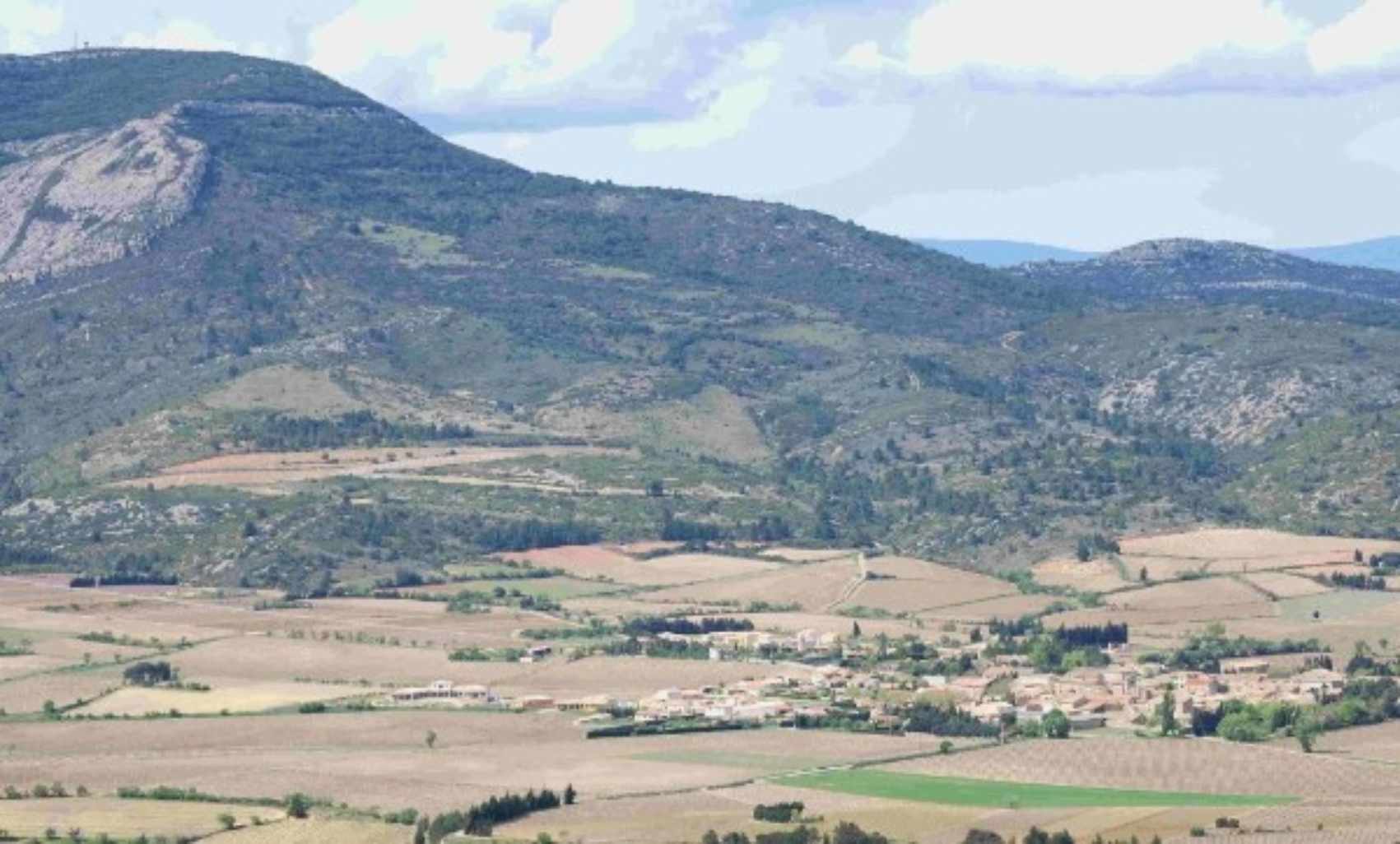
Vic Martin’s picture of the mountain
A number of Visigothic leftovers help to shine a light upon their lifestyles. One of their cemeteries, for example, the Moural des Morts, which lies in the thick of a pine forest just 12 kilometers (7.5 miles) away from Carcassonne, is home to 44 stone tombs, laid out in “east to west” fashion. Judging by the size of these graves, even if one were to disregard those that belonged to children, the Visigoths were much smaller in stature compared to the size of an average adult today.
The vestiges of the Visigothic era also supported the fact that they were competent architects and builders, but they were lacking in terms of innovation. For the most part, they replicated Roman blueprints, and did little to improve upon them. That said, they worked expeditiously, and leeching off the designs of the subjugated, they assembled anywhere between 34-40 towers in their time. 2 of these towers, the chapel tower and the 92-ft Tower Pinte, loomed over all, the rest of the buildings in the area shivering in their shadows. In 485 CE, the newly crowned King Alaric II commissioned the renovation of the inner ramparts, instructing the builders to reinforce and expand upon the existing Roman structures.
It was only after securing the perimeters that the Visigoths began work on developing more settlements below the hilltop, which was known as the “Lower Empire,” or today, the Ville Basse. The northern wing was absorbed into the fortifications by extending the bulwarks around them, and visitors can still make out the area of attachment by a castle gate known as “Le Bourg.” It was here in this neighborhood that Christianity flourished, helping bring about a number of different Christian sects.
The Treasures of Carcassonne
“Who ought to be the king of France? The person who has the title, or the man who has the power?” – attributed to Pepin the Short
By the beginning of the 5th century CE, the western half of the Roman Empire was finding it almost impossible to stay afloat. In addition to an economic slump, the formerly flourishing empire found itself targeted by an onslaught of attacks from so-called barbarians, such as the Visigoths, the Ostrogoths, and the Huns. In 410 CE, the once indomitable city of Rome was held hostage by the Visigothic King Alaric. The standoff ended after a period of 3 days, but the humiliating event had tainted its reputation, and it took a noticeable toll on the Romans' morale. Western Roman authorities powered through for some time, but the abrupt deposition of Emperor Romulus Augustulus 66 years later by Flavius Odacer, who then rose to prominence as the first king of Italy, marked the disgraceful fall of the Western Roman Empire.
Following the dismantling of Western Roman Empire, the barbarian kings who had been eyeing the Roman lands competed to chisel out a chunk of the now defunct empire. Among these philistine monarchs was King Chlodovech, also known as King Clovis I. Not only would Clovis triumph in capturing Gaul, he fathered the famous Merovingian bloodline, otherwise known as the “long-haired kings,” a driven dynasty that reigned for more than 200 years.
Clovis was no older than 15 when, upon the death of his father, King Childeric I, in 481, the crown of the Salian Franks was thrust unto him. Despite his young age, Clovis was determined to uphold his revered forerunner's legacy and do him proud.
The Salian Franks were first granted permission by the Romans to settle in the area of what is now Belgium around 358 CE, so long as they agreed to manufacture and equip the Roman soldiers and defend the border on their behalf. It was this relationship fostered by the Franks and the Romans that allowed for the piecemeal “Romanization” of the Franks. Like those who came before him, King Childeric aligned himself with the Romans, and captained numerous campaigns against the Visigoths, Saxons, and other barbaric Germanic tribes. His unswerving allegiance and loyalty to the Gallo-Romans earned their appreciation for him, so much so that several Roman officials inconvenienced themselves with travel to attend his elaborate funeral. Some even contributed to the hoard of weapons, jewels, gilded bees, 15 horses, and other fortunes buried alongside the royal casket.
By the time Clovis was brusquely seated upon the throne, the continent of Europe was a colorful patchwork of religious bodies. Arian Christians, Celtic Christians, Saracens, and pagan monarchs governed extensive strips of land, each committed to their own beliefs, and unreceptive to the then fledgling and wildly disorganized papacy. But the Roman papacy, though far from the powerhouse it would one day become, was every bit as ambitious as they were uncompromising about their creed.
Though the Ostrogoths, Visigoths, Vandals, Suebi, and Alans were technically Christians, they were disciples of Arius, a 4th century Christian presbyter based in Alexandria, Egypt. Arian Christians preached that Jesus, while possessing divine powers, was not divine himself, and was therefore “more than man, but less than God.” As such, all Arians, Celtics, and other “new-age” Christian sects were promptly branded heretics by the Catholic Church. Their unorthodox views, and more importantly, their recalcitrance to the papacy was highly problematic for the Church, for this prevented them from bringing these irreverent and ungodly tribes, and in turn, their territories, under papal control.
Contrary to other Germanic tribes at the time, the Salian Franks were polytheistic pagans who bowed before a bevy of Germanic deities such as Wuotan (Odin), Zio (Mars), and Donar (Thor), among many others. Enter King Clovis I, and these longstanding traditions crumbled. Chroniclers say it was his consort, a Burgundian princess by the name of Clotilda, a devout Catholic in a family of Arians, who “showed him the light,” so to speak. She badgered him endlessly about shedding his convictions and converting to the one true faith.
As told by historian Gregory of Tours, it was in the year 496 that a 30-year-old Clovis agreed to put his dear wife's faith to the test. If the Catholic deity were to ensure his victory over the Alemanni tribes in the Battle of Tolbiac in Germany, he would wash his hands of paganism for eternity and embrace Clotilda's god. Lo and behold, God seemingly did just that, because a few weeks later, the rival king was slain. Clovis's own army suffered crippling losses and barely emerged triumphant over his foes, but the Alemmani grudgingly raised their white flag not long after the loss of their king, and to Clovis, this was enough proof of God's existence. On the 25th of December that year, Clovis commemorated the birthday of Christ by submitting himself for baptism, which was performed by Bishop (and later Saint) Remigius in the cathedral of Reims.
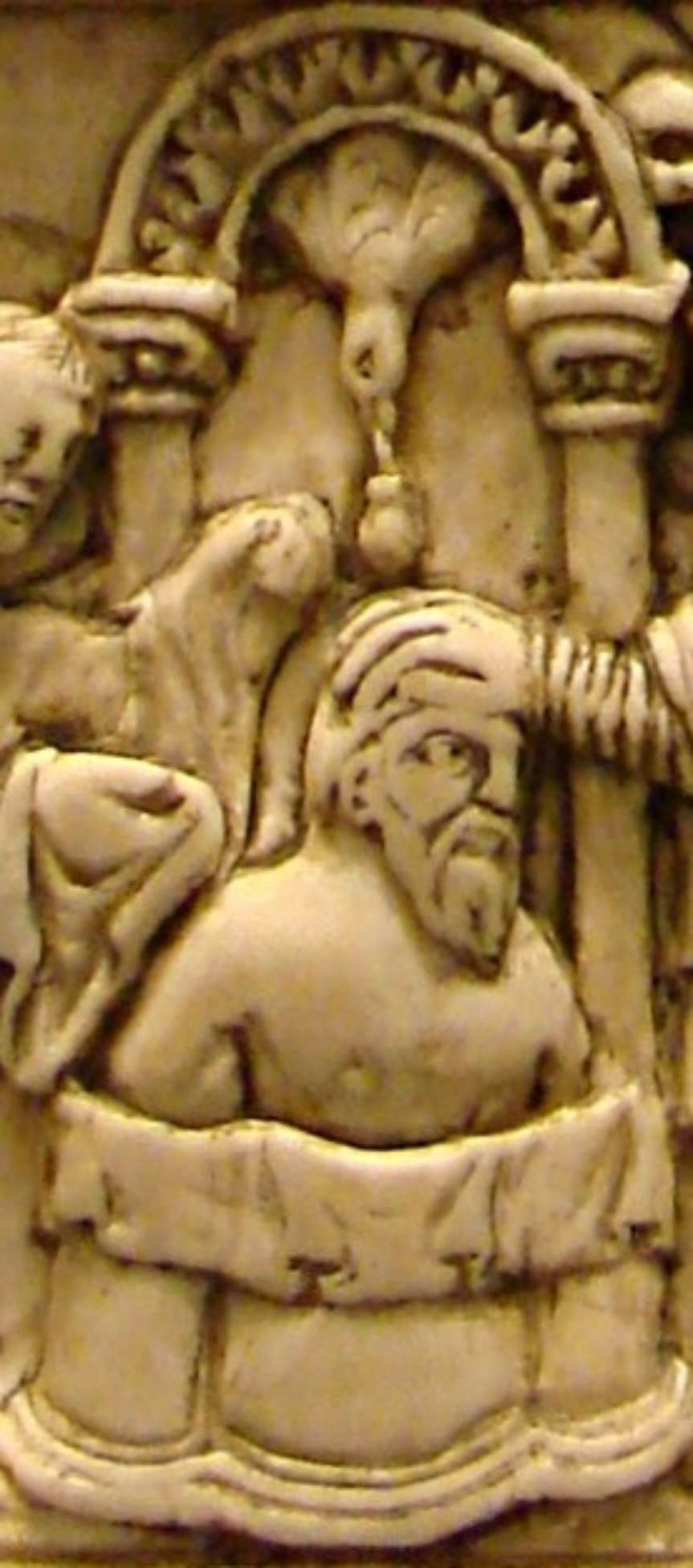
A medieval depiction of the baptism
James Harvey Robinson, author of An Introduction to the History of Western Europe, succinctly summarizes the significance behind the baptism of the Frankish king: “With the conversion of Clovis, there was at least one barbarian leader with whom the Bishop of Rome could negotiate as with a faithful son of the Church...Certainly Clovis quickly learned to combine his own interests with those of the Church, and the alliance between the pope and the Frankish kings was destined to have a great influence upon the history of western Europe.”
The religious discord between Clovis and the rising Arian superpowers, specifically the Visigoths, seeped into the 6th century. These non-secular battles are said to have been the first of its kind. As Henry Hart Milman, who authored History of Latin Christianity, put it, “For the first time, the diffusion of belief in the nature of the Godhead became the avowed pretext for the invasion of a neighboring territory.”
Clovis, who now believed it was his purpose to bring these heretics to heel, initiated a string of military campaigns against these heathens, primarily pinning his focus on the Burgundians to the southeast of his kingdom. Ultimately, he was met with much resistance until 507, when he conquered the Visigoths at Vouillé in central France. Not only did his troops succeed in polishing off the Visigothic King Alaric II, the victory allowed him to annex a vast portion of southwest Gaul. Impressed by the crushing of the Visigoths, Eastern Roman Emperor Anastasius bestowed upon the Frankish king an honorary consulship, granting him authority over all other western kings.
Following the devastating defeat, which deprived them of their king, the surviving Visigoths scattered, taking refuge in the remaining Visigothic strongholds. His ego and confidence boosted by the victory at Vouillé, Clovis marched onward to Bordeaux, which he put down with little effort, and camped out there to escape the frigid cold of the winter. Once the ice had thawed, the Frankish troops proceeded to Aquitaine, and later, the Visigothic capital of Toulouse. They seized the territories there, swiping not only Visigothic domains but almost all of their treasure.
Carcassonne was, at this stage, considered a part of the Roman-conceived but now Visigoth-controlled Septimania, a district composed of the following bishoprics: Elne; Agne; Lodève; Béziers; Narbonne; Maguelonne; and Nimes; as well as the Aude and the Languedoc-Roussillon regions.
Some say it was simply Clovis' insatiable hunger for an even bigger kingdom that led him to direct his attention towards Carcassonne. It only made sense for Clovis to set his sights on Carcassonne, for it was no more than 60 miles from Toulouse, and it made for another convenient conquest. Then, there are those who claim that Carcassonne had been the Visigothic pearl the Frankish king had been after from the very beginning, since it supposedly sheltered the very treasure that King Alaric I had stolen from Rome during the sack of the Eternal City in 410.
The contents of the treasure remain a matter of dispute to this day. Some say it was a coffer sparkling with gold, silver, gems, and other stereotypical valuables of the like. The Church, on the other hand, insisted that the Visigoths had made off with the priceless “Treasure of Solomon,” smuggled out of Jerusalem by the Romans themselves from the Temple of Solomon in the latter half of the 1st century CE. The scintillating spoils included a jewel-studded temple table for “showbread,” 4 bronze bulls, a pair of cheribum sculptures, 2 magical gilded candlesticks with a sextet of grooved branches apiece (the Menorah), a medley of cups and vases made out of solid gold, priestly vestments, the Holy Veil, a missorium (a 500 pound diamond-encrusted dish made from pure gold), and other precious furniture.
In early 508, Clovis began the preparations for the attack on Carcassonne, but he did not know that God or good fortune would cease to smile upon him. Among his most grievous errors was charging his eldest son, Theuderic I, with pushing back the Visgothic forces in the Narbonensis and Rhone. While the 24-year-old showed plenty of promise when it came to partaking in battle, he was severely lacking in both the knowledge and experience needed to command it. Consequently, even with the assistance of Burgundian troops who joined him in Gondebaud, the Franks failed to secure the eastern provinces of the Visigoths.
Even so, Carcassonne was anything but unscathed. Frankish troops managed to surround the citadel, and though they were thwarted by the bulwarks, they succeeded in cutting off the Visigoths' water and food supplies for several weeks. In fact, the situation was at one point so dire that the panicking Visigoths reportedly tossed the treasure into the deepest well in the city, desperate to keep the irreplaceable relics out of Frankish hands. But just when it seemed as if the end was near, Theodoric the Great, King of the Ostrogoths and sole governor of Italy, came to the rescue, extending to them the last-minute aid that allowed the Visigoths to repel the Frankish forces.
Unwilling to jeopardize the blue-chip French territories he had worked so tirelessly to attain, Clovis chose to cut his losses and end the siege at Carcassonne. The Frankish troops retreated to Toulouse to regroup, and once their nerve was restored, they moved on to Angouleme, sinking their teeth into the last major town in Aquitaine. Only when Clovis was assured that the Visigoths would be powerless to stop him did he resume his conquests in the remaining areas of Southern Gaul left untrodden by the Franks. Clovis's men headed for Tours, brought the city under their yoke, and confiscated another cache of treasures.
Though Clovis ultimately decided to forgo conquering Septimania, he continued east and later north, declaring Paris his capital. He died in November 3 years later in what would become the City of Lights. By then, the capable king had conquered up to 75% of Gaul.
As per the conditions in the treaty agreed upon by Amalaric, the nephew and successor of the fallen Alaric II, and Athalric, grandson and successor of Theodoric the Great in the 520s, the Visigoths, though permitted to retain the last of their strongholds (including Carcassonne), were made to recognize the authority of the Italian king and present to him the treasures their ancestors had appropriated upon their conquests of the land. Rumor has it that the Visigoths coughed up only a fraction of the Carcassonnian treasure and continued to hold on to the most valuable of the loot, later transferring it to Spain when they finally departed Southern Gaul. But it appeared as if they, too, were not destined to be the last keepers of Solomon's treasure, for when the Saracens raided Spain, they stumbled upon some of the treasure, most notably the missorium and an ornate altar “made of a single emerald, surrounded by 3 rows of pearls, and supported by 60 feet of solid gold,” said to be worth a whopping 500,000 gold pieces alone.
The Visigoths at Carcassonne began to fret when they received word that the capital of their Spanish strongholds, Toledo, had been overrun by invading Muslims in the early 8th century. In the years that followed, the Saracens continued their rampage up and down the length of the country, oftentimes assisted by bitter and forgotten natives who had their lands wrested from them by the vicious Visigoth intruders. By 714, they had established such a presence in the Iberian Peninsula that many began to refer to it by its Arabic moniker, “Al-Andalus.” In just another 4 years, they would practically be in control of the entirety of the Northern Pyrenees. Their unexpected arrival and military dexterity took the Franks by surprise. The Franks, who had been forging forth with a similar campaign of their own at the time, had to delay their own ambitions for a time.
Barcelona and Narbonne – the latter situated on the Via Domitia, just 37 miles from Carcassonne – fell to the Saracen troops in the same year, 720, owing to the direction of Al-Samh ibn Malik al-Khawlani, the governor-general of the Al-Andalus. But this Saracen winning streak was interrupted the following year when they failed to capture Toulouse, and their plans were unraveled by the united Aquitanian and Frankish troops. The inglorious episode saw the slaughtering of up to 375,000 Muslim soldiers, Commander al-Khawlani included.
Though their defeat at Toulouse marked one of the worst military losses ever suffered by the Saracens, they remained undeterred. Returning to the Languedoc region in 725, they infiltrated and planted their flags in Carcassonne, Burgundy, and Autun.
For the next 34 years, Carcassonne, or as the Saracens christened it, “Karkashuna,” or “Carcachouna,” was occupied by the Muslim marauders. As for what exactly transpired in the year 759 is still up for speculation. Some revert to the legend of Dame Carcas, substituting Charlemagne with his father, Pepin the Short. While these myth-makers assert Pepin had singlehandedly driven the infidels out of Languedoc, he was outmaneuvered by the Saracen heroine and was thus unable to worm his way into the Carcassonnian fortress. The consensus among most historians, on the other hand, is that Pepin successfully lay siege to Carcassonne and “hounded the Arabs” out of the citadel.
The deaths of Pepin the Short and his younger brother, Carloman I, in 768 and 771 allowed Charlemagne to rule as the solitary king of the Franks. Among his first orders of business was to segregate the enormous empire he had inherited into the following districts: Aquitaine; Septimania (Carcassonne still included); and the Spanish March (later to become Barcelona). He then instituted a “comtal system” to better manage his empire, appointing officials, counts, viscounts, and bishops as the governors of these lands. In exchange for the authority and slew of privileges awarded to them, the counts and viscounts pledged to surrender a majority of the taxes collected to the Frankish crown, and they were permanently on call to defend their lands and other Frankish territories if needed. The first Count of Carcassonne was a noble only known as Bello, the patriarch of the Bellonids, a distinguished dynasty that filled prestigious comtal posts in Catalonia and Septimania for centuries.
Naturally, mastery over the honores (gifts of office, i.e., bishops, counts, and so forth) progressively weakened after Charlemagne's death in late January 814. Frankish territories in the outskirts of the empire leapt on the opportunity to detach themselves from the shriveling empire, eventually securing their independence. Observing this turn of events, the honores, too, began to itch for their independence. The affluent noble dynasties now regarded the lands entrusted to them as “hereditary possessions,” leading to the rise of a “territorial aristocracy.”
The third-in-line to the Carolingian lineage that ruled Carcassonne and Razès was the grandson of Bello, Oliba II. He envisioned the merging of these territories into the County of Barcelona, but it was only following his demise that the system of inheriting honores titles was officially installed. Upon the death of Count Acfred II in 934, the spawn of Oliba II, Carcassonne was passed onto his daughter, Arsenda. The heiress' marriage to Arnold, the Count of Comminges, automatically rendered Carcassonne a realm of Comminges County.
In the decades that followed, the Counts of Comminges preserved the tradition of nepotism that ran rampant across the Midi, unabashedly packing their councils and governments with their sons, brothers, cousins, nephews, and relatives. Finally, in 1068, Count Peter Raymond II broke tradition by divvying up Carcassonne between his 3 daughters.
A year later, all 3 daughters advertised their rights to the twin counties of Carcassonne and Razès, and Agde and Béziers, on the Midi market. Counts from near and far immediately pounced and jostled for the bait, but eventually it was awarded to Count Raymond Berengar I of Barcelona, who presented the enterprising sisters with the most appealing offer: an astounding total of 4,000 mancusos (400 ounces of solid gold). Not long after the deal was sealed, Viscount Raymond Bernard of Albi and Nimes, who was betrothed to Ermengarde, one of the 3 viscountesses, was named the Viscount of Carcassonne. He ruled as such until his brother, Bernard Aton Trencavel, then the Viscount of Albi, Nimes, and Béziers, assumed the distinction in 1082.
Between the years of 1082 and 1209, Carcassonne experienced pivotal progress and expansion under the guardianship of the Trencavels. Besides the further development of city infrastructure and the constellation of construction projects that were commissioned and completed under their watch, the local industries, which centered on wool and wine-making, burgeoned. The robust and continuously growing economy allowed authorities to increase tolls and taxes – at times amounting to half the value of the commodity – which in turn, fattened up the Carcassonnian treasury.
In the 1120s, Bernard Aton, otherwise known as Bernard Ato IV, ordered the construction of the Viscount's castle, or as the locals called it, the “Chateau Comtal.” The site of the grandiose project, which dragged on until 1229, was outlined on a square of land on the western end of the hilltop, “on the highest point of the city.” The castle itself comprised 2 spacious, single-story buildings, a lofty square tower, “arranged at right angles,” hemmed in by wooden palisades on the eastern wing of the castle. Due to the length of its construction, the Chateau Comtal is flavored with a variety of architectural styles, ranging from medieval aesthetics to Romanesque and Gothic touches. The Chapel Sainte-Marie, constructed in 1150, was the private prayer house of the viscounts, and some of the chapel's original semi-circular apse remains visible to this day.
The chateau was shielded by a circuit of crenellated defensive walls, armed with its own set of round watchtowers that guarded the main and rear entrances. The spaces between the rectangular crenellations were used as mountings for archers and other soldiers armed with boulders, boiling oil, and other defenses, with the parapets themselves serving as an efficient screen against the enemies from below. The sturdy stone drawbridge that served as a plank over the cavernous dry moat was raised during times of incursion and war, sealing the castle shut.
On June 12, 1096, Pope Urban II popped into Carcassonne to consecrate the cornerstone and building materials of a new cathedral there, later unveiled as the “Basilique Saint Nazaire and Saint Celse.” The new basilica, which was built atop the foundations of the Frankish church there, would one day become a local landmark, fondly nicknamed the “Jewel of Carcassonne” by the locals.

A statue of Pope Urban Ii in France
In the 1240s, the cathedral underwent a drastic makeover, and was rebuilt in the Gothic style, as ordered by the episcopates of Pierre Rodier and Pierre de Rochefort, and authorized by French King Philip III. The crypt tucked away in the basement of the basilica was added in the late 13th century. It went on to serve as the official church of Carcassonne until the 1800s.
The majestic sandstone structure amazed those who laid their eyes upon it. Its yellow brick facade, crowned with miniature crosses, and adorned with floral cutouts, seemed to shimmer under the sunlight, as if coated with a layer of gold. The layout of the cathedral itself was shaped like a Latin cross, measuring about 59 meters (194 feet) from one end to the other. The transepts, or arms of the church, were about 36 meters (118 feet) in length, and the nave, which housed the congregation, about 16 meters (52.5 feet) in width. Last, but not least, was arguably the highlight of the cathedral – its gorgeous collection of delicate stained glass windows. Apart from the ornamental windows that cast dreamy, rainbow-like shadows in floral and geometric patterns on the floors of the church, were the floor-length windows featuring 16 biblical scenes pertaining to Christ, such as the Adoration of the Magi, the Crucifixion, and the Descent of the Cross, among others. The whimsical gargoyle water spouts sprinkled about the church are yet another feature that grips the attention of all visitors alike.
Dreading another repeat of history, the Trencavels erected the last line of defense in the early 12th century, around the year 1130. The moat was deepened, and the winding bulwark that fenced in the Cité was augmented so that it was now more than twice the length of the Roman wall, expanding from 1,200 meters to over 3,000 (1.86 miles). Another 13-19 towers, topped with terracotta-tiled roofs were added to the new segments of the bulwarks, so that it now amounted to a total of 53. The 4 barbicans mounted onto the 4 gates of the city were patched up and reinforced. Matacanes, or hoardings, which were either ring-shaped wooden galleries or tunnel-like passageways hovering 130 feet above ground, were also built. These allowed for soldiers to launch missiles and other projectiles at their assailants below.
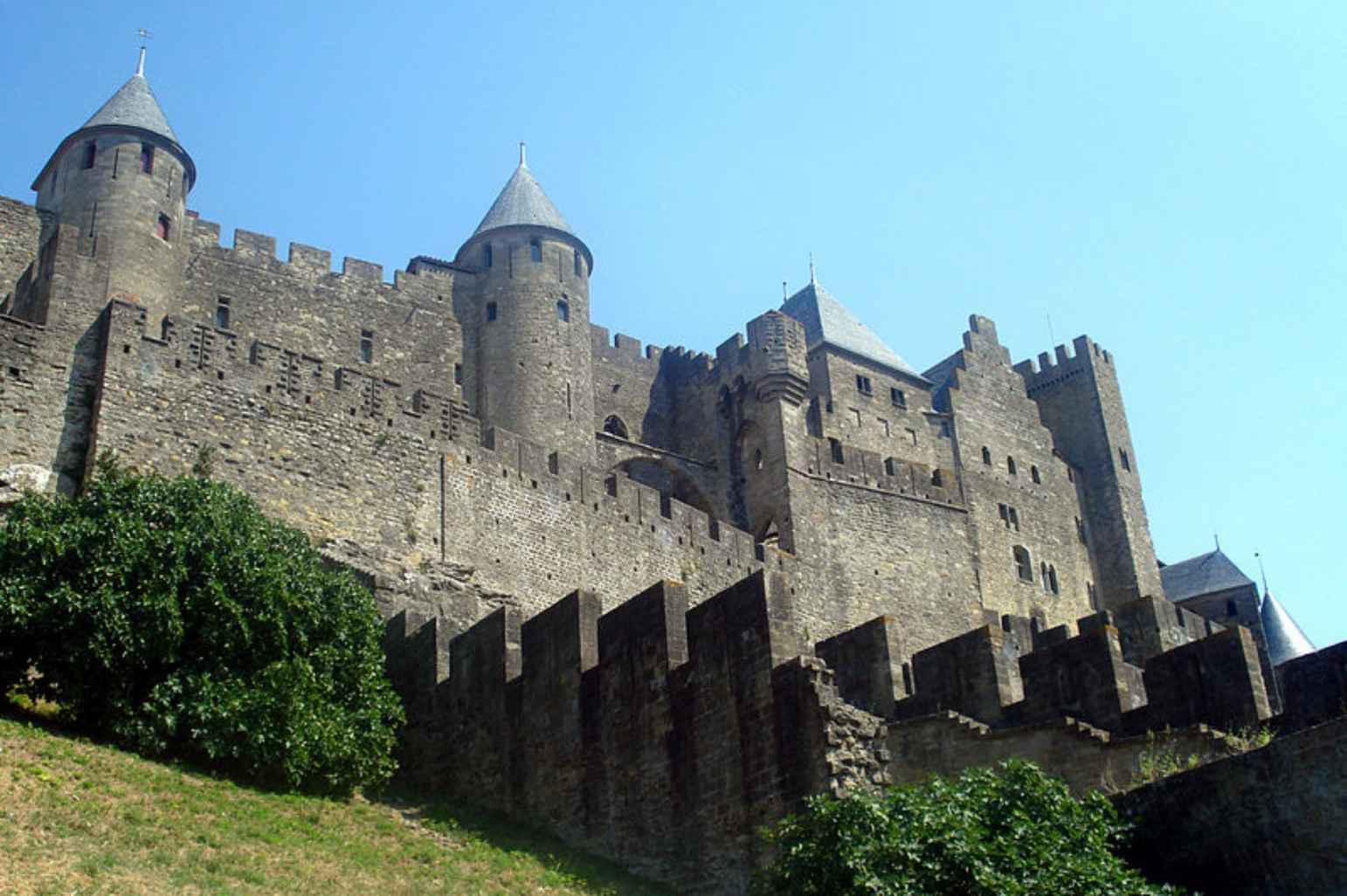
A picture of the fortified wall
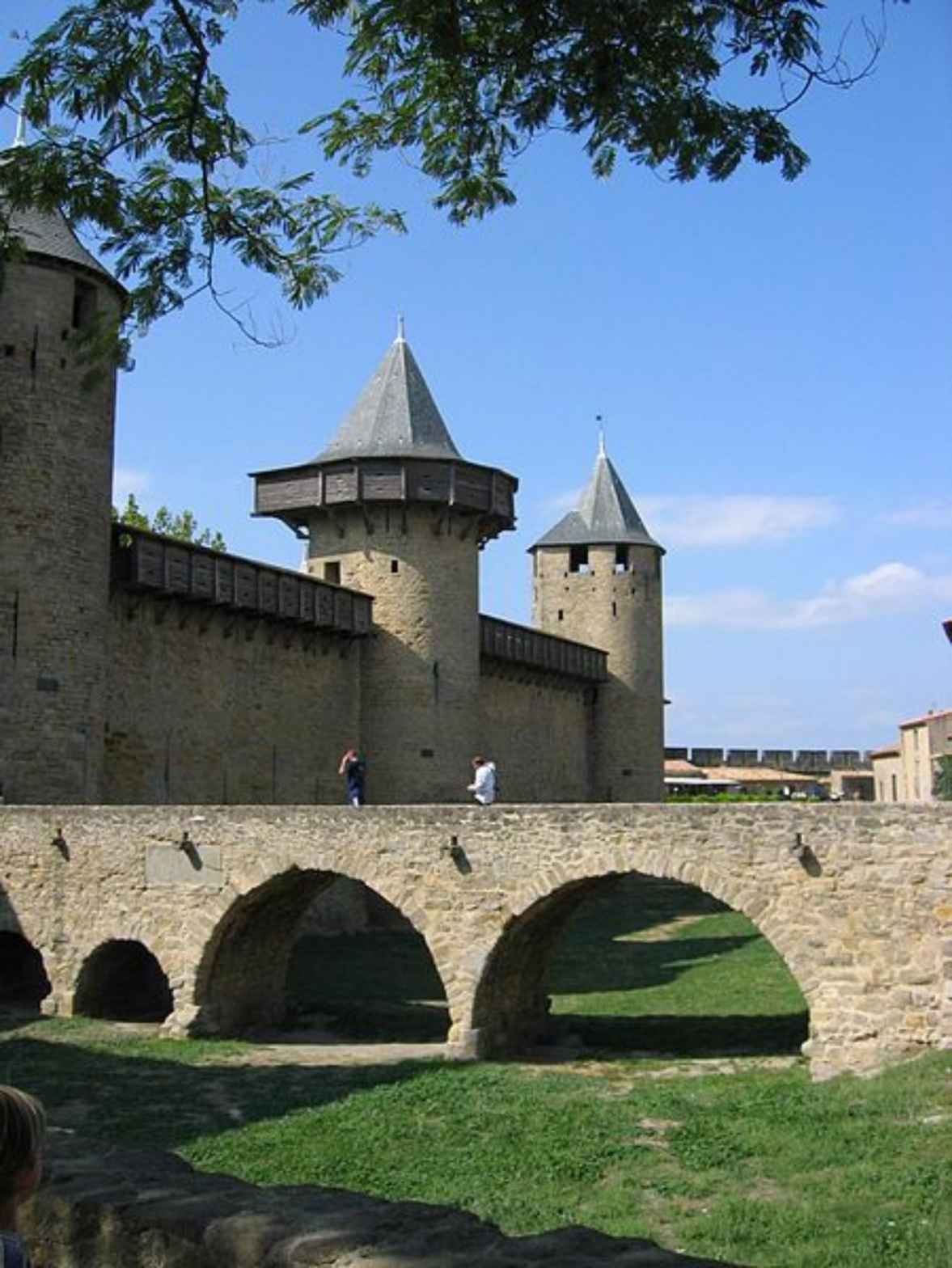
A picture of a reconstructed hoarding at Carcassonne
The Cité was also split into 16 châtellenies, or lordships. Each châtelain was to guard 1 or 2 towers, as well as the parts of the bulwark that flanked the towers in question. A pair of boroughs, Saint Michael and Saint Vincent, each a component of the 16 châtellenies, were established just outside the Carcassonnian borders. Inhabitants and soldiers stationed there were also expected to maintain the castles and defenses assigned to them for extra security.
The Origins of the Cathars
“We must no more ask whether the soul and body are one than ask whether the wax and the figure impressed on it are one.” – attributed to Aristotle
Nestled within an evergreen grove blanketing the crest of a hill 4,000 feet above the Montségur village stood its namesake – a strapping, sandy-beige fortress guarded by imposing walls and capped with a melange of gable and conical roofs. From below, there was little one could see of the colossal castle, or as the locals called it, the Château de Montségur, perched upon the round boulder of a hill. Not only was it half-hidden by the hill's natural formations, what was visible blended in with the naked rock, so that it appeared no more than a distinctive stone protuberance jutting out of its pinnacle. But if one were to lean against the parapet in the highest point of the castle, one would be treated to a panoramic view of the lush valleys and countryside of the Ariège, along the Pyrenees, the Montagne Noire (Black Mountain), and even parts of Toulouse.
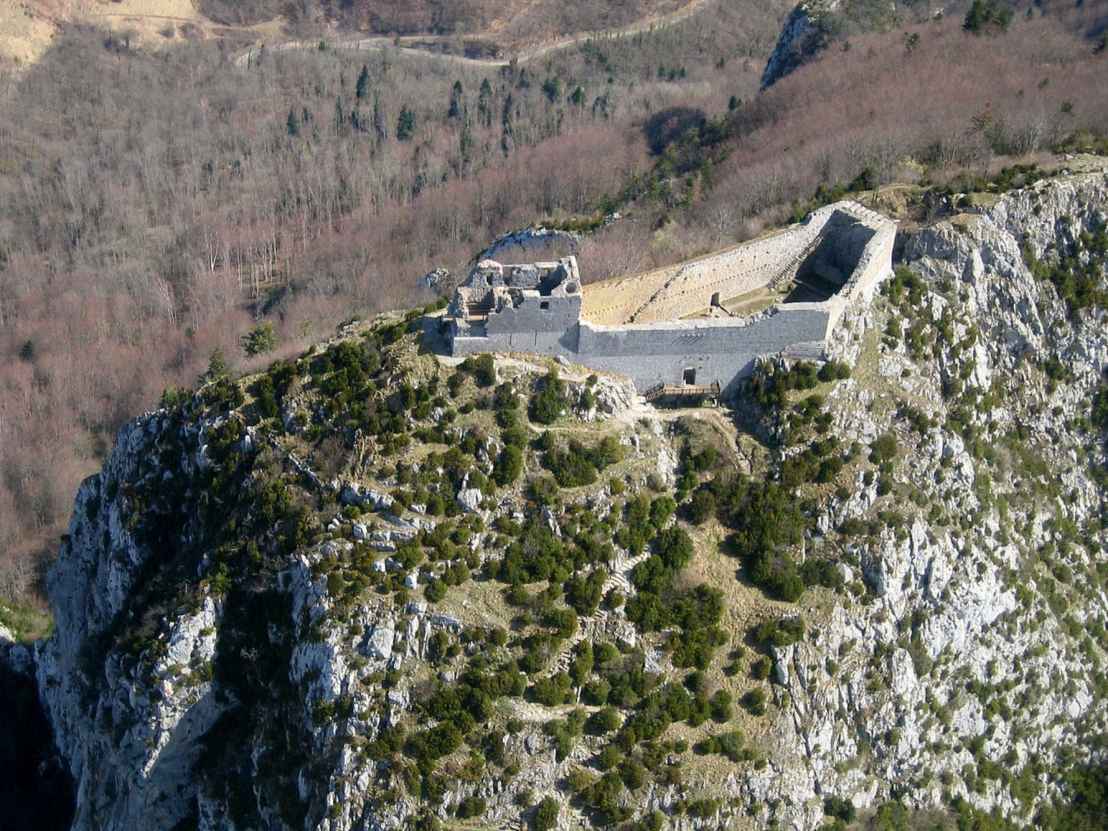
M. Danis’ aerial picture of the Château de Montségur
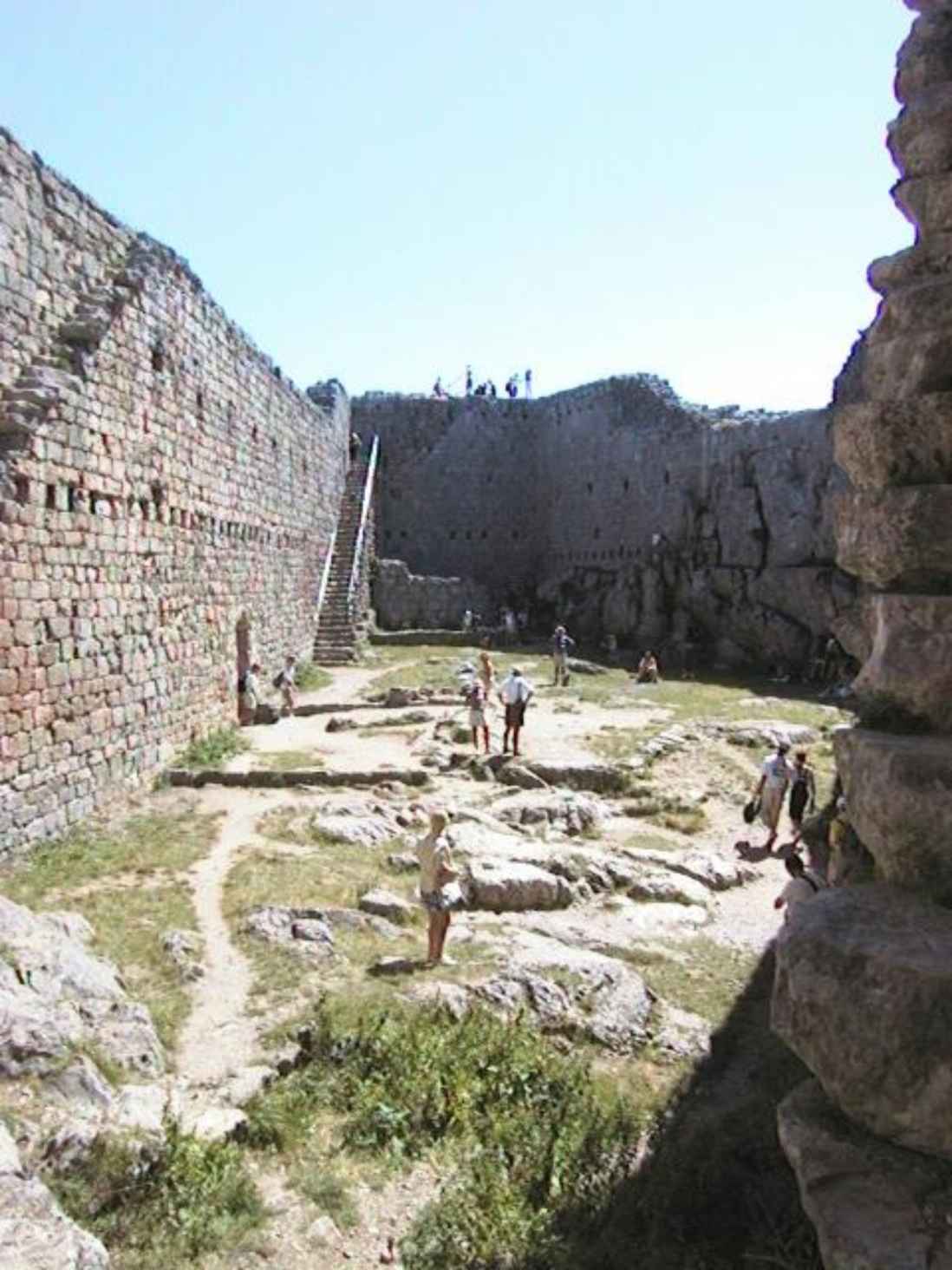
The courtyard
It was a particularly pitch-black evening on the 16th of March, 1244. The dainty breeze of the approaching spring caressed the mossy walls of the castle. The vibrant wildflowers surrounding the structure swayed slightly with the wind, but otherwise resembled static fireflies hovering above the grass. This scene would have been pretty as a picture had it not been for the discordance of tumbling targets, whizzing projectiles, and other telltale signs of a siege in the distance. Critters usually seen scurrying about freely were cowering in their burrows. Even the stars that usually ornamented the twinkling sky were nowhere to be seen, as if shrinking from the horrors that were unfolding below them.
There was movement inside of the castle, inhabited by some 300 people, but curiously, it was not one of alarm, nor of urgency. Some shuffled about aimlessly by their lonesome, their eyes glazed over and their faces void of expression. Families and loved ones were huddled in corners, their eyes squeezed shut as they muttered last-minute prayers under their breaths. Others were locked in an embrace, whispering words of comfort to their pale-faced companions.
They were cold, numb, and frightened, but there was a haunting sense of peace in the air, for most had resigned to their irreversible fates. They had only mere minutes, perhaps even seconds, to make the life-changing decision looming over them. Were they going to renounce their beliefs and everything that they stood for, or were they willing to become martyrs of what they trusted to be the one true faith?
As these wretched souls awaited their impending doom, however, a band of 3 or 4 elders, accompanied by a local guide, silently headed for the ramparts in the rear of the castle. Cloaked in scratchy woolen blankets, the men pussyfooted to the sturdiest parapet, knotted some sheets around the merlon, and braving the height, rappelled down the side of the wall. They then scampered over to the nearby promontory, and using their sheets, shimmied down to the Lasset gorge.
Not long after they hit the ground, a group of mysterious, similarly cloaked men, faces concealed in their hoods, emerged from the shadows. These were common vassals from the nearby Canton of Sabarthès, who claimed to be the “Sons of the Moon,” more precisely, of the moon goddess, Belissena. Though not a word was exchanged between them, each party knew what was expected of them.
With the tick of the proverbial clock ringing in their ears, one of the elders fished out a parcel tucked inside of his cloak, and handed it over to the vassals. And with not a second to spare, the parties parted ways, away from the stampede of soldiers descending to the gorge. The vassals, the new guarders of this priceless treasure, scuttled back into the shadows. The elders, on the other hand, scaled the cliff side and ducked into one of the hundreds of caves in Sabarthès, never to be seen again.
These elders, along with the rest of the unfortunate souls trapped inside the fortress, were none other than the Cathars, and those soldiers were the underlings of the Roman Catholic Church.
Exactly what this priceless treasure was – as well as its existence – continues to be a matter of debate. Some say it was a green jade bowl that possessed otherworldly powers, or maybe, quite literally, just a chest brimming with gold, silver, jewels, and other glittering valuables. Some claim it was a cryptic manuscript comprising the esoteric teachings and other secrets of the Cathars, one so expertly stowed away that it remains missing. Some are convinced that the treasure was of far more significance, one so significant, in fact, that the search for it is one that still persists to this day.
Others insist that it was the fabled Ark of the Covenant that the Cathars handed to the vassals. This 3,000-year-old Biblical artifact, constructed by the Israelites, was believed to be a splendid wooden case coated in gold and garnished with a pair of gilded angels, containing the original stone slabs of the 10 Commandments. It was by some miracle that the Cathars were able to lug that hefty chest all the way down to the gorge.
Then comes what is by far the most popular theory, which identifies the treasure as the Holy Grail. It is an opinion so widespread that Château de Montségur has unofficially been dubbed the “Holy Grail Castle.” The Grail in question, still prevalent in modern pop culture, belonged to Christ during the Last Supper, and it was the same chalice Joseph of Arimathea used to bottle the blood of the crucified Christ. Like the sacred Ark, the Grail is often associated with miracles and other supernatural occurrences, such as the feeding of 4,000 with a dozen loaves of bread, and a sinkhole that consumed a disobedient relative of Josephus (son of Joseph of Arimathea), amongst many others.
Whether or not this treasure exists is up for debate, but the atrocities directed toward the Cathars that very evening, as historical records show, cannot be denied. Of course, this begs the question of why the Catholic Church was so determined to annihilate them.
Since most, if not all the Cathar texts were torn to shreds by the Church, their origins can only be left up to speculation. One of the lesser-known etiological myths revolves around Jesus and alleged reformed prostitute, Mary Magdalene, who is oftentimes depicted with an alabaster jar for having famously bathed the feet of Christ with Nardus oil. Following the death and resurrection of Christ, the 12 apostles scattered themselves in all directions to faraway lands, traveling as far as what is now modern day Turkey and India. In the year 44, Mary Magdalene herself was charged with conspiracy against the Roman sovereigns and shunned from her homeland. The road ahead was daunting, but Mary's resilient spirit remained unshaken.
As the Gospel tells it, it was Mary who instilled in the disciples the boundless courage needed to complete their mission. The disciples asked, “How shall we go to the Gentiles and preach the Gospel of the Kingdom of the Son of Man? If they did not spare Him, how will they spare us?” Without missing a beat, Mary sprung up to her feet and commanded her brethren, “Do not week and do not grieve, nor be irresolute, for His grace will be entirely with you, and will protect you.”
The legend continues with an unmarked, shoddily made ship sans sails and oars drifting towards and eventually running aground a shore in southern France. One by one, Mary Magdalene, Mother Mary, and her sister, Mary of Clopas piled out of the ship, followed by Lazarus, Martha, and a servant girl named Sarah. The site of their landing, the capital of the Camargue, is now aptly known as the “Saintes Maries-de-la-Mer,” or in English, the “Holy Marys from the Sea.” Endowed with the honorable task of spreading the word of the Lord, each one of them started towards, and eventually set up camp in a different region of France.
Catholics suggest that Mary Magdalene wound up in the Roman region of Provence in southeastern France, where she reportedly converted all its inhabitants, including the royal family, to Roman Catholicism in no more than 24 hours. She then retreated to the sacred woods now called the Sainte Baume and found shelter inside a cave in the thick of the forest, where she spent the remaining 3 decades of her life. Subsisting on nothing but the bread of the Holy Eucharist, provided to her every day by visiting angels, Mary spent every waking hour either in deep prayer or meditation. Once she took her last breath, the angels swooped into the cave and removed her body.
In the Cathar version of the tale, Mary Magdalene did not end up in Provence but in historical Rennes-les-Bains in what is now Occitanie in southern France. More importantly, according to the Cathars, Mary was not alone; traveling with her was Christ himself, who never died from the crucifixion. As the story goes, Mary crept into his tomb 40 hours after his “death,” and together, the pair were secretly whisked away to France.
The Cathar edition also advocates an age-old conspiracy theory that Jesus and Mary Magdalene were husband and wife. Some say that the pair resided in a humble cottage on a hilltop, while others maintain that they lived right in the heart of the community, preferring to live close to those whose hearts they aimed to touch. Rumor has it that some of the townspeople had even chanced upon them in the marketplace and other parts of town, with a few of them swearing that they had also made small talk with them.
Evidently, the pair did not merely adopt the title of husband and wife to fool the townspeople regarding their true identities. The Cathars asserted they then became parents to at least 3 children, two sons and a daughter. The pair lived simply and piously in their cozy cottage until they received word of the townspeople's growing suspicions and interest in their pasts.
It was then that the couple chose to split up. Mary brought with her one of their sons and made the trek up north to what would become Languedoc (the County of Toulose). Joseph of Arimathea was summoned to collect their other son, after which he was dispatched to England. Lastly, Jesus, along with their only daughter, opted to relocate to a more remote residence in the countryside of Rennes-le-Château.
When the hallowed children came of age, they were instructed to go out into the town and preach to the locals the revised doctrine, which gradually evolved and branched out into an array of religious sects and organizations, such as the Essenes, the Knights Templar, and the Cathars. The sons also spawned the bloodlines of the later ruling Arthurian and Merovingian kings in their respective regions. As such, those who propagate these stories say it was the family tree, authentic records, and other proof pertaining to the “perpetuation of the Jesus bloodline” bequeathed to the Cathars that the priests entrusted to the vassals for safekeeping.
While these myths are certainly intriguing, the majority of historians believe that Catharism most likely stemmed from millennia-old Gnostic religions from the East centered on “Dualism.” As Bishop Walter Mapp, author of De Nugis Curialium (“Trifles of Courtiers”), put it, “Everywhere among Christians [the Cathars] have lain hidden since the time of the Lord's Passion, straying in error.”
But even the concept of Dualism itself transcends the birth of Christian Gnosticism, said to be founded by Valentinus of Carthage in the 2nd century CE. The “radical opposition of spirit and matter, good and evil, male and female,” as English historian Steven Runciman explains, is “as old as mankind.” For instance, there are the harmoniously contrary, yet parallel forces of the yin and yang in Taoism, which bears no link to Christian Gnosticism. The phenomena of good and evil, as well as the conflicting idea of a benevolent God and the evils of material existence, have also been tackled by a host of ancient philosophers, such as the Greek Stoics, Hermetic thinkers, and Jewish scholars from Alexandrian times.
Chroniclers have now concluded that it was from the religion and beliefs of the Bogomils in the Balkans that Catharism descended. The Bogomils were inspired by the Paulicians of Armenia, the latter especially prominent in ancient Armenia between the mid-7th century to late 9th century CE.
The Gnostic Paulicians, in turn, borrowed much of their creed from Manichaeism. Manichaeism, the brainchild of a Persian aristocrat known only as “Mani,” was instituted sometime in the 3rd century. The Babylonian sect hosted a distinctive bilateral hierarchical system composed of the Elect, which was a body of high-ranking spiritual leaders selected by the clan, and Hearers, the stock members of the group. The belief system of the Manichee, which guaranteed salvation through the spiritual knowledge passed down by Mani, was an amalgam of Gnostic Christianity, Zoroastrianism, Taoism, and a slew of other mystical theologies, its multifaceted character attracting both admirers and critics.
According to its designer, there are two “natures” that have ruled the earth since the beginning of time – light and darkness. On the one hand, the kingdom of light is marked by serenity and peace of mind, whereas the domain of darkness is in endless war with itself. The creation of the universe, as the designer asserted, was a product of these clashing elements.
Given that stiff discipline was among the core values of the Manichee, members were expected to abstain from swearing, and they were to be strict vegetarians. Their equal treatment of women, which was highly uncustomary at the time, was another norm shattered by the clan. Women, too, could be appointed as members of the Elect.
The Paulicians, another dualist sect, also promoted the belief of two primary forces: good and evil. As the material world was believed to have been a consequence engendered by evil, the Paulicians pledged to distance themselves from all material and carnal pleasures, and shed all vices. Thus, all members swore off meat and alcohol, and vowed to live a life of celibacy.
Much of the information about the Bogomils that exists today is potentially skewed, for the bulk had been gathered by their opponents, i.e., Christian Churches. It is believed that Bogolism came to the fore in the Balkans (now Bulgaria) in the middle of the 10th century, bred by the sect's creator, a priest named Bogomil. The Interrogatio Iohanni, the only Bogomil literature known to have survived, preaches a belief system closely aligned with Manichean and Paulician principles in terms of asceticism and dualism.
Contrary to the aforementioned persuasions, the Bogomil belief system relied heavily on Christian themes. Bogomil intended for them to hark back to the earliest, and therefore “purest” form of Christianity, before the rise of what they deemed the increasingly tyrannical Roman Catholic Church. Members were educated about the Gnostic notion of Docetism, which saw Christ as solely a celestial being; this meant that Christ never physically existed, and that his trials and sufferings on earth may have been allegorical. The world, the Bogomils believed, was not an invention of the “God of Light,” but His rival, the wicked “Abrahamic God.” They rejected crosses and crucifixes alike, and preferred to conduct their rites amidst nature.
It was in the early 1000s that Bogomilism spread to the Byzantine lands, where they grew and soon blossomed. They would have an exceptionally notable presence in Constantinople; in fact, by the end of the century, this “heretical” cult had become so regionally predominant that local leaders, threatened by their influence and proliferation, authorized a brutal campaign against them, a tactic employed by various leaders throughout history. In the year 1118, a ring of Bogomil clerics were rounded up, found guilty at trial for the crime of heresy, and sentenced to death by Emperor Alexius I Comnenus. Among those executed was Basil the Physician, head of the Bogomils.
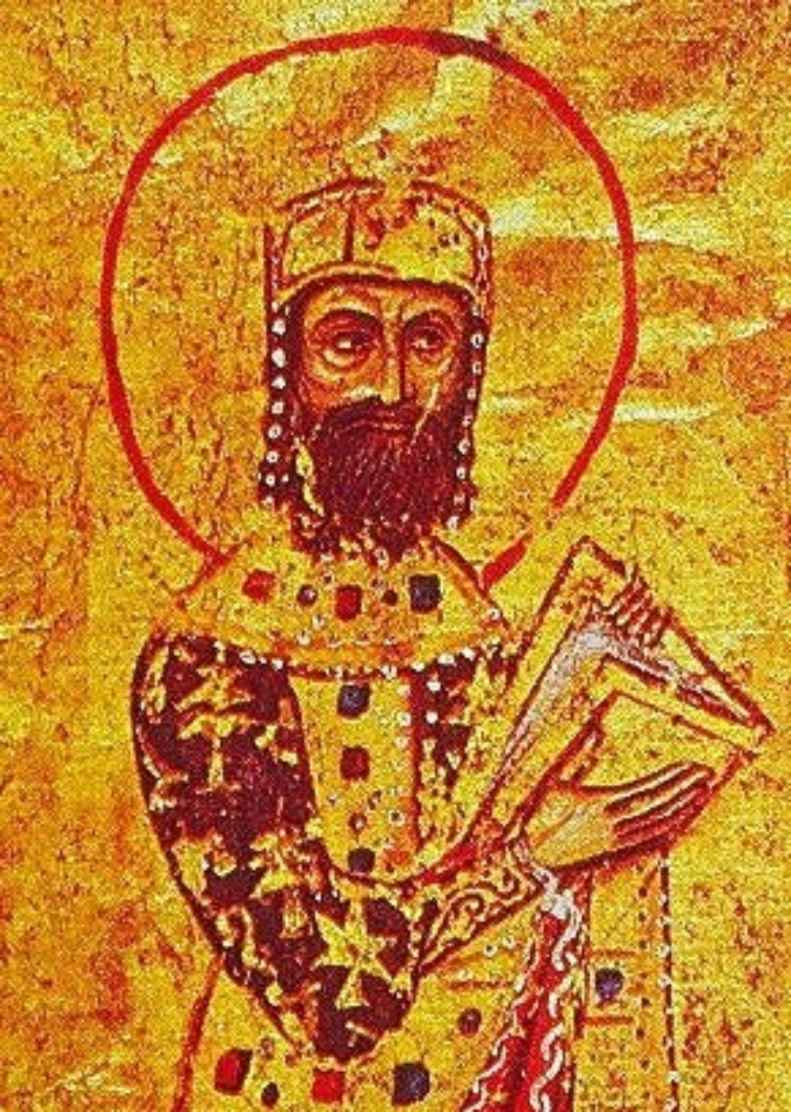
A contemporary portrait of the Byzantine emperor
In spite of the marked resistance against them, Bogomilism continued to flourish, even extending their reach to Serbia and Bosnia before it was flushed out by Islam following the fall of Constantinople in the 15th century.
Bogomilism made its way to northern Italy by immigrant charcoal burners and other societal outcasts. Through word of mouth, it was then peddled by traveling merchants and Gnostic preachers to civilians in neighboring and distant Italian villages. Their operations naturally shifted to southern France, brought to the region by an unnamed Italian woman, and later, to the villages in northern Spain.
The Bogomil movement was greeted with unexpected warmth and met with surprising success in France. Their fruitfulness was such that more and more converted Bogomils began to discuss and dissect its constitution, which gave way to the advent of an allied, but separate school of thought. It was then that a new denomination, which came to be known as “Catharism,” was established. Though the Bogomils and Cathars often held different and sometimes outright contradictory opinions on certain doctrines, the relationship between the sister sects was an amicable one.
As opposed to the other dualist religions, the muse behind the name of the Cathars has not yet been determined. Some say that the name was directly lifted off an older, but then extinct (or perhaps the true predecessor of) sect called the “Cathari,” derived from the Greek word “katharoi,” which translates into “the pure ones.” In the book of St. John Damascene, On Heresies, he makes a reference to the sect: “They absolutely reject those who marry a second time, and reject the possibility of penance [that is, forgiveness of sins after baptism].”
The Ecumenical Council of Nicae, which convened in 325 CE, makes another direct mention of this controversial sect in Canon 8: “...if those called “Cathari” come over [to the faith], let them first make profession that they are willing to communicate [share full communion] with the twice-married, and grant pardon to those who have lapsed...”
Allusions to the new-age French Cathars in literature were first made in 1143. A new brand of heresy had been introduced to France by foreign sacrilegious renegades, warned author Everwinus of Steinfeld, who pushed wildly unorthodox theories from Greece that distorted unquestionable Catholic principles. But it was only 22 years later that Eckbert von Schönau mentioned them by their designation, the “Cathars,” and elaborated on their dualist beliefs.
The first known complaint lodged against the Cathars by a “concerned” layman was filed in 1177. In a letter addressed to a Cistercian abbot, Count Raymond of Toulouse seeks advice on how best to handle the irreverent “two-principled” heretics that had been running amok in his city. As a result of Raymond's report, a number of accused Cathars were interrogated and duly punished.
By then, the war against the heretics in these parts was nothing new. Toulouse, along with the other localities between the Rhone and the Pyrenees, had been rife with tensions between the Catholic Church and the so-called heretics for hundreds of years. Gnostic sects that labeled Jesus as a mortal prophet and challenged his divinity, such as the Manichee, Bogomils, and Cathars, aroused the most contempt from the Catholic Church, and were among the first names on the establishment's blacklist.
From northern Italy and southern France, Catharism spread to the north of the kingdom. When the strongholds erected there began to flourish in the mid-1100s, the movement traveled further north to the Rhineland cities, gaining remarkable traction in Cologne. But it was in Languedoc that the Cathars truly found their footing, considered by many to be one of the first nerve centers of the community. Indeed, their operations there were so productive that by the end of the 1100s, a majority of the formerly Catholic citizens had converted to Catharism.
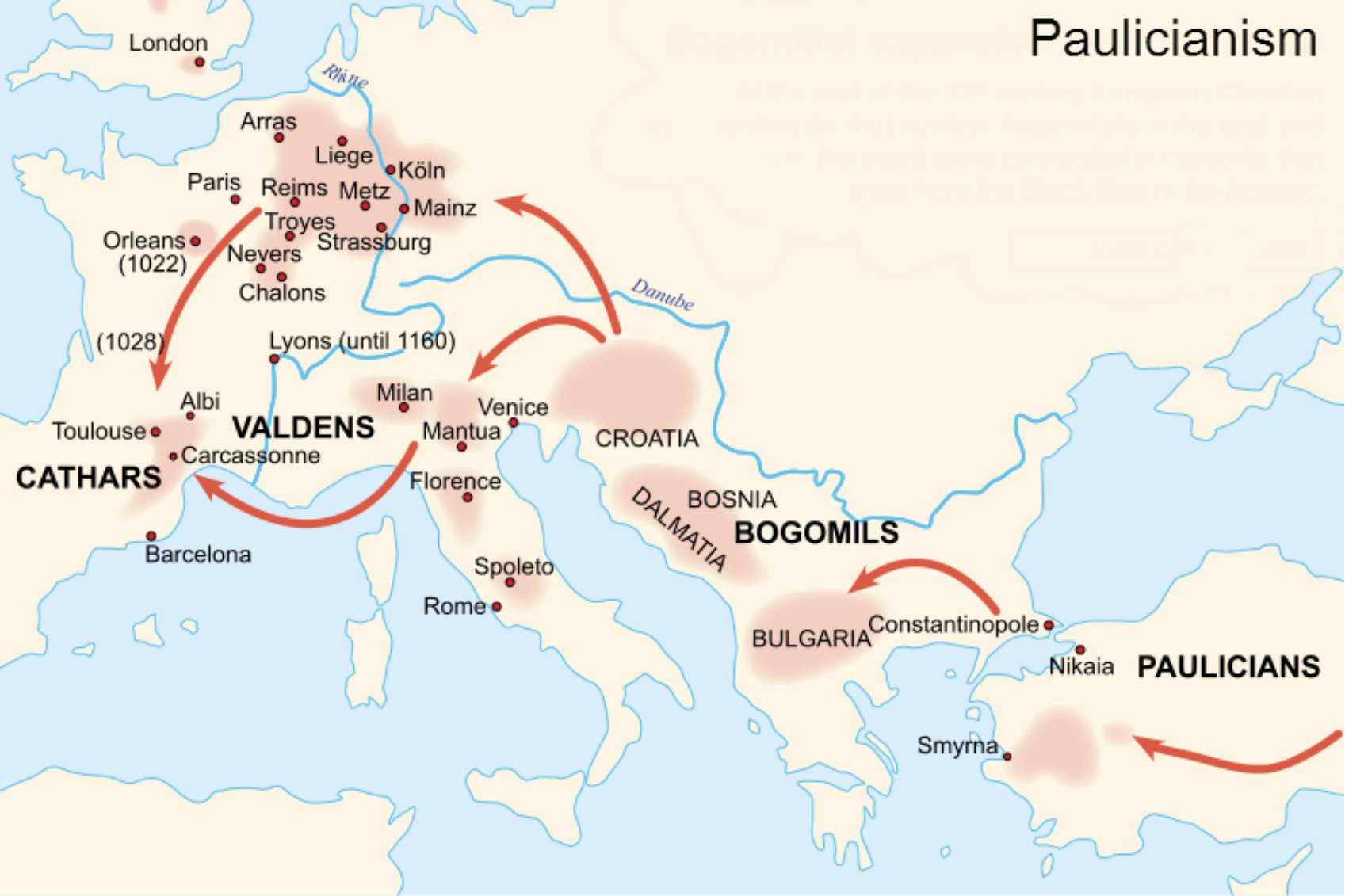
Leo Freeman’s map of the spread of the sect
Though this new variety of Catharism remained absent from literature until halfway into the 12th century, its members and their ancestors had already endured grievous injustices and abuse at the hands of the Catholic Church for at least more than a century beforehand. Between the years of 1018 and 1028, suspected Cathars, lumped together with the local Manichee by ignorant Church authorities in Aquitaine and Toulouse, became subject to extreme scrutiny. On the 28th of December, 1022, the Feast of the Holy Innocents, 13 Cathar/Manichee elders were arrested in Orléans and condemned to death for their unconventional views on marriage and idolatry, amongst other beliefs. Many incongruous and unfounded yet accepted rumors about the cult's practices, which included members partaking in devil worship, orgies, excessive boozing, and other debauchery, solidified the verdict.
In medieval Europe, one's style of execution was dictated by their crime. Thieves, for example, were sent to the gallows. Adulterers and prostitutes were punished in biblical fashion, and stoned to death for their sins. Those who murdered children were impaled by stakes, their corpses later displayed to the public like trophies. Counterfeiters and con artists were thrown into a vat of bubbling oil and boiled to death. Assassins found guilty of regicide were drawn and quartered.
Death by fire, as it turns out, was a dreadful punishment made exclusive to the heretics. While clearly a needlessly excruciating and traumatic means of execution, it was marketed by the Church as a way to reverse the evil in these “corrupt” souls, as well as to prevent their depravity from infecting the good Christian public. Only by fire, declared Church authorities, could the “smallest trace of sin...and evil” in the ungodly dissenters be thoroughly eliminated. Even the bodies of those who had died of natural and other causes but were posthumously proclaimed as heretics were exhumed and cremated. What's more, the incineration of the heretics' corpses ensured that they would never find the eternal salvation promised to obedient, God-fearing Catholics, for a proper burial was required for resurrection.
The Church leaders at Orléans were set on making an example out of the audacious dissenters. One by one, the shackled prisoners limped in single file to their site of execution as a mob of jeering bystanders pelted them with rotten fruit. Even the queen herself, Constance of Arles, took part in the riotous behavior, ramming her staff into the eye of a passing Cathar named Stephanus. The condemned were marched into a menacing wooden building at the end of the road. All doors, windows, and possible exits were then sealed shut, and the entire building was set ablaze.
An excerpt from R. I. Moore, author of The War On Heresy: Faith and Power in Medieval Europe, paints a chilling picture of the events: “[W]hen the flames began to burn them savagely, they cried out as loudly as they could from the middle of the fire that they had been terribly deceived by the trickery of the devil, that the views they had recently held of God and Lord of All were bad, and that as punishment for their blasphemy against Him, they would endure much torment in this world, and more in that to come...” The cries of the roasting victims were so distressing that a few rushed forth in a futile effort to extinguish the roaring flames, until they finally accepted that like all the doors and windows on the burning structure, their fates were sealed.
The horrendous events of the 28th of December provided a macabre milestone in European Christian history, for they were supposedly the first burnings of heretics since the 500s. As it turned out, the worst was yet to come.
Creed and Convictions
“But we impart a secret and hidden wisdom of God, which God decreed before the ages for our glory.” – 1 Corinthians 2:7
In order to better understand the tempestuous relationship between the Cathars and the Catholics, it is best to analyze the former's nonconformist belief system.
For starters, not only did the Cathars argue that their belief system predated that of the Roman Catholic Church, they maintained that they were “good Christians,” which their rivals saw as not just an implication, but proof of the Cathars' supercilious and profane character. Likewise, the Cathars seemed to make no attempts at masking their distrust and loathing of the Catholic Church, which they thought had consciously strayed from the customs and practices of the “Early Church” and generated a conniving and iniquitous system that indulged only the needs and wants of those at the top of the pyramid.
To the Cathars, traditionally classified as Christian Dualists, the “Good God” created, and as such, presides over all that is pure and intangible, meaning all souls – earthly and otherwise – light, love, kindness, and so on. The human race consists of ageless, recycled souls, or as the Cathars called them, “divine sparks.” Humans, they claim, are no more than “sparks” or “angels” trapped in vessels of flesh. There were some who believed that the stars they saw strewn across the night skies were other “divine sparks” in heaven, watching over the flock on Earth.
The malevolent God, or simply, “Bad God,” the creator of the universe and all the evil inside of it, ruled over these domains. It was he who had hatched the plan to abduct these divine sparks from Heaven, and confine them in fleshly bodies, each made to carry out the agonizing sentence of life in this wicked world. To further frustrate the attempts of the divine sparks to return to the realm of the benevolent God, His counterpart implanted the sin of lust into each one of them, encouraging the procreation of more fleshly prison cells.
Bearing this in mind, the Cathars, like their many forerunners, championed constant prayer and abstinence from all earthly desires, which they believed are the only ways to conquer the diabolic plans of the malevolent God. Even so, piousness and religious restraint are not enough to stave off the evil God; one must possess the strength to withstand external “tortures,” such as natural disasters, sickness, famine, and war, not to mention a learned immunity to other temptations presented to them by their peers.
The Cathars’ creation myth is summed up in the following excerpt, borrowed from the Interrogatio Johannis (“The Questions of John”), believed to be one of their only surviving texts: “And still I, John, questioned the Lord, saying, 'Lord, how did man have spiritual origin in a carnal body?' And the Lord said to me: 'By their fall, spirits of heaven entered the female body of clay, and took on flesh from the lusts of the flesh, and took on [spirit at the same time]...Spirit is born of spirit, and flesh of flesh; and thus, the reign of [the Bad God] ceases not in this world...”
Operating under this logic, the Cathars vocally opposed and detached themselves from the Old Testament, selecting only the second half of the holy book – in particular, the Gospel of John – as their Bible. The Old Testament, they believed, was an undeserved tribute to the malevolent deity. They could not comprehend how one was to bow down before such a cruel and vengeful god, the destroyer of Sodom and Gomorrah and the orchestrator of the terrible flood, who tested his subjects in sadistic fashion; for instance, Abraham, asked to sacrifice his son to God in a show of loyalty. They even went so far as to preach that all patriarchal figures found in the first half of the Bible were “demons” and the sycophantic stooges of the evil God, the greatest of them all being John the Baptist. It was for these reasons that they unequivocally rejected the Old Testament, barring the Ten Commandments.
The antithetical perspectives on Jesus and the Blessed Virgin Mary also led to arguments between the rival Christian faiths. They refuted the virgin birth, stating it was impossible for any mortal to harbor such powers. Instead, Christ, they said, was conceived naturally by Joseph and Mary, and was only “adopted” as God's son following his baptism. In the same breath, they dismissed the idea of the Holy Trinity, for they saw Jesus as his own separate entity, brushing it off as a concept fabricated by the Catholic Church.
While the product of a natural conception and birth, the Cathars' somewhat convoluted delineation of Christ clarifies that he was never mortal, for everything sheltered by skin and muscle is tainted by impurity and could only have been contrived by the malevolent God. Rather, Christ was a spectral being that lived among humankind and endeavored to show them the light of the Good God. This being the case, it was deduced that Christ had never died on the cross, and more importantly, he was never resurrected from the dead, for in doing so, one would require an actual, physical body.
While they were non-believers in the concept of resurrection, the Cathars subscribed to the idea of reincarnation. Upon death, one's soul floats out of one's body, and immediately enters an empty “lodging of clay,” which came in seemingly boundless forms, ranging from the embryo in a mother's womb to the slimy egg of a fruit fly. Only those who have lived lives that met or exceeded the standards of the benevolent God were granted permission to return to the Divine Kingdom. Those who neglected or abandoned the path of righteousness were cursed to this perpetual “cycle of rebirth” in this Good-godforsaken planet until they finally decided to alter their lifestyles.
There is an amusing story about a Cathar elder in the usually dismal Inquisition records kept by the Catholic Church regarding this theme. To the annoyance of his guards and interrogators, the elder, a babbling fount of chitchat and never-ending tales, often deflected the line of questioning with anecdotes about one of his past lives as a merry horse. The elder was quoted as saying, “When I was a horse, one night I lost my shoe between 2 stones, and I went on unshod the whole night.”
Eberwin von Helfenstein, the Prior of the Premonstratensian Monastery in Steinfeld, Germany, inserts an official statement allegedly issued by the Cathars in a letter to St. Bernard of Clairvaux in 1143, essentially a self-assessment conducted by the persecuted group: “Of themselves they say: 'We are the poor of Christ, who have no fixed abode and flee from city to city like sheep amidst wolves, are persecuted as were the apostles and the martyrs, despite the fact that we lead a most strict and holy life...We undergo this because we are not of this world...We and our fathers, of apostolic descent, have continued in the Grace of God and shall so remain to the end of time...”
The emotive constituents of their belief system allowed the Cathars to justify their many customs. As sexual intercourse, even and especially for the purpose of recreation, yielded more and more “vessels of clay” for the use of the malevolent God, the act, along with marriage itself, was prohibited. Some Cathars, however, understood sex as a natural human desire, and while they still advocated abstinence from marriage, which they considered a “worthless” institution, and procreational sex, they tolerated recreational intercourse, and supported birth control. As the widely-circulated medieval colloquialism goes, “Si non caste tamen caute,” or in English, “If not chastely, at least cautiously.”
Needless to say, contraceptives at the time, which included the consumption of pomegranates, were in vain, and recreational sex was accordingly still riddled with risk in the Cathars' eyes. On the other end of the spectrum, the Catholics, strictly pro-life, blasted the use of contraceptives. As it so happens, contraception was so reviled by the Church that the act warranted a charge in itself. A 14th century file from the Inquisition archives profiles a French Cathar woman, Beatrice de Planissolles, who was found guilty of the act, along with her unnamed lover, a Catholic priest from Montaillou.
It was in humanity's best interest, the Cathars believed, to remove themselves from all things material, namely anything that brought one any level of pleasure, no matter how negligible. Not unlike their sister sects, the Cathars voiced their disapproval on the ingestion of all animals and animal products, for apart from the taste of their sinfully delicious meat, in doing so, one was eating a fellow divine spark. Interestingly enough, some Cathars were pescatarians, for they believed fish to be soulless creatures, and as such, perfectly fit for consumption.
The Cathars distanced themselves from all tangible material objects, for they are crafted by mankind, derivatives of the malevolent deity. On top of the obvious – that is, money, jewelry, expensive clothing, and so forth – the bread of the Eucharist taken by the Catholics, as well as all crosses, crucifixes, statues, and buildings depicting or dedicated to God, Christ, and other biblical figures, were anything but worthy of veneration. The Christian cross was, to them, by far the most puzzling of all the listed items, for this was to them a torture device. Anyone who worshiped such idols and observed such perversions of God's word were undoubtedly currying favor with the wrong God.
The Catholic Church, whom the Cathars nicknamed the “Church of Wolves,” was guiltiest of all when it came to the sin of materialism. The Catholic hierarchy, they claimed, stank of corruption. The Pope, unjustly vested with authority that was comparable to, if not greater than the monarchs of the time, was the wealthiest man in the whole of the continent. Below him on the totem pole were the cardinals, bishops, and priests, who were often seen strutting about in flamboyant, costly robes, and chastised for their luxurious lifestyles, filled with fabulous feasts, opulent homes, and even bevies of women.
Worse yet, they insisted, the Catholic Church was running an intricate and inextricable, but to their credit, well-guarded scam on well-meaning, but clueless Christian folk. The Cathars were not shy about pointing out what they saw as illogical flaws and discrepancies between the Church's teachings and that of the benevolent God's. They equated the “holy water” peddled by the Church, for one, with river water, and the Holy Eucharist with store-bought bread. They not only questioned the instruments of the Church's way of baptism, they denounced their shoving the sacrament down the throats of infant and children, for they believed that only at the age of 18 could one decide whether or not they wanted to commit themselves to God.
Among the most disgraceful of the Church's crimes was its supposed exploitation of followers, both rich and poor. Besides the substantial tithes imposed on the public – which saw every citizen coughing up 10% of their annual incomes, lest they be excommunicated by their priests and bishops – the Church encouraged donations from affluent patrons, which were used to fund top officials’ lavish lifestyles. The Cathars also despised the Catholic Church's hawking of burial plots, advertised as one of the only tickets to Heaven. This was another despicable way of preying on the poor, as many found themselves suffocating under the weight of their mounting debts, all for a coveted slot in paradise.
Moreover, the Cathars strove to destroy the credibility of the Catholic priests. As these priests did not abide by the laws of the “Early Church” and were thus terrible sinners themselves, they were not certified to hear confessions, much less forgive them, nor did they have the power to heal the sick through their meaningless oil.
The Cathars attributed much of the Catholics' faults to their pecking order. This being so, the Cathars had no such system, nor did they have a priesthood. There were only two classes of membership within the Cathar order – the credentes, a term given to a standard practitioner of the faith, as well as an inner circle of elites the first Cathars called the “boni homines,” or “good men.” Later generations referred to them as the “parfait,” or the “perfecti” – in English, either “Cathar Perfects,” or just the “Elect.”
Though only the Perfects were privy to the cult's deepest secrets, and only they who could perform Cathar ceremonies, they made certain never to identify themselves as priests. They were more so a clique of enlightened elders, humble teachers, and faithful missionaries, they claimed, than they were insipid and mindless distributors of a distorted creed. And while the Cathars detested all hierarchies, all entities require some organization to function. The Elect was strengthened with a cabinet of Perfects, all armed with equal power, known as the episcopos. While the word itself meant “bishop,” again, they were more akin to the episcopos mentioned in the New Testament, which doubled as “supervisor.” Cathar episcopos were each charged with overseeing their own jurisdictions; Inquisition records make references to Cathar bishoprics in Albi, Carcassonne, Cabaret, Toulouse, Montségur, and 5 other localities in southern France alone. Alongside them were two officials called the “filius major,” or “Elder Son,” and the “filius minor,” the “Younger Son,” who were entrusted with assisting the episcopos in his management, secretarial work, and other tasks of the like.
The episcopos were also tasked with managing the Cathar communes, including the monasteries, hospitals, and schoolhouses founded by the cult. Apart from these establishments, the Cathars erected various “working craft guilds,” mainly related to the arts of weaving, fabric manufacturing, and clothes-making. Not only did these guilds provide clothing for needy Cathars and other impoverished members of the community, the laborious work sharpened the work ethic of the Cathar initiates, also known as the “auditores,” their discipline, as well as their ability to follow directions.
As the Cathars prided themselves on being blind to all grades and social castes, anyone, from a “lowly” peasant and blue-collar commoner to the most prestigious member of nobility – and even royalty – could become a perfecti. The only prerequisites for candidacy were an imperishable love for the benevolent God; an unwavering commitment to chastity, charity, simplicity, and other abstinent behavior; and the tenacity to lift the unenlightened from the fogs of misinformation and guide them into the light.
Due to the immense responsibilities incorporated into the job description of the parfait, credentes vying for the position were made to undergo three years training, minimum. They were then inducted into the Elect through a graduation ceremony of sorts known to the Cathars as the “consolamentum,” which could only be administered by veteran perfecti. During this pivotal ritual, the gates of Heaven swung open to make way for the Holy Spirit, which traveled down to earth to possess the fleshly body of the perfecti in charge of the ceremony, bestowing upon them the power to provide the divine blessings and authorize the transition. The lack of special vestments, materials, and fanfare in the consolamentum made the Cathar ritual all the more unique.
At times, the consolamentum was also administered to the ill and the injured who believed themselves to be mere seconds away from their last breaths. They hoped that this ritual would cleanse their souls, rendering them worthy enough for entrance into the Pearly Gates. Those who, against all odds, managed to survive their illnesses, were thenceforth regarded as members of the Elect, and were expected to live their lives in such fashion.
Upon the death of an episcopos, they were typically replaced by the Elder Son. The Younger Son was then bumped up into the post of filius major, and the vacant seat filled by another parfait. Apart from providing supplementary support to the episcopos, Sons, which were the Cathars' answers to the Catholics' deacons, were rather hypocritically equipped with the power to hear confessions, a rite they named the “Apareilementum.” Parfait, credente, and auditores alike were made to visit their local Sons once a month, and present to them a confession. Depending on the degree of the confession, which ranged from “public” to “solemn,” and everything in between, the Sons prescribed to the sinners different levels of atonement that best suited them. “Lighter” sins were mostly met with instructions of prayer and meditation, whereas fasting, prolonged genuflections, and other stricter penances were dispensed to those who had committed “grave” sins.
Contrary to the assumptions of the non-Cathar public, the credentes, though followers of the faith, were urged, but not required to adhere to the hard-line routine and austere lifestyle of a parfait. As a matter of fact, most of the credentes were married, some even bearing children of their own, dined on meat and animal products, and enlisted in wars. And while some – not unlike last-minute Christians and others who made pleas for salvation on their death beds – waited until the last grains of sand wheezed through the narrow neck of their hourglasses before requesting redemption, the majority made it a point to follow set worshiping customs. In addition to upholding the Ten Commandments, the Cathar credentes celebrated Lent three times a year, and semi-fasted three times – most commonly Mondays, Wednesdays, and Fridays – weekly, sticking only to a diet of bland bread and water.
Though the credentes were uninitiated in the innermost secrets of the cult, most of which have since vanished in the vortex of time, all Cathars were taught a special greeting, which was also used at the beginning of the consolamentum. Firstly, the Cathar dropped to their knees, and with interlocked fingers, proceeded to bow thrice, their foreheads kissing the ground each time. Upon each bow, the Cathar recited: “Bless me, Lord; pray for me,” before rising off the ground.
During the consolamentum, the Cathar was made to remain on their knees, and delivered the following phrase to the perfecti: “Lead us to our rightful end.” To this, the perfecti replied, “God bless you...In our prayers, we ask from God to make a good Christian out of you, and lead you to your rightful end.”
The following incantation was also often found in daily Cathar prayers: “Benedicite, Benedicite, Domine Deus, Pater bonorum spirituum, adjuva nos in ommibus quae facere voluerimus.” (“Bless us, bless us, O, Lord God, the Father of the spirits of good men, and help us in all that we wish to do”).
Another major factor that set the Cathars apart from the Catholic Church was their view on women. Not only were women eligible for a seat in the core crew of elites, some Cathar “bishoprics” were at one time, made up almost entirely of women. Cathar women were such a significant presence in the Cathar community that the ratio of male to female Cathar traitors was close to parallel. One of these turncoats was a Cathar identified only as “Marquese,” the wife of Frenchman Bertrand de Prouille. Marquese, the descendant of a long line of Cathars, is said to have served as a spy for the Inquisitors, providing to them intel accumulated from worship meetings and gatherings on 3 separate occasions.
According to Cathar theology, all souls and angels, like their benevolent God, were genderless, and flitted from one body to the other, regardless of sex or form. This, they believed, was why all men and women were equal in intelligence, competence, and capability. Based on this rationale, not only could men and women be admitted into the cult, both male and female Cathar Perfects were deployed to spread the word of the Good God. These perfecti were known to travel in pairs and expected to complete their assigned circuits. While the divine sparks were asexual beings, the vessels of clay they inhabited were not, so, these pairs consisted of 2 parfait of the same gender.
All Cathars were also technically born with the right to perform “baptisms” (if trained to do so). Even so, this isn't to say that there was absolutely no sexism in the cult; male parfait were still most commonly selected to head the consolamentum if available, even in some Elects primarily staffed with women.
As strong as their presence was, Cathar women, unsurprisingly, were not always taken seriously. When Esclarmonde de Foix, among the most respected parfait in the Cathar community, took the podium during a debate with Dominic Guzman (now better known as “Saint Dominic”), she was immediately reduced to the laughing stock of the council. As told by a witness, the Dominicans, who refused to listen to a woman speak about such consequential matters, attempted to sweep her offstage with their insults, one of them booming: “Go [back] to your spinning, Madame – this debate is no place for you!” To the dismay of the Dominicans, not only did Esclarmonde power through despite the pressure, it was she who had the last laugh, for the Cathars, largely to her contributions, won the debate.
Councils, Synods, and Portentous Preludes
“Frenchmen and clergymen are praised for the evil they make, because they succeed in it.” – Peire Cardenal, 1180-1278
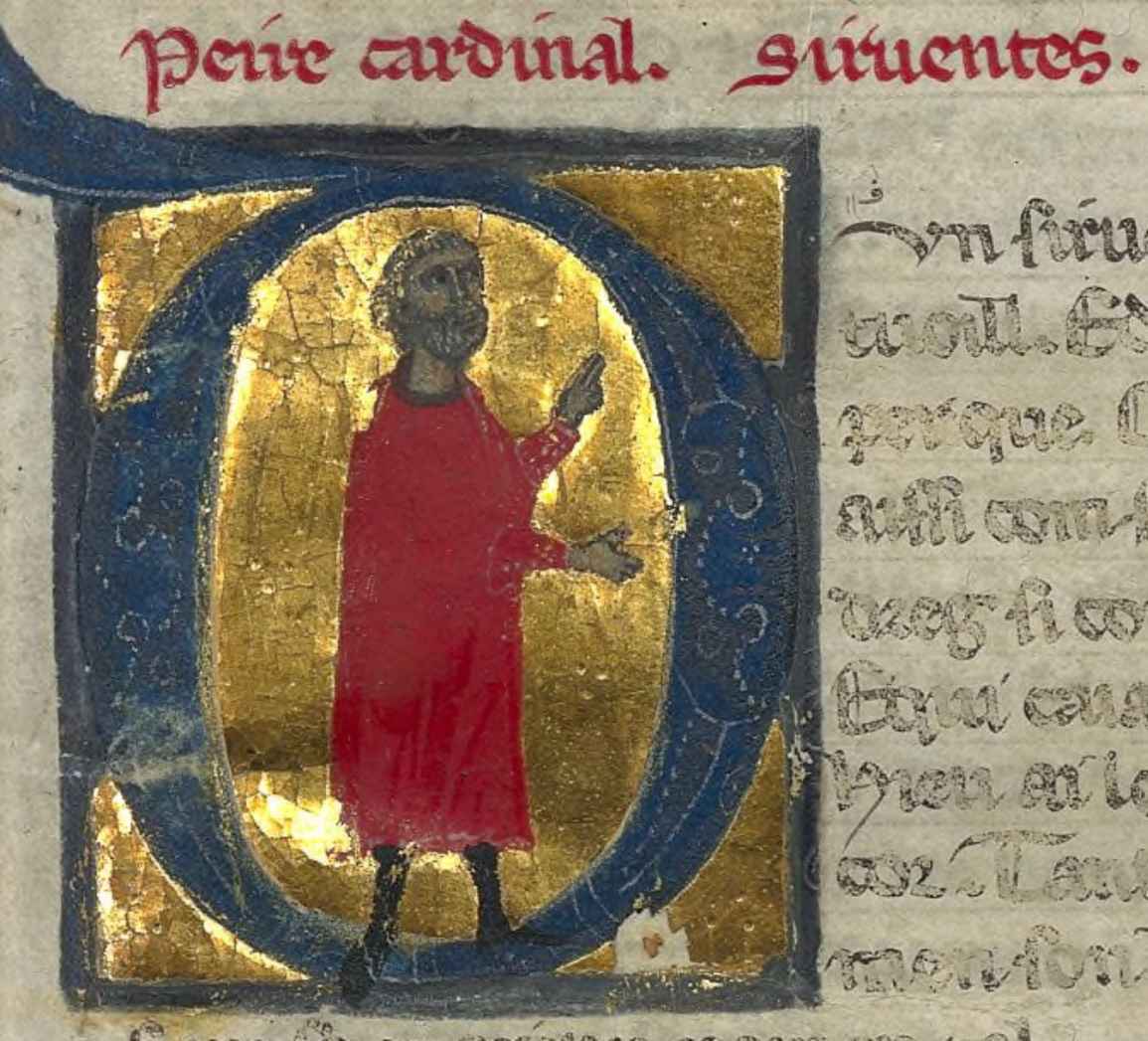
A medieval depiction of Peire Cardenal
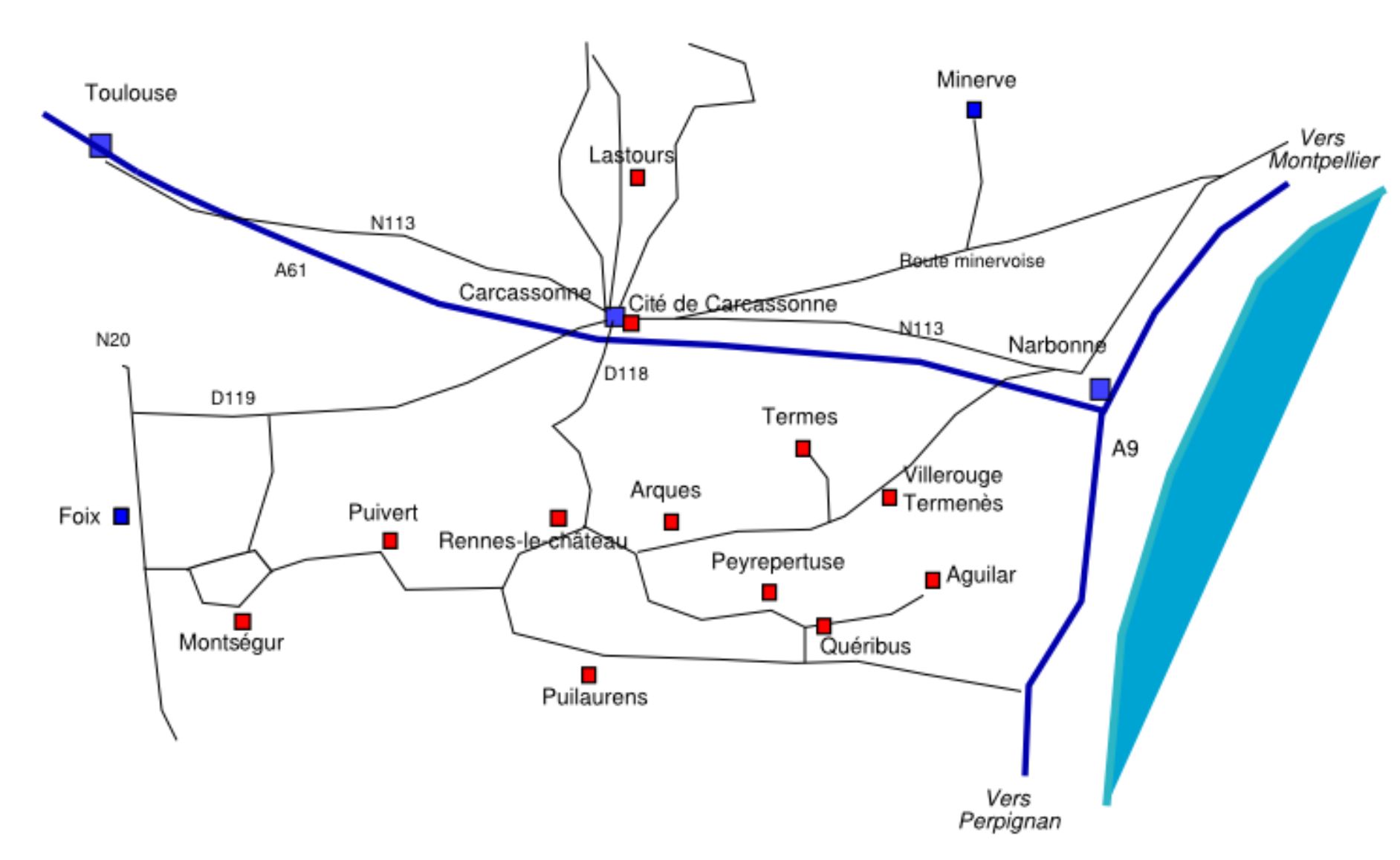
A map of the network of Cathar castles (in blue) across southern France
Medieval France was nowhere close to the 643,800 square kilometers of verdant, strikingly diverse terrain now under the modern state’s dominion. Quite the opposite, it was home to a farrago of kingdoms, dukedoms, fiefdoms, and counties, with the disorder heightened by the tangled alliances and divided loyalties of the local governments.
The political turmoil was particularly acute in the Languedoc region. Portions of this colorful, Occitan-speaking district were fiefs that belonged to the Holy Roman Empire, much of it governed by the Catholic Church. Some saluted the French Crown; some paid obeisance to the Aragonese monarchs. Others chose to retain their independence, resisting all the attempts by foreign sovereigns to intervene in their territories. The Counts that chaired Toulouse, a vassal state of the Kingdom of Aragon, were among the most influential and esteemed men in all of Languedoc, for it was they who possessed the richest, and most sizable stretches of land in the region.
Notwithstanding the tricky patchwork of conflicting allegiances in these parts, the inhabitants of Languedoc lived in relative harmony. This was, in large part, thanks to the out-of-character, but ultimately beneficial religious tolerance exhibited by the local leaders – excluding those employed by the Catholic Church – who welcomed immigrants and allowed its burgeoning populaces to embrace and practice whatever faith they so fancied. Smaller governments that took notice of the appreciable upswing in the overall economy of these open-minded territories soon followed suit.
The ineptitude and steadily rising misconduct and dishonesty among the Catholic communities in Languedoc only fueled the multiplication of the dissenters in the area, the most prominent of them being the Cathars. The faith of the people – including the governors of these liberal districts, and even those under the jurisdiction of the Holy Roman Empire – in the Church was fast waning. A litany of complaints directed against the clergy in southern France, branded as indolent, vindictive, and hopelessly unlettered by the progressively growing population of Languedocian Cathars, was not only threatening to, but succeeding in dismantling the Catholic presence there. Even Pope Innocent III himself would later express his disappointment with his southern French clergy, bitterly likening the priests in Narbonne to “dumb dogs who can no longer bark.”
As the Church continued to stumble downhill from the peak of grace, the Cathars pounced on the opportunity to resume their expansion. Toulouse was among the first in the district that was struck by Cathar fervor. The anomalously “modern” and democratic policies of the Counts of Toulouse, along with their laissez-faire attitude towards all colors of religions, and their rejection of the north's feudal systems made it an instant magnet for Cathars, and served as the perfect kindling that allowed the fire of Catharism to spread across the South.
Though Count Raymond VI of Toulouse publicly identified as a Catholic, he maintained a powerful rapport with the Cathars in his county, for many in his family, loved ones, and cortège belonged to the faith. The non-partisan count, who prioritized qualification over background and creed, filled his cabinet with both Catholics and Cathars, and in another unprecedented move, promoted Jews to some of the highest-ranking posts within his administration. By the end of the 12th century, Toulouse had become the 3rd largest city in the whole of Europe, just behind Venice and Rome, and it was swimming in prosperity and a marvelous miscellany of art and cultures.
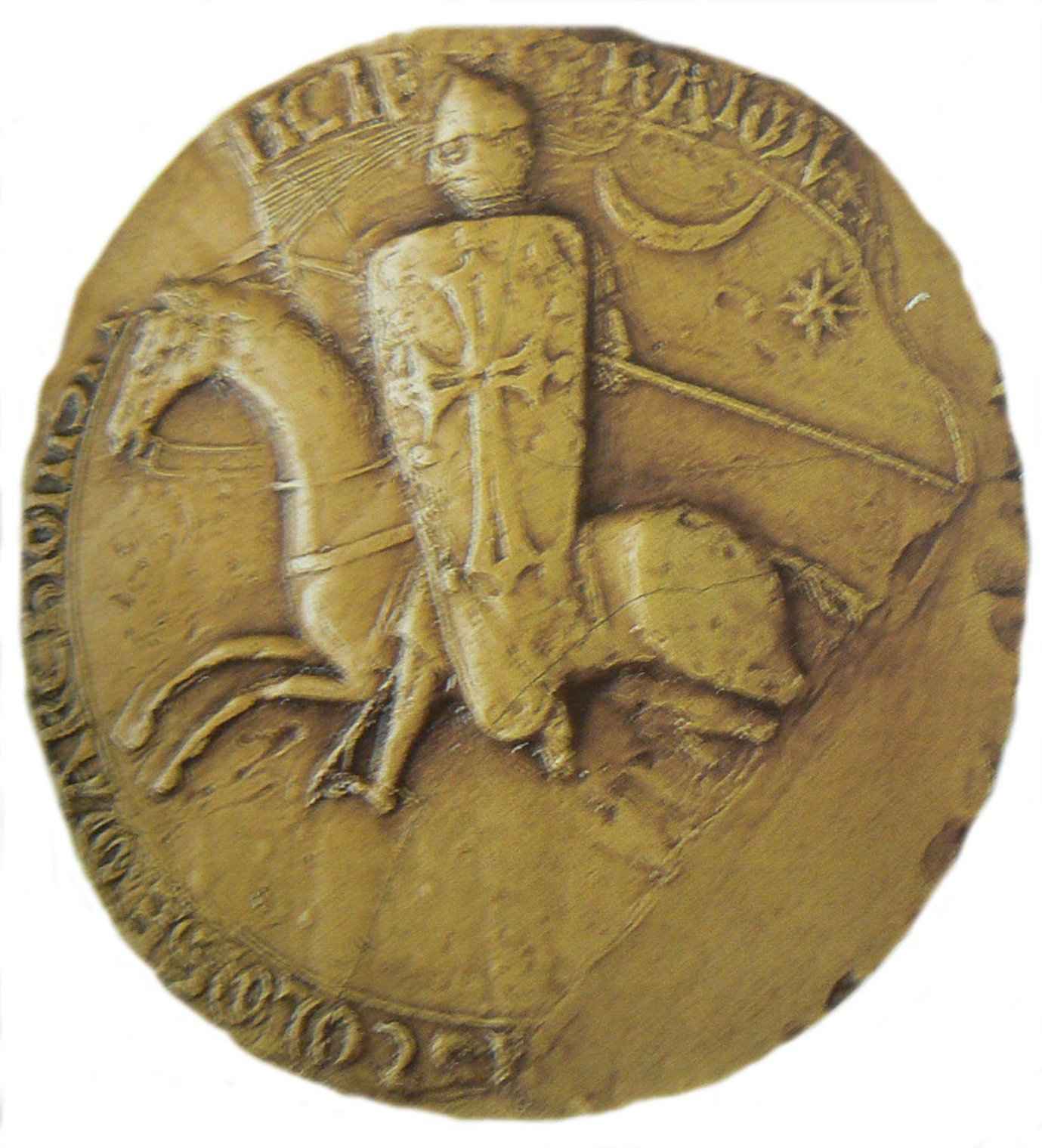
Raymond VI’s seal
As to be expected, the style of Count Raymond's direction drew much criticism from his counterparts, but this would not have been a problem had it not been for his complicated connections. While most of Toulouse belonged to the Aragonese, Raymond also owned several properties in Provence and southeastern France allotted to him by the Holy Roman Emperor and the Kings of France and England. Consequently, much of Raymond's time was devoted to smoothing out internal differences and preserving some semblance of order within the latticework.
From Toulouse, Catharism spread roughly 50 miles northeast to Albi, situated by the River Tarn. Though the faith found some success in establishing a small base in the quiet commune, their presence was nowhere near the extent the Catholics had believed it to be. For reasons unknown, the Church was so adamant that this was the setting of the Cathar's center of operations that they began to refer to all Cathars as “Albigensians.”
From Albi, Catharism wandered into Carcassonne, which lay about 67 miles south of the “Cathar center.” The Carcassonnians, who had gone from disgruntled to incandescent at the widespread corruption that ran rampant in their local Catholic churches, swiftly responded to this new strain of Christianity, with many relating to and echoing the cult's vehement resentment of the Catholic Church.
It was becoming increasingly difficult for the Church to ignore the spiking number of heretics in the southern neck of France, which soon earned itself the nickname “Cathar (or Albigensian) Country.” They were far more proficient in their powers of persuasion than previously thought; over a span of just a few decades, more than 10% of the citizens in Languedoc were calling themselves Cathars.
The survival of the Catholic Church hinged on a time-worn system consisting of 3 “orders,” with each echelon in European society properly defined by their given roles. First came the clergy, tasked with enriching and fostering religious life. The nobility, a body that often intertwined with the Church, spearheaded all the decision-making and execution of wars and other political affairs, oversaw the economy, and were charged with the implementation of the justice system. The commoners were saddled with manual labor and grunt work, mostly pertaining to agriculture, though others scraped by as merchants and small-time business owners. Unfortunately for those on the bottom of the barrel, the likelihood of escaping their grueling lives and mountainous debts was slim to none, obstructed by a skewed tax system that allowed nobles and clergymen to rob them blind.
The meddling Cathars disrupted this feudal system. Owing to the cult's promotion of poverty, along with their unabashed disrespect for and insubordination towards the Catholic Church, more and more of the newly-converted Cathars followed by example. Most alarming to the Catholics was the Cathars' bold refusal to pay their due tithes. Threats of excommunication and banishment, which previously had record success rates, no longer packed the same punch. Many of the Cathars presented with such an ultimatum supposedly hooted in the florid faces of their persecutors, and when banished, simply found refuge in the Cathar base of a neighboring town. Even more unnerving was the close bond the Cathars had developed with their local lords.
The Catholic Church began to pick up on the scent of the Cathars at the break of the 11th century, but it only truly began to pursue them in earnest over a century later. Between the years of 1022 (the same year the Church executed the 13 Cathar perfecti in Orléans) and 1163, the Cathars were among the top items on the agenda of 8 different Church councils.
It was during the 1163 Council of Tours, hosted by Pope Alexander III, that the term “Albigensian” was first applied, and it soon became glued to the Cathars. Though the schism within the Church at the time was the most pressing matter at hand, the pope, who insisted upon treating the gathering like any other “general council,” made certain to address what he saw as the disease of heresy that was spreading unchecked in the southern country. As it was clear that diplomacy and dialogue alone were not enough to stamp out these heretics, it was time for the Church to put its foot down. An excerpt from “Canon 4: Action Against the [Cathars],” penned by Pope Alexander III, read, “In parts of Toulouse a damnably heresy has recently emerged, which is gradually spreading towards neighboring areas and diffusing like a canker, through to Gascony and other provinces, many of which are already infected...Which, while in the form of a snake hiding inside its coil how much more it creeps secretly, more seriously while the Lord's vineyard those of a simple-mind are destroyed...”
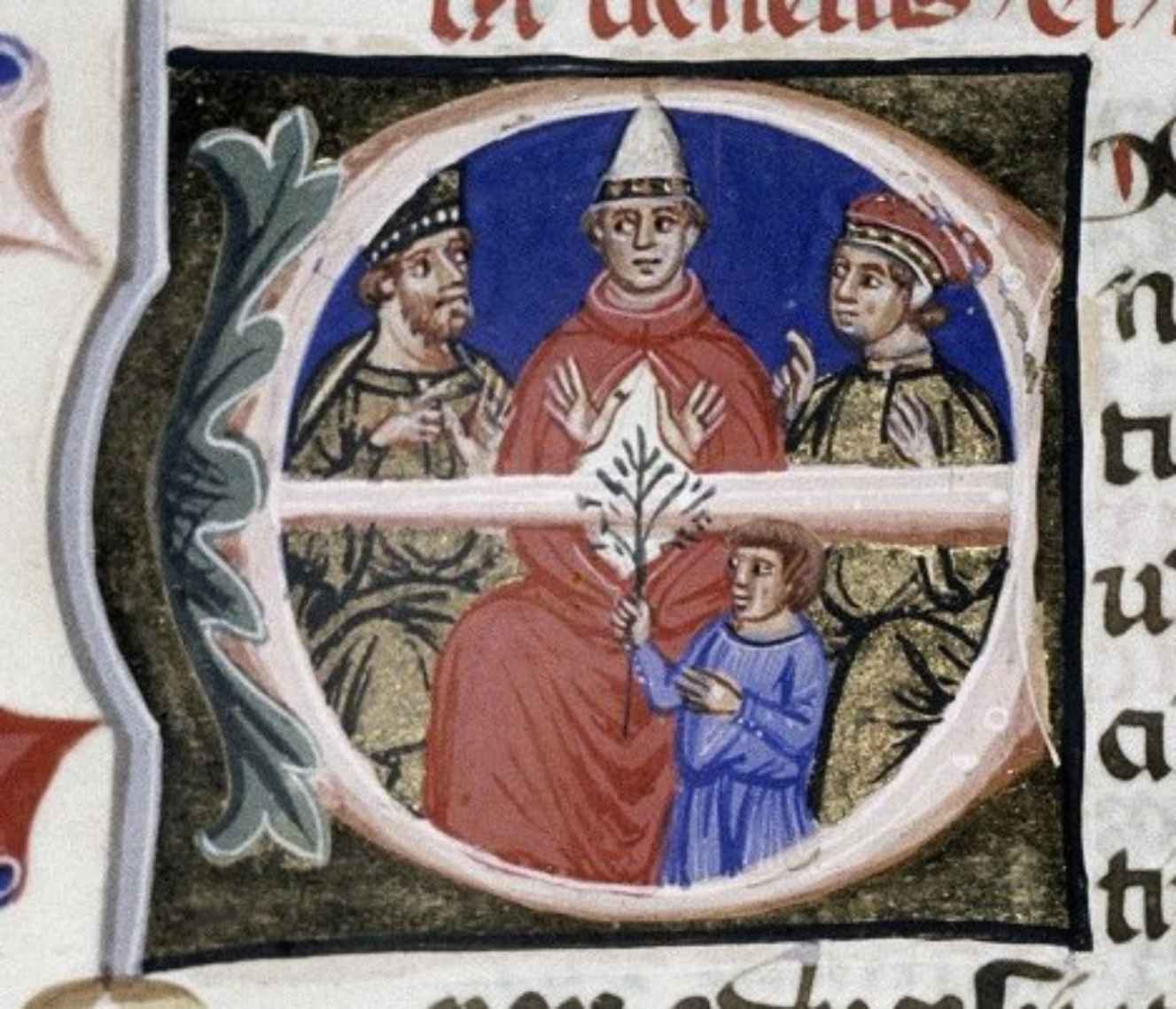
A medieval depiction of Pope Alexander III
The pope called upon all Christian princes to pluck out these dreadful Cathars hiding in plain sight and urged them to humiliate them to the fullest degree by throwing them behind bars and seizing their properties. All clergymen and Christian commoners were to regard the Cathars with the same scorn: “It is declared that...all the priests of the Lord having their abode in those parts to be vigilant, and under the penalty of anathema [excommunication] to prohibit them where they are known to follow this heresy, nor to afford any one of them shelter on their land, or presume to impart protection...”
Plainly put, as these heretics were now outlawed, they were to be frozen out by the community. All business relationships with Cathars were to be severed at once, and likewise, all restaurants, marketplaces, and public establishments were banned from serving these heretics. These harsh sanctions were defended by the pope, who explained that the “source of comfort to mankind might at least force them to see the errors of their lives to return to their sentences.” Anyone fraternizing with a Cathar was at high risk of being found guilty by association. The same canon warned, “But if any man should attempt to be in opposition to this, and found to be a participant in this iniquity, they shall be smitten by anathema.”
At the Third Lateran Council 16 years later, the anti-Cathar canon was revised to include even more stifling sanctions, and after decades of shrugging off the Catholic Church, the indignant Cathars, now wanted by the Catholic Church, finally responded to the councils with a gathering of their own. In 1167, Cathars and other sympathizing Gnostic Christians from all across the country assembled in St. Felix-de-Caraman, just next to Toulouse, for what became known as the first “Cathar Synod.” The event, arranged and anchored by the Cathar episcopos of France and Lombardy, and Bogomil papa Nicetas from their sister sect in the Balkans, thronged with hundreds of fuming parfait. But rather than concede defeat, the iron-willed Cathars chose to stand their ground.
The coronation of Pope Innocent III in 1198 only escalated the tensions to new heights. Initially, it appeared that Pope Innocent III, who wished to avoid war at all costs, would attempt to tackle the Cathar issue with “peaceful” tactics. He sent scores of delegates to Cathar country who encouraged them to relinquish their “sacrilegious” faiths through the power of words. However, when none of these delegates could complete their objectives, Pope Innocent turned to Count Raymond VI. In a strategic move, the pope displayed to Raymond, who had been excommunicated for his continuous dealings with the Cathars, a rare act of clemency and granted him a pardon. Obviously, this pardon was not free - in return, Raymond would have to enact the laws decreed by the papal bull and launch a comprehensive campaign against the Cathars.
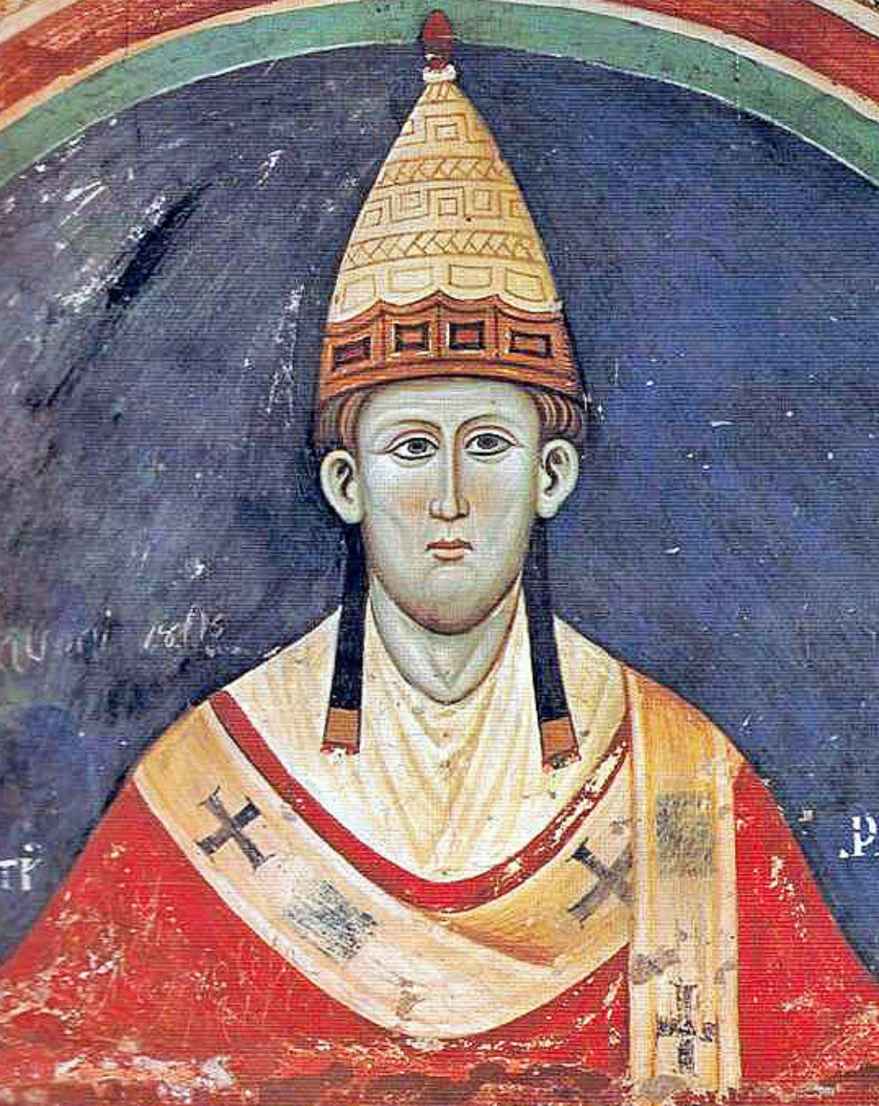
Pope Innocent III
Meanwhile, the Cathars, sensing dangers of cataclysmic proportions in their midst, began to make preparations for the incoming crisis. In 1204, Lord Ramon of Perella began a series of repairs and renovations on the 40-year-old ruins of the Montségur Fortress for the Cathar perfects, Raymond de Mirepoix and Raymond Blasco. Though the towering walls of the fortress originally functioned as partitions that allowed the Cathars to worship and carry out their rituals outdoors, as specified by their doctrine, it would soon become the “heart of the resistance movement” as the last of the Cathar strongholds.
Once the Château de Montségur (“Castle on the Safe Hill”) was fully reconstructed and secured, the fortress was declared the “domicilium et caput,” or “House and Head” of the Cathar Church, as ordered by the parfait, Guilhabert de Castres. It became a safe space for all Cathar refugees, fugitives, and faidit (exiles), near and far. The spacious castle was large enough to accommodate 500 at once, and stocked with barrels upon barrels of grain, corn, and water, as well as other provisions.
In 1207, things began to reach a boiling point. At this stage, describing Languedoc as rocked by bedlam would be an understatement. The nobles of the area were squabbling amongst themselves, embroiled in territorial wars (fought by mercenaries) encouraged by the property-hungry Count of Toulouse, and even the relationship between the liege lord and the Languedocian nobility began to sour. That year, unbeknownst to Count Raymond, a papal representative by the name of Peter of Castelnau arranged a string of meetings with the Catholic Languedocian commanders, persuaded them to cease their domestic battles, and convinced them to direct their campaigns towards the Cathars instead. To Peter's chagrin, swaying the convictions of the count would prove far more difficult, as Raymond flat-out refused. Not only was he outraged by the fickleness of the nobles, which now meant that his territorial ambitions would be further delayed, he considered the persecution of any of his citizens, no matter the creed, a disgrace.
Sadly, Raymond was much more malleable the second time around. It took the reinstatement of his excommunication, followed by the loss of the much-needed support from his nobles, a public whipping in Saint Gilles, and a forced public apology to the clergymen he had wronged, for Raymond to finally cave in to the Catholics' demands. In August of 1207, Raymond grudgingly vowed to purge every last Cathar from his lands.
Persecution
“The Roman Church...[says] that the heretics they persecute are the church of wolves. But this is absurd, for the wolves have always pursued and killed the sheep, and today it would have to be the other way around for the sheep to be so mad as to bite, pursue, and kill the wolves, and for the wolves to be so patient as to let the sheep devour them!” – from the alleged writings of the Cathars
At this point, the pope's patience was wearing thin. Count Raymond was dragging his feet, conjuring up one feeble excuse after another as to why no progress was being made on the Cathar “outbreak” in his domains. And when it became clear that Raymond had no intention of keeping up his end of the bargain, the pope retaliated by serving him with an array of apparent “offenses” against the Catholic Church, which included the crime of sympathizing with the Cathars and the theft of Church property, amongst other transgressions. Shortly thereafter, Count Raymond VI was, once again, cut off by the Church.
In January of 1208, a panicking Raymond quickly requested the presence of Peter of Castelnau in Saint Gilles, and he begged for the papal delegate to plead his case to his superiors on his behalf. Peter agreed to meet with Raymond, and the pair deliberated the matter over the course of the next few days, but it did not take long for these negotiations to turn into heated debates. It was during their last meeting on the 15th of January that matters truly got ugly, so much so that the event ended with a furiously cursing Raymond lunging at Peter in front of more than half a dozen witnesses. Once Raymond had been peeled off of Peter, the livid delegate strode out of the count's chambers and stomped off his estates, determined not to look back. In hindsight, it seemed that Peter might have been better off doing just that, for as fate would have it, the moment he turned down the road by Saint Gilles Abbey, a knife was plunged into his back. He was discovered just a few hours later, but by then, his corpse was already beginning to stiffen.
Though the assailant was never identified, Pope Innocent III was the first to point a finger in Raymond's direction. Luckily for Raymond, due to the lackluster weight of his hearsay-based evidence and unsubstantiated claims, not to mention the absence of witnesses, he was never brought to trial.
That said, the murder of Peter of Castelnau was enough to provoke the already restless pope into waging a full-scale war against the Cathars. On March 10, 1208, the day of Peter's canonization, the pope summoned the Christian Crusaders and unleashed upon them a riveting, albeit long-winded, speech: “Forward then, Christian knights! Forward, courageous recruits of the Christian army! May a pious zeal set you on fire to avenge so great an offense against your God!...The ship of the Church will suffer total shipwreck unless it gets some strong help in this unprecedented storm. This is why...we order you...in the name of Christ, in the face of such peril, we promise the remission of your sins, so that you may thwart such dangers without delay.”
The pope urged them to unshackle all inhibitions and shed all restraints when dealing with these heathens: “Be diligent to destroy the heresy by any means God will inspire you to use. With greater assurance than with the Saracens, since they are more dangerous, fight the heretics with a mighty hand, and an outstretched arm...Strip them of their land, so that Catholics may replace the eliminated heretics and serve in God's presence...according to the discipline of your orthodox faith.”
Even the pope himself would later admit that there existed no evidence tying Raymond, or any other Cathar, to the cold-blooded murder. Others accused the Catholic Church of choreographing and executing the assassination themselves in a desperate bid to justify violence against the heretics, but they, too, had no concrete evidence.
Whatever the case, the Catholics proceeded with their campaign, and in 1209, the Albigensian Crusade began.
The first Catholic battalion of about 10,000–20,000 strong began their march south from Lyon in early spring of that year. Leading the crusade was Simon de Montfort, an English-French aristocrat and seasoned military general. Assisting him in this momentous campaign were the Counts of Saint-Pol and Nevers, the Seneschal of Anjou, the Duke of Burgundy, and other veteran captains with equally glittering careers.
The party continued to slog through the rough terrain along the River Rhone, heading for Provence, where they were later united with the “Spiritual Adviser” of the Crusade, Arnaud Amalric. This was the same Arnaud Amalric who, when asked how to distinguish between the Cathars and Catholics, reportedly uttered the famous phrase now most commonly associated with the Albigensian Crusade: “Kill them all. The Lord will recognize His own.”
The Catholic forces laid siege to Cathar Country with ease, and in late July the Cathars experienced the magnitude of the crusaders’ savagery for the first time. On the 21st of that month, Catholic troops descended upon the Langudeocian town of Béziers, which was under the guardianship of Raymond-Roger Trencavel III, the Viscount of Béziers and Carcassonne. Trencavel stepped forward to receive the Catholic generals at once, and when he failed to reach an understanding with them, alerted his uncle, the Count of Toulouse, and petitioned him for help. To Trencavel's consternation, not only did Raymond decline, many of the Count's own soldiers had been integrated into the same Catholic troops stationed at Béziers.
The Catholic generals demanded from Trencavel a list of 222 Cathars – evidently, to fill a quota they had been provided by the Church – but to this, Trencavel refused. The next morning, tens of thousands of Catholic soldiers surrounded the Basilica of St. Mary Magdalene, where 20,000 locals gathered for Mass, bolted it shut, and promptly torched the place. All men, women, and children perished in the flames. When the soldiers later learned that they would not be keeping the plunder from Béziers - it would instead be used to fund the ongoing crusade - the seething soldiers rioted and razed the city to the ground.
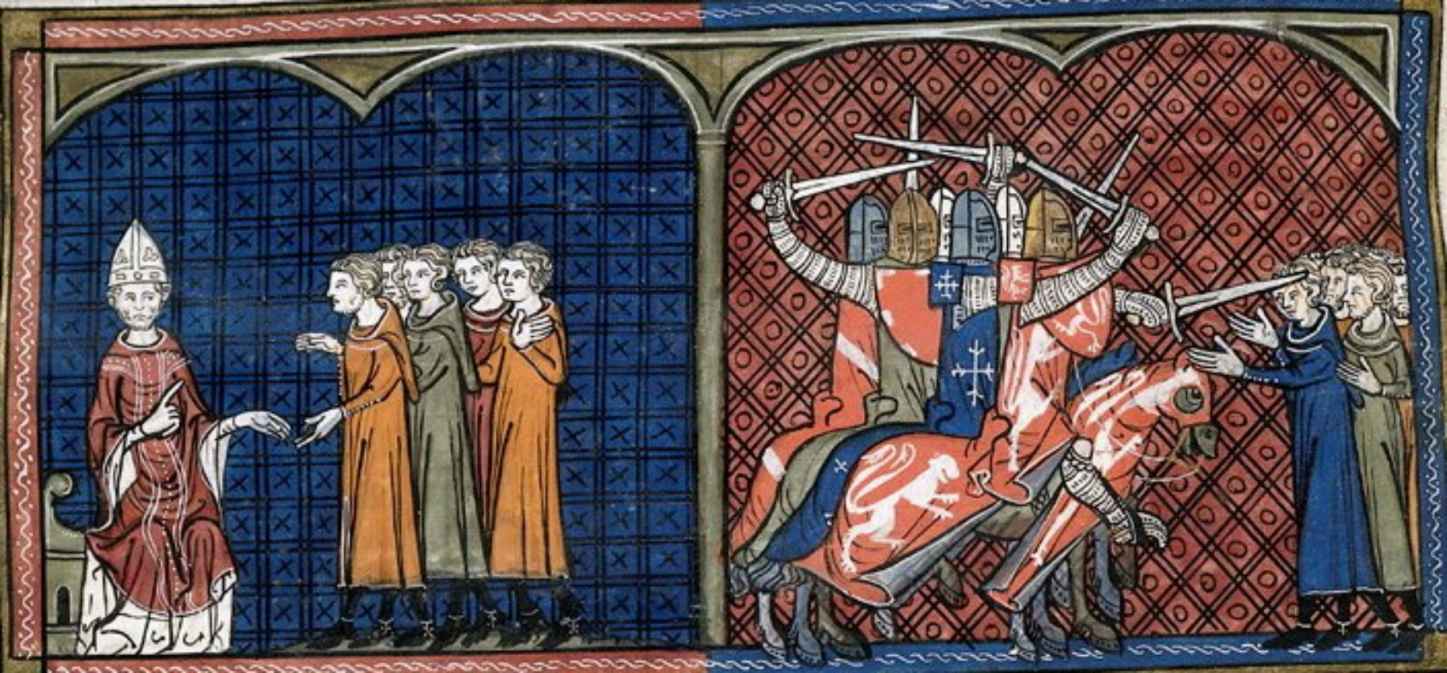
A medieval depiction of the pope excommunicating the Cathars and the Catholics massacring them
The Catholic generals proceeded to their next major target, Carcassonne, on the 1st of August, 1209. This Cathar stronghold, overflowing with Cathar refugees who had escaped the crusade up north, was enclosed by 26 armed towers, just above the River Aude, but these defenses soon proved to be no more than glorified fences. The Catholics closed in on the stronghold's most indispensable resource – the River Aude – and succeeded in holding its water supply hostage in less than a week. By the 15th, Carcassone had raised a white flag, and Trencavel was imprisoned in the dungeon of his very own fortress, where he died from dysentery about a month later. Though Carcassonne was spared a bloodbath, all Cathars, dissenters, and sympathizers were ousted from the city, taking with them “nothing but their sins.”
Raymond II de Trencavel, the son of Viscount Raymond-Roger, was only 2 years old when his father wasted away behind bars. That being said, given all the tales (both tall and true) surrounding Raymond-Roger's heroics, which were naturally shared in droves following his demise, it was as if the son had known the father all his life. As a matter of fact, many say it was these very tales that inspired the junior Raymond to take back what he believed rightfully belonged to his father.
In hindsight, many believe it was Raymond's restlessness that contributed to the downfall of his overzealous ambitions. The Viscount of Béziers made his affinity with the surviving Cathars, Jews, and other “heretics” in the county no secret, which quickly made him a recipient of unwanted attention from the Catholic Church. The hawk-eyed Inquisitors were watching him long before he even concocted his daring scheme.
On September 17, 1240, a band of soldiers from Béziers galloped towards Carcassonne and formed a blockade around the fortress. For weeks, Raymond's men warred with the besieged occupants of Carcassonne. And while they came close to knocking down a stretch of the fortress walls, the Catholics at Carcassonne, who had been expecting them, were swiftly rescued by relief forces of the royal army.
Raymond's troops managed to keep the unanticipated reinforcement at bay for some time, but they were eventually chased away to Montreal. The relentless royal forces followed them there, and tormented him with yet another siege. Unlike his father, Raymond managed to evade his enemies by the skin of his teeth, and took refuge in Barcelona. Still, Raymond's territories never truly recovered. Not only would he fail to retrieve Carcassonne in the name of his father, he was left with no choice but to surrender Béziers and the rest of his lands to King Louis IX in 1247.
As decreed by the French king, all inhabitants were cleared out of the Cité and prohibited from returning for 7 years. Louis then marshaled a team of veteran soldiers and architects, and charged them with repairing and boosting the defenses of the fortress. A substantial garrison was also installed to defend the citadel from rebellious Catalan or Aragonese soldiers, Cathar sympathizers, and other allies of Raymond looking to seize the fortress for the disgraced viscount.
The quintet of “Cathar Castles” that stood by the boundary between the Trencavel and Aragonese-owned Roussillon possessions were among the properties Viscount Raymond II was made to relinquish. Each castle was overhauled and redeveloped as “frontier fortresses,” or “royal citadels,” kitted out with a royal garrison of their own. They were then reintroduced as the “cinq fils de Carcassonne,” or in English, the “Five Sons of Carcassonne”: the Château de Peyrepertuse, Château de Puilaurens, Château d'Aguilar, Château de Termes, and the Château de Quéribus.
In 1248, the displaced Carcassonnians that been banished from the Cité began work on a new community across the River Aude. This was none other than the Ville Basse, or “Lower Town,” also known as the “Bastide of Saint Louis.” The Ville Basse, which came with a network of parallel streets and an unusual graveyard above one of the bastions on the bulwark, would one day become the commercial center of Carcassonne. By the mid-1300s, there were an estimated 7,000 or so houses in the booming industrial district – complete with its own consulate – of the Ville Basse alone. Meanwhile, the “Old City” remained free of civilians, and now served as the “episcopal see and inquisitorial seat” of Carcassonne.
In 1315, the French crown ordered the construction of “Le Pont Vieux” (The Old Bridge). The new structure, which was funded by a special tax and completed 5 years later, was built atop the foundations of the Roman bridge. Simply designed, the drab gray bridge consisted of a straight walkway, shored up by a dozen brick arches measuring about 10 to 14 meters (33 to 46 feet) across each. Apart from linking and delineating the border between the Cité and the Ville Basse, the neutral status of the Pont Vieux made it the setting for many peace treaties and truces signed by the feuding residents of the Carcassonnian districts.
While the death toll that resulted from the Inquisition in Carcassonne paled greatly in comparison to the neighboring counties and viscountcies, it was, to the locals, a cancerous presence they strove to eliminate. In 1303, just 12 years before the construction of the Point Vieux, the Carcassonnians finally achieved what they were beginning to think was an unattainable feat.
It was Bernard Délicieux, the prior of a Franciscan convent in the viscountcy, who many credit with driving the Inquisitors out of Carcassonne. Troubled by the unchecked powers of the Inquisitors and the unnecessarily cruel torture the persecuted were made to endure, Bernard criticized the Church in ecclesiastical meetings, and pleaded with them to change their ways. When his protests continued to go unheard, Bernard organized a revolt against the institution in 1299, which triumphed in preventing the Catholic guards from getting to the 2 heretics he had stowed away in his convent. He went on to raise another ruckus in July of the following year when the Inquisitors exhumed Castel Fabre, a member of the wealthy bourgeois, and attempted to brand him a Cathar in a bid to seize his possessions from the deceased's descendants.
In October 1301, Bernard, partnering with Jean de Picquigny, the new viceroy of Languedoc, journeyed to the royal residence of King Philip IV. There, they presented to the king a document brimming with proof of the corruptions of the Inquisitors, more specifically, those of Bishop Castanet and Friar Foulques de Saint-Georges. Not “even babies in their cradles,” were safe, insisted an unnamed witness, were safe from the Inquisitors.
Bernard and Jean were initially ignored by the French king, who belonged to the same camp as the Inquisitors, but when the complaints involving the 2 head inquisitors continued to mount, King Philip was forced to take action. Though the pair escaped prison time, Friar Folques was demoted and relocated to another department. As for Bishop Castanet, he was fined 20,000 livres and stripped of his title, putting his reign over Albi to an end.
While Carcassonne and the neighboring territories experienced a noticeable decrease in heresy-related arrests in the years that followed, Bernard's defiance of the Catholic Church would not go unpunished. In December 1319, Bernard was arrested on the charge of obstruction of the Inquisition and treason against the French crown. What became of him is still unknown. Some say he was marched to the gallows alongside his cortege. Others say he spent the rest of his life chained and miserable in the cold dungeons of Carcassonne.
The Catholic Church's unhealthy obsession with the heretics eventually petered out in the mid-14th century, but before people Carcassonne could even catch their breath, the site was bombarded with another, even more harrowing batch of problems. In the 1320s, the “Great Mortality,” better known as the plague, struck Carcassonne, claiming the lives of anywhere between 30-50% of the population. The severe famine that ensued continued to pick at what remained of the Carcassonnians.
As bad as those problems were, it was Carcassonne's involuntary involvement in the Hundred Years' War that would truly threaten its existence. The campaigns of Edward “the Black Prince” of Woodstock led him to Carcassonne in early November 1355. Despite the clear signs of a deteriorating city being neglected by the vanishing population, Prince Edward was mesmerized by the sight of it: “It was a fair city to look upon, and a great one. It was larger, stronger, and more beautiful than York.”
When the prince failed to take hold of the armed fortress, he set his eyes upon the Ville Basse. The residents of the lower town begged him to leave their already ailing town, and they even offered him 250,000 gold crowns (roughly $53,123 USD today) to sweeten the deal. But Edward was not interested in any of their inducements; after all, he was here to “deliver justice.” An extract from a letter written by the Black Prince himself summed up what followed: “We spent the whole day in burning, so that [the Ville Basse] was completely destroyed.”
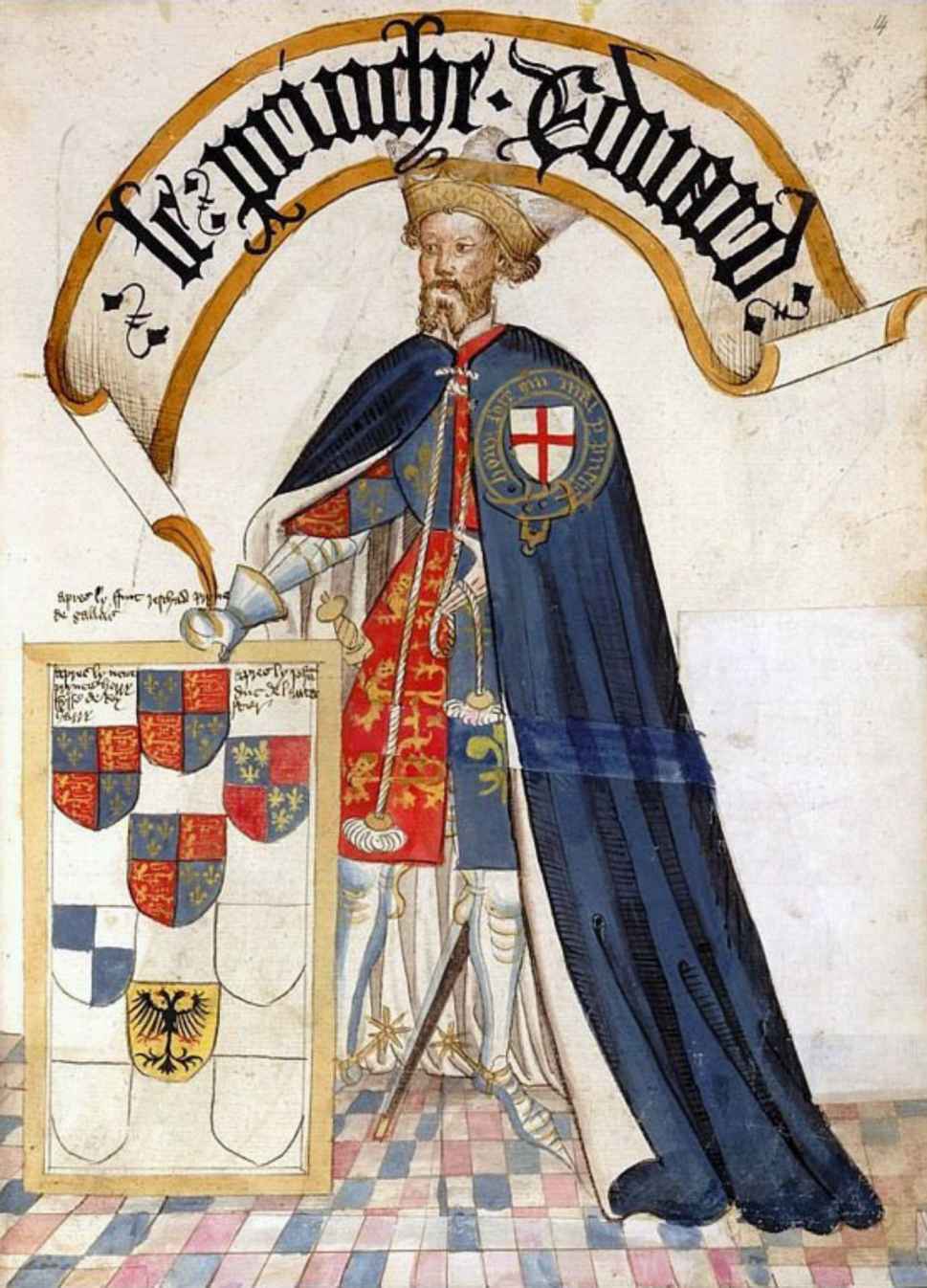
A depiction of the Black Prince
To say that the destruction was catastrophic would be an understatement. As one of the prince's fellow commanders, Sir John Wingfield, later put it, “There was never such loss nor destruction as hath been in this raid.”
The Roman Inquisition wiped out the last of the Cathars, and by the early 14th century, the Catholic Church declared Catharism extinct. The 1323 burning of Guilhem Belibaste, a perfecti who had been outed by an undercover Catholic while hiding out in Morella, is now widely thought to be the execution of the world's last Cathar.
The Seeds of Reformation
Towards the 16th century, the introduction of the Protestant Reformation in Europe threatened to crack the foundations of the Roman Catholic Church. The restless public began to distrust the church and shunned them for their corrupt ways, accusing the Catholics of consciously wandering away from God's light. Perhaps one of the most audacious abusers of authority was the holy Pope Leo X himself. Upon entering his papacy, he was supposedly quoted as saying, “Since God has given us the papacy, let us enjoy it.”
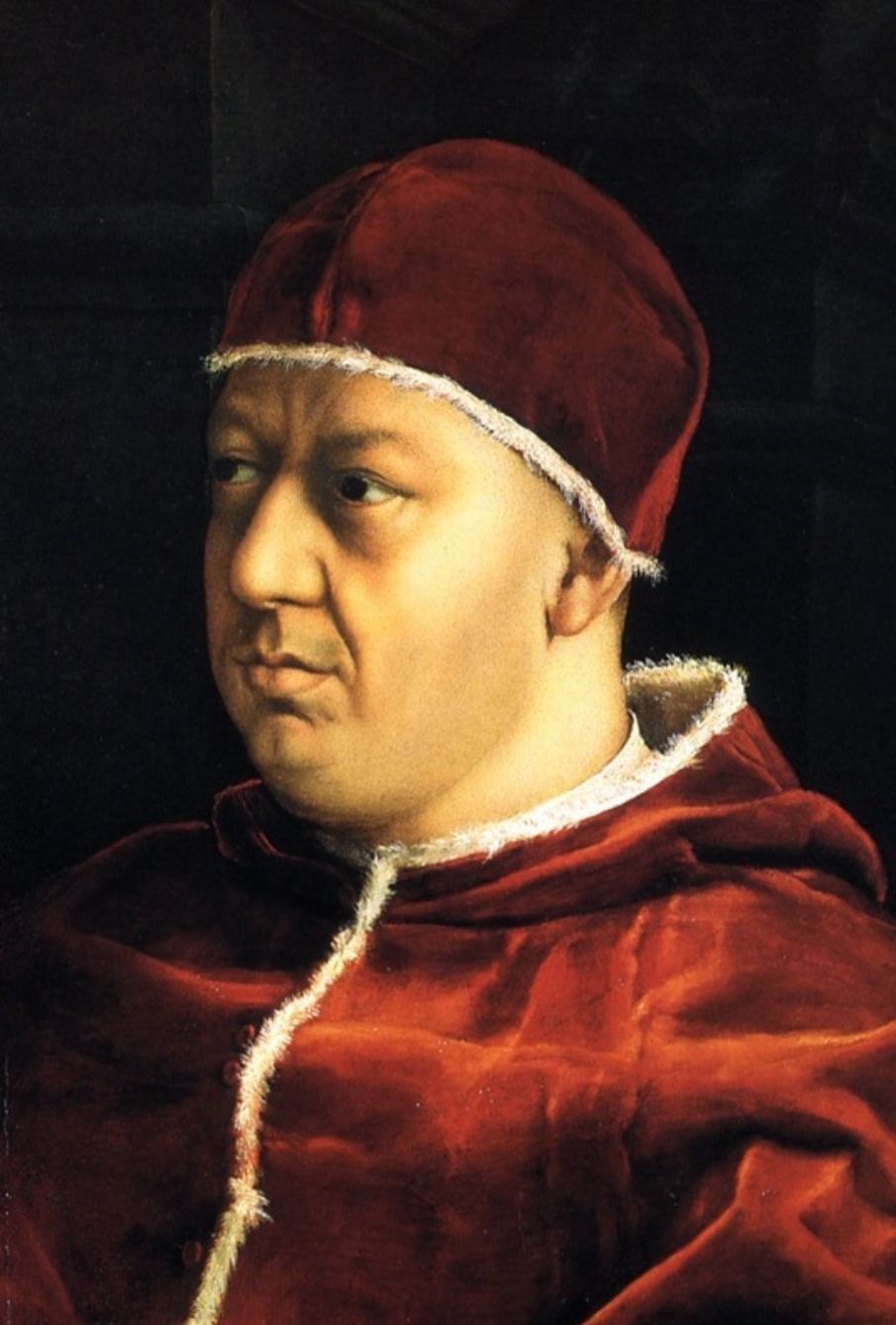
Pope Leo X
Pope Leo was often commemorated as a liberal pacifist with a tremendous heart. That said, he also gained notoriety for his insistence on a lavish and sumptuous lifestyle. As he began to warm up the seat of his papal throne, he rolled up his sleeves and took it upon himself to reinvent the Catholic empire. His first order of business was to speed up the construction of St. Peter's Basilica. The pope then began to splurge on sculptures, paintings, intricate stained glass masterpieces, and other costly artwork. His frivolous granting of bishopric positions to his relatives only aroused more grumbling from outsiders. He was repeatedly warned about his financial habits, but his reckless spending sprees continued. Within 2 years, he had exhausted the papal treasury.
The pope was in a pickle; he needed to find a way to scrounge up the remaining half of the bill for the unfinished basilica. And so, a special tax known as an “indulgence” was created. For a fee, the grieving could bring their deceased loved ones out of Purgatory, and soar past those on Heaven's waiting list. For an even heftier price, one could purchase their own spots in Heaven in advance.
Meanwhile, Pope Leo supposedly harbored a twisted friendship with Cardinal Albert of Brandenburg. At 23, Albert reigned as both Archbishop of Magdeburg and the Administrator of Halberstadt, which was traditionally against canon law. Yet in this climate of corruption, this, as with many other laws, was swept under the rug. When the post of Archbishop of Mainz became up for grabs, Albert yearned to add a third title to his repertoire, an ambition hampered by the fact his funds were also looking a little dry. Albert succeeded in obtaining an IOU from Jakob Fugger, an extremely wealthy Austrian merchant and reported “florin multimillionaire.” After securing the loan, Albert paid Leo the staggering entrance fee and was declared the Archbishop of Mainz. Soon after, the Pope sanctioned the practice of indulgences in Germany. Johann Tetzel, a Dominican monk, was appointed Germany's commissioner of indulgences, acting as a traveling salesman of sorts. Half the profits derived from the indulgences would be set aside to reimburse Fugger, whereas the rest were funneled into the basilica construction fund. This accelerated the building of the palatial cathedral, fashioned out of marble, limestone, and brick, which continues to be a sight to behold today.

Albert of Brandenburg
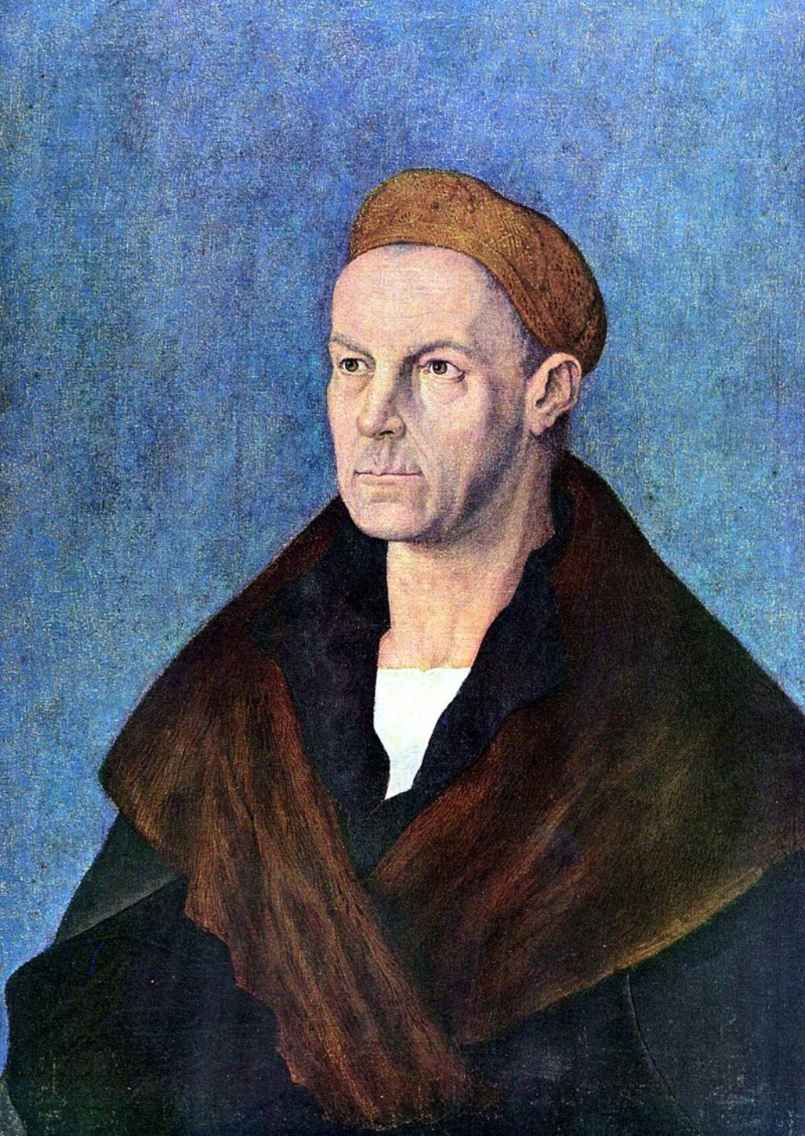
Fugger
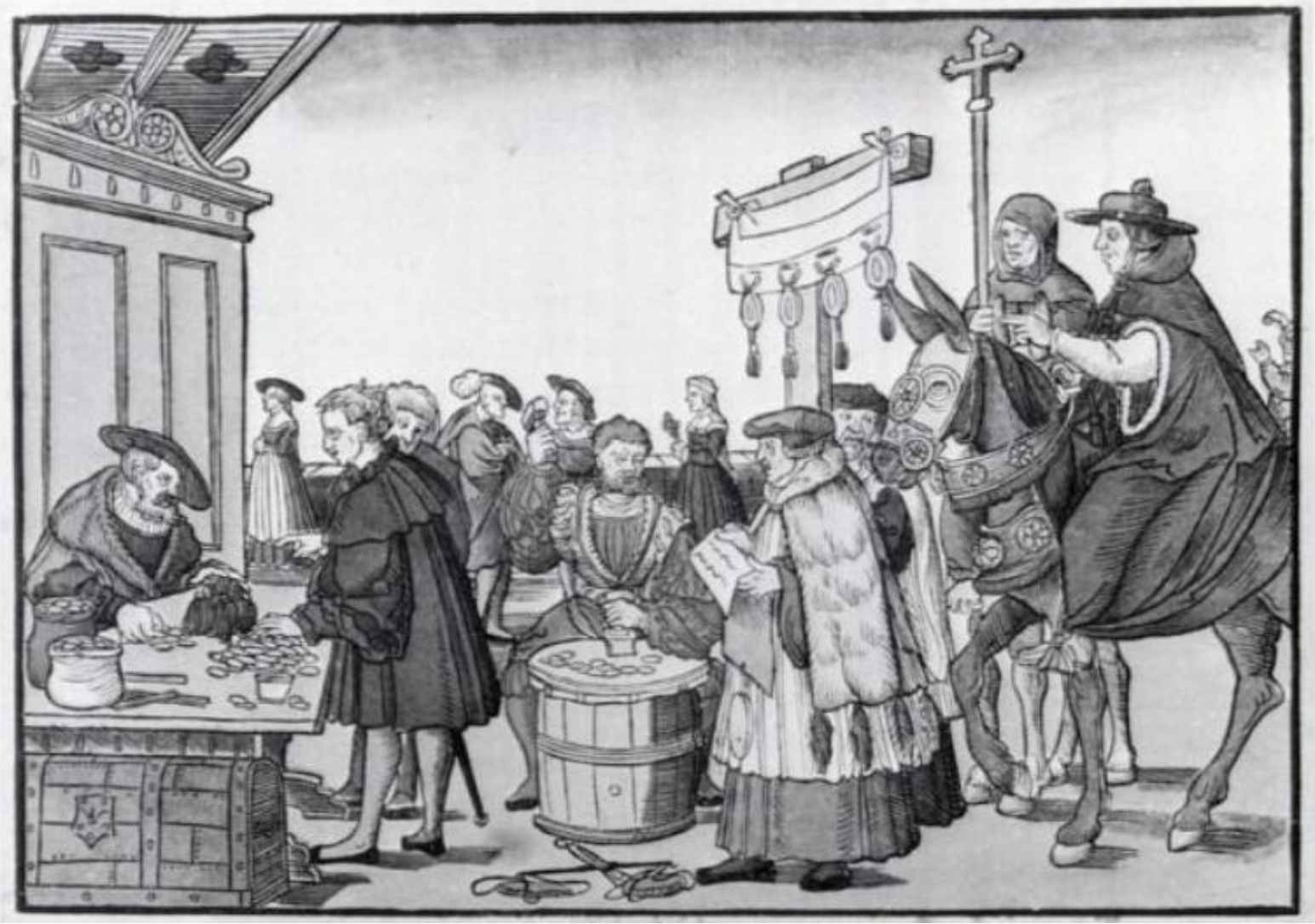
16th century woodcut depicting the sale of indulgences
When the German public caught on to the papal-approved scam, they were infuriated by the Church's distortion of God's word, as well as the Church’s unabashed exploitation of the common people.
One of the first and most famous figures to raise a stink about this injustice was Martin Luther, a pious monk and a veteran in the fields of theology and philosophy. As a young monk, Luther was characterized as an highly devout and spiritual individual. He was stern by nature, but those around him were still taken aback by how severely self-critical he was. Luther found a second home in confessionals, where he inundated the priest on the other side with flood after flood of confessions every single day. It is said his intensity grew so overwhelming that even his spiritual director found him intolerable and thus gave him other work to keep the problematic monk preoccupied.
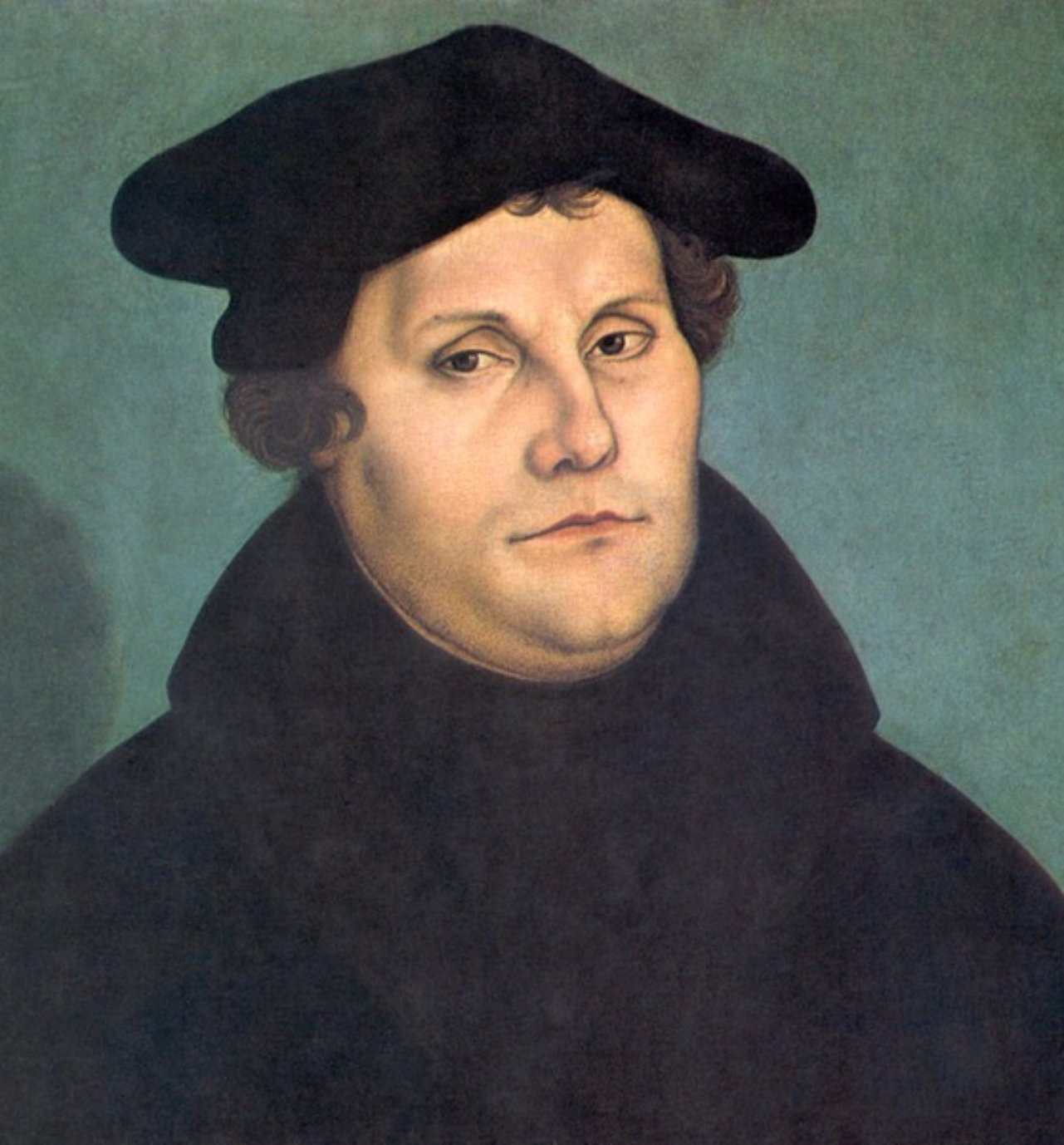
Luther
Luther became aware of the selling of indulgences in his lands sometime in 1517. While he had been critical regarding this practice before, the forcefulness of Tetzel’s campaign made him see the need for a systematic treatment of this issue. To this purpose he wrote what is now known as the 95 Theses, a document that expounded upon the errors of the indulgence practice and was originally meant for an academic disputation in Wittenberg. According to Melanchthon’s biographical account, he also nailed them to the Church door in Wittenberg, “presumably to publicize the colloquium”, though modern scholars now believe Luther’s famous act of defiance was an apocryphal story.[1]
As Luther later recounted, he had attempted first to write to the Bishop Albrecht of Mainz but received no reply because the high Church official was also deeply involved in the matter:
“… for he [Albert] was elected bishop of Mainz with the agreement that he was himself to buy the pallium [woolen mantle worn by archbishops as a symbol of office] at Rome. For three bishops of Mainz… had recently died, one shortly after the other, so that it was perhaps difficult for the diocese to buy the pallium so often and in such quick succession, since it cost twenty-six or thirty thousand [gulden]…
Thus the bishop devised this scheme, hoping to pay the [banking firm of] the Fuggers (for they had advanced the money for the pallium) from the purse of the common man. And he sent this great fleecer of men’s pockets [Tetzel] into the provinces…And in addition the pope had a finger in the pie as well, because one half was to go towards the building of St Peter’s Church in Rome.”[2]
At the time, however, Luther was not aware of who stood to profit directly from the money gained as a result of selling indulgences, basing his critique solely on the theological issue. Luther insisted that salvation and forgiveness for one’s sins could not be bought with guldens but had to be obtained through genuine repentance and contrition, despite the propaganda to the contrary.
The 95 Theses also questioned the pope's legitimacy in a sentiment many shared but dared not vocalize: “Why does the pope, whose wealth today is greater than the wealth of the richest Crassus, build the basilica of St. Peter with the money of poor believers, rather than with his own money?”
Luther’s work had the advantage of coming right around the time Gutenberg’s printing press made the mass distribution of written works possible, and as a result, the “95 Theses” became a massive hit with people, thereby sowing the seeds of the Protestant Reformation. All across Europe, more of these “reformers,” as they would be called, began to stand up to the Catholic Church. One of the most momentous turning points of the movement took place in England. There, the people, too, had begun to raise their guards against the Catholic Church. Everything seemed to come with a price – baptism, marriage, even burials. Those who wished for a place in Heaven would have to reserve an expensive plot on the Church-owned “holy” land, or so the Catholics preached. It was King Henry VIII who called for an official split from the Catholic Church. The monarch had wanted a divorce from his wife, Catherine of Aragon, due to her failure to conceive a male heir to the throne, a request that was rebuffed by the Catholics. Henry's eventual breakup with the Catholic Church led to the establishment of the Church of England. From that point on, Christendom was halved right down the middle – the Catholics and the Protestants, each side equally unyielding.
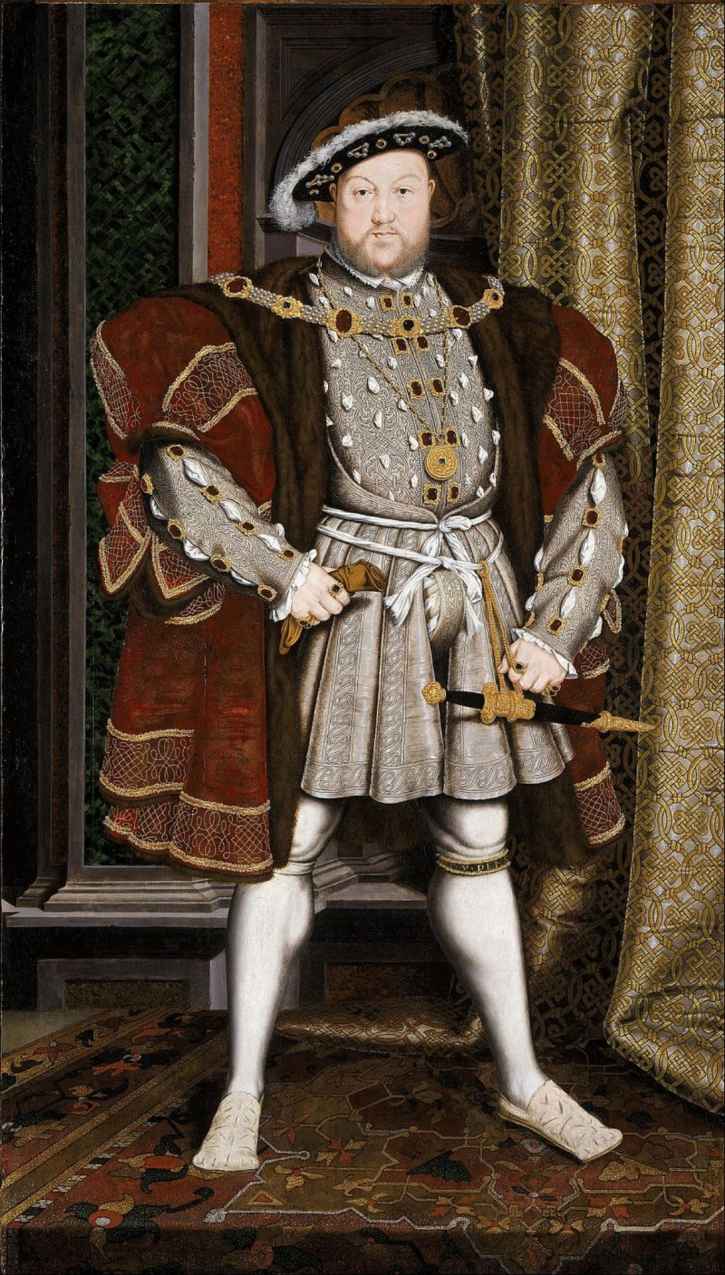
Henry VIII
Another critical contributor to the Protestant Reformation was John Calvin, widely credited as Luther's successor, and for breeding the second generation of Protestantism. Born in Noyon, France, Calvin is mostly remembered for his cool and logical disposition, as well as his intrigue with God and theology at a young age. When Calvin became a law student at the University of Orléans, he opened his eyes to Protestantism. From there, this intrigue turned to a calculated obsession.

Calvin
In 1536, Calvin authored the “Institutes of the Christian Religion,” a document that outlined his reformed views on Protestant beliefs. The ideas are best summed up with the acronym, “TULIP.” To begin with, “T” represents “Total Depravity,” meaning that humans are completely powerless, and cannot know God unless they are touched by God's own grace. Sinners are trapped in their sinful states, all exits bolted shut by God's fury. This idea is traced back to the biblical passages of Romans 3: 10–11, which reads, “As it is written, 'No one is righteous, no, not one; no one understands God, no one seeks for God.”
“U” is for “Unconditional Election.” This suggests that God has “predestined,” or has already chosen a select group of the saved. Only He holds the key to salvation. No matter how high or low humans go to search for this key, those who have not been “chosen” will only be thwarted by dead ends.
“L” is for “Limited Atonement.” This corresponds with the previous point, and illustrates that Christ has only saved Himself for a chosen group of people. While Christ may have been able to sacrifice Himself for all, He had only done so with the “elected” in mind. This rather grim revelation is supposedly supported by John 17:9, which states, “I am praying for them. I am not praying for the world, but for those whom you have given me, for they are yours.”
“I” is for “Irresistible Grace.” Sinners may initially reject God's love, but once they have been kissed by His spirit, they are incapable of resistance. As the almighty being that rules above all, God never fails when He chooses to redeem a soul on His list. Finally, “P” stands for “Perseverance of the Saints.” This reaffirms that divine salvation is forever binding, as God would never allow the saved to slip through the cracks of His fingers.
The earliest Calvinist ideology revolved around sola scriptura, which meant that scripture held ultimate authority above everything in life. Calvinists believed that the Bible was a “direct revelation” from God, which clearly laid out the bylaws for His creation. The Holy Book, therefore, held divine authority.
Apart from the theory of “predestination,” Calvinists believed – and still believe – in the sovereignty of God. The flawless and all-knowing God is said be in complete control over all that He has created. All that occurs in this world has already been carefully calibrated and planned out by the Lord. As God does not make mistakes, everything happens for a reason.
Many often misunderstand the meaning behind “predestination” and conclude that Calvinists do not believe in free will, as humans are supposedly powerless to change the courses of their own paths. Calvinists, however, do believe in a limited sense of free will – humans are perfectly capable of making their own choices, but only within the scope of “their nature.” Calvinists claim that it is impossible to “choose salvation.” While the sick might choose to undergo medication that may prolong their lives, dead men have no say in their unchangeable fates.
Though Calvinists might have been aware that God has already chosen his children, they know that humans have no way of procuring that classified list. It is then an individual's responsibility to make good choices and lead a life of wholesome Christian living. That being so, the individual is responsible for spreading the word to all they come across, and hope for the best.
Calvin dwelled in Geneva, Switzerland for a short spell until he was driven out by Catholic authorities in 1538. 3 years later, Geneva reopened their borders to Calvin, welcoming him back aboard as the head of the church. By then, he was one of the most respected spiritual and political leaders in all of Europe. Calvin's reign was peaceful and more or less uncontested, particularly in his final years. Apart from the various reforms he brought with him, Calvin housed “Marian exiles,” or British Protestants fleeing from the Catholic monarchs in England. Genevan ministers were dispatched to all corners of Europe, including England, Netherlands, Scotland, and even the New World, bearing Calvin's rendition of God's Word. Nearing the top of Calvin's agenda were his intentions to reform France, his projects funded by the Church of Geneva. 100 of his best missionaries were stationed in his homeland, where they began to distribute pamphlets and other literature through an underground press network, away from the probing eyes of the authorities.
Geneva was established as the center of reformed Protestantism. As Calvinist pastors scattered across Europe, their various churches would soon develop names and communities of their own. The English Protestants came to be known as the “Puritans.” In Scotland, they became the “Presbyterians.” The Netherlands became home to the Dutch Reformed Church, the largest Christian denomination during the reformation era. Last, but not least, there were the French Protestants, who were later dubbed the “Huguenots.”
The unconventional ideas of the flourishing Calvinist movement were especially controversial in a time when most of Europe was either Roman Catholic or Lutheran Protestant. Many dispelled Calvin's “radical” beliefs; the idea of having not an iota of control over their own fates or salvation, even through prayer or repentance, was unfathomable to the traditionalists. Still, a separate fraction knew of Calvin's legal background, and they were drawn to his logical dissection of Christianity's principles.
While many praised Calvin for his fresh perspective on an age-old religion, he was also knocked for leading a stringent, almost draconian reign. Creativity was stifled – all forms of art and music, apart from somber singing, was outlawed. Voices were silenced – at least 58 were executed, and another 76 banished for their non-Calvinist beliefs.
The tables were soon to turn.
Royals vs. Huguenots
“We have come to the determination to die, all of us, rather than abandon our God, and our religion...” – Jeane d'Albret, Queen of Navarre, to Catherine de Medici, Queen of France
In addition to the religious underpinnings of the Reformation that would bring about the conflicts between French Huguenots and French authorities, a number of important people played decisive roles in the events to come. First, there was Catherine de' Medici, the daughter of Lorenzo de' Medici, an Italian prince and the ruler of Florence, and his wife, Madeleine, the Countess of Boulogne. Catherine's birth was said to have delighted the giddy parents “as if it had been a boy.” Unfortunately, the baby girl would lose both her parents within the span of a month; Madeleine had succumbed to a horrible fever brought about by the plague, while Lorenzo perished shortly thereafter from complications due to syphilis. Baby Catherine was first passed on to Lorenzo's mother, and her guardianship later entrusted to her aunt, Clarice.
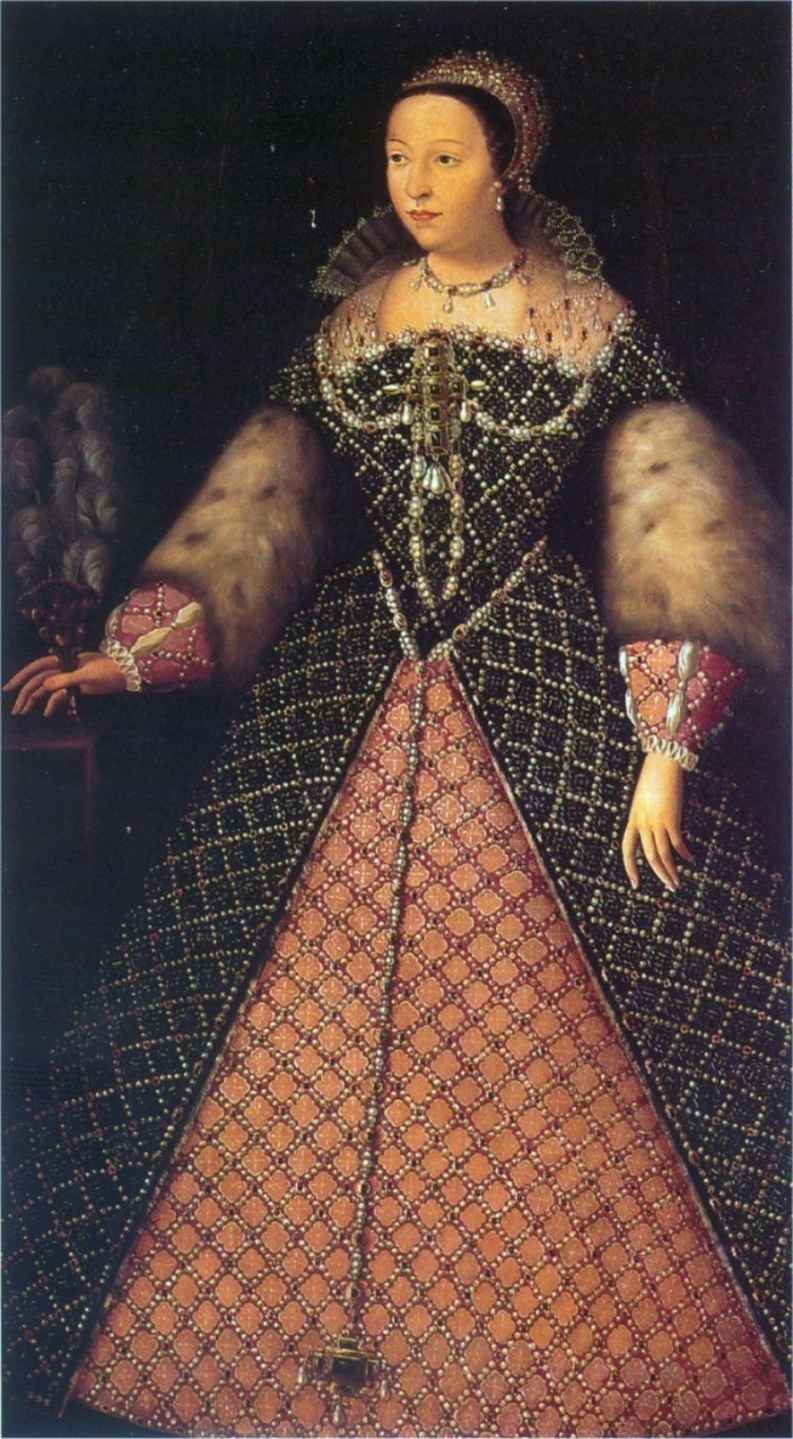
Catherine
The de' Medici family tree boasted branches of royal and noble connections that tied them to the most prominent figures in all of European society, including Pope Leo X and Clement VII, both of whom were related to Lorenzo. The popes were said to have spotted a special glimmer of promise in young Catherine's eyes, and since she had been born only 2 years after Martin Luther's publication of the “95 Theses,” and thus in the thick of the Protestant pandemonium, they seized the opportunity to mold her into the God-fearing Catholic she would one day become.
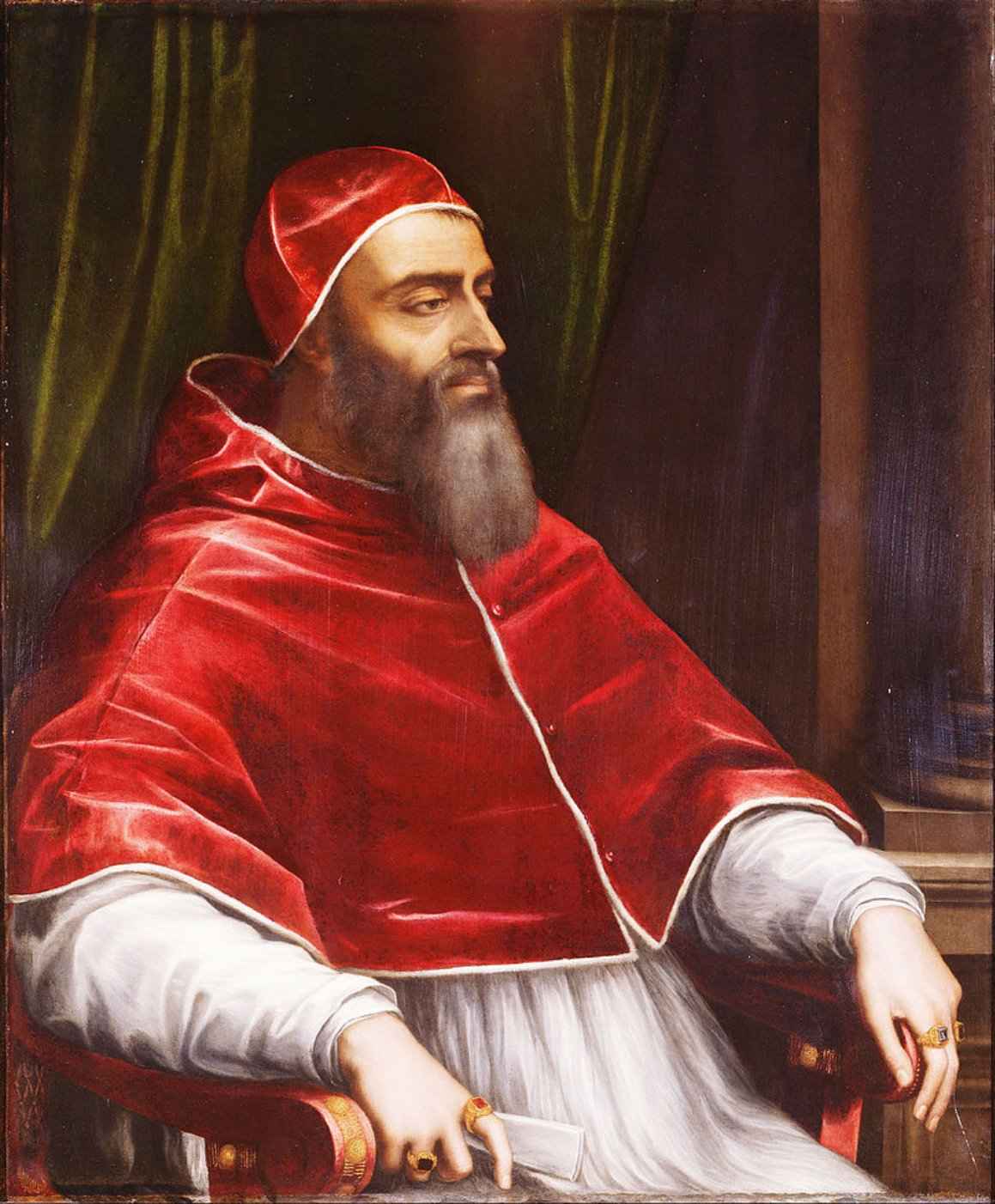
Pope Clement VII
In 1533, Pope Clement played matchmaker for 14-year-old Catherine and Prince Henry, the Duke of Orléans and the son of King Francis I of France, but the pair failed to make a connection. Just a year after the wedding, 15-year-old Henry entered a lascivious affair with a 35-year-old noblewoman, Diane de Poitiers, who had looked after – or perhaps, groomed him – throughout his tainted childhood. Diane was a certified stunner with a “skin of great whiteness,” and she was unusually athletic, maintaining her youth through the religious intake of a golden elixir, a concoction of gold chloride and diethyl ether. The teenage Henry was hopelessly smitten.
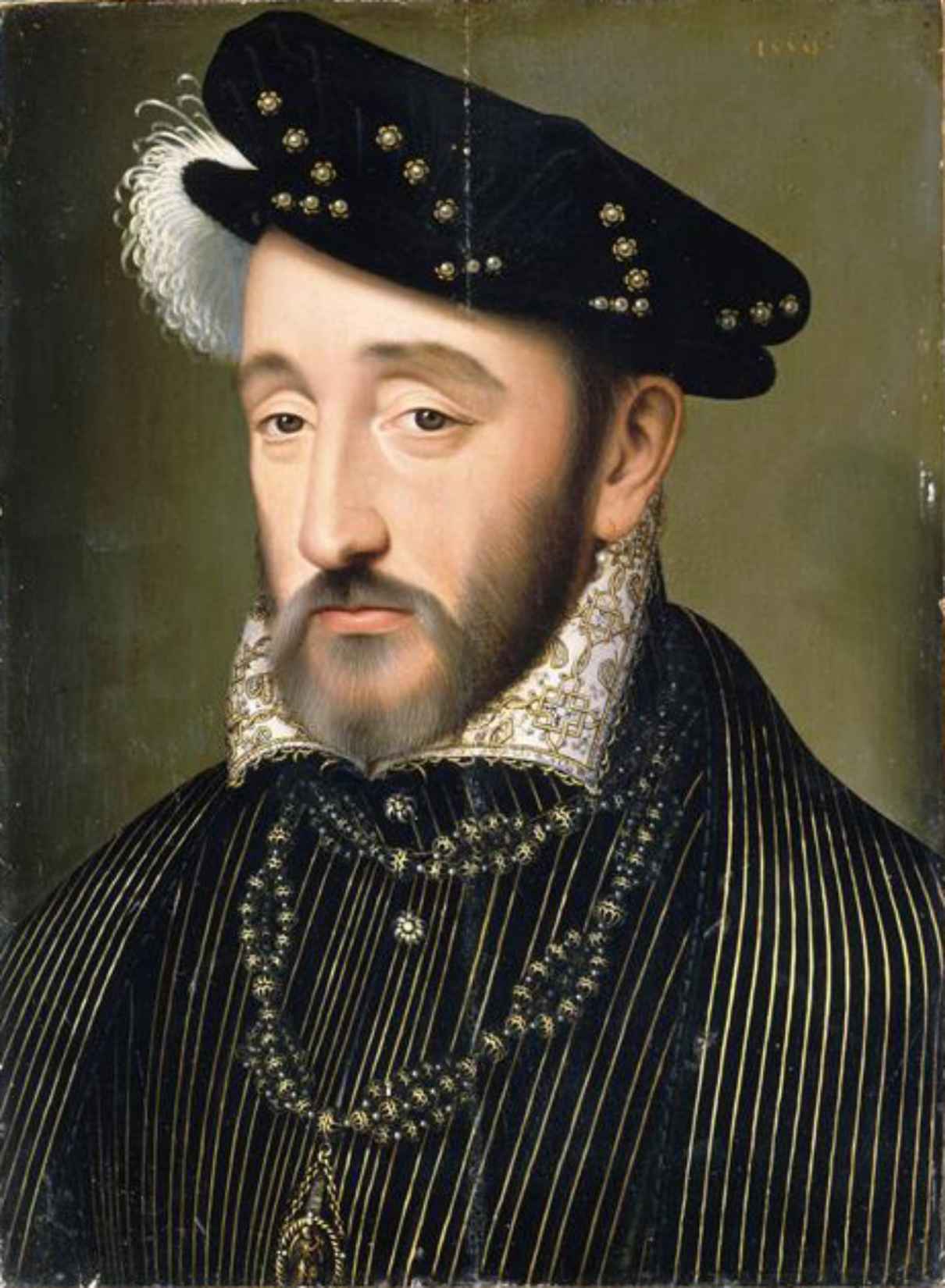
Henry II of France
In 1536, Henry's brother, 18-year-old Francis III, collapsed after taking a drink of water following a tennis match. Lamentably, Francis died several days later, which prompted rumors that his water had been laced with poison, but either way, with Francis’s death vacating a spot in the queue to the throne, Henry and Catherine were bumped up to the front. As anticipated, when King Francis passed on in 1547, Henry and Catherine were crowned King Henry II and Queen Catherine of France.
In the beginning of her reign, Catherine was no more than a titular puppet, and Henry made it no secret that he favored his mistress over his own wife. Henry and Diane were often seen entangled in each other's arms in public, even occasionally with Henry caressing Diane's breasts in full view of Catherine. While Diane was said to have secretly manned the operation behind the scenes, she allowed Henry to sleep with Catherine so they could produce valid heirs to the throne. Together, the husband and wife would have 10 children, and of the 10, 6 would survive to adulthood, among them sons Francis, Henry III, and Charles IX.
In an effort to unite against Protestantism in 1559, France and Spain decided to join forces, settling a decades-long territorial dispute with the Peace of Cateau-Cambrésis. This treaty was cemented with the matrimonial union between Prince Philip II of Spain and Catherine and Henry's daughter, Elisabeth.

Elisabeth
As fate would have it, their wedding bliss was promptly cut short when the French king was impaled in the eye by a lance during a jousting competition as part of a celebratory tournament in 1559. The tip of the lance pierced past his eyeball and into his brain, and Henry died a few days later of septicemia, which propelled their 15-year-old son, Francis II, to the throne. At 15, monarchs did not require a regent (a guardian who acted on their behalf), but given how green Francis II was, someone had to step up to the plate. Ultimately, regency was given to the uncles of his young wife Mary, Queen of Scots, meaning the monarchs of Scotland would at least temporarily control the French throne.
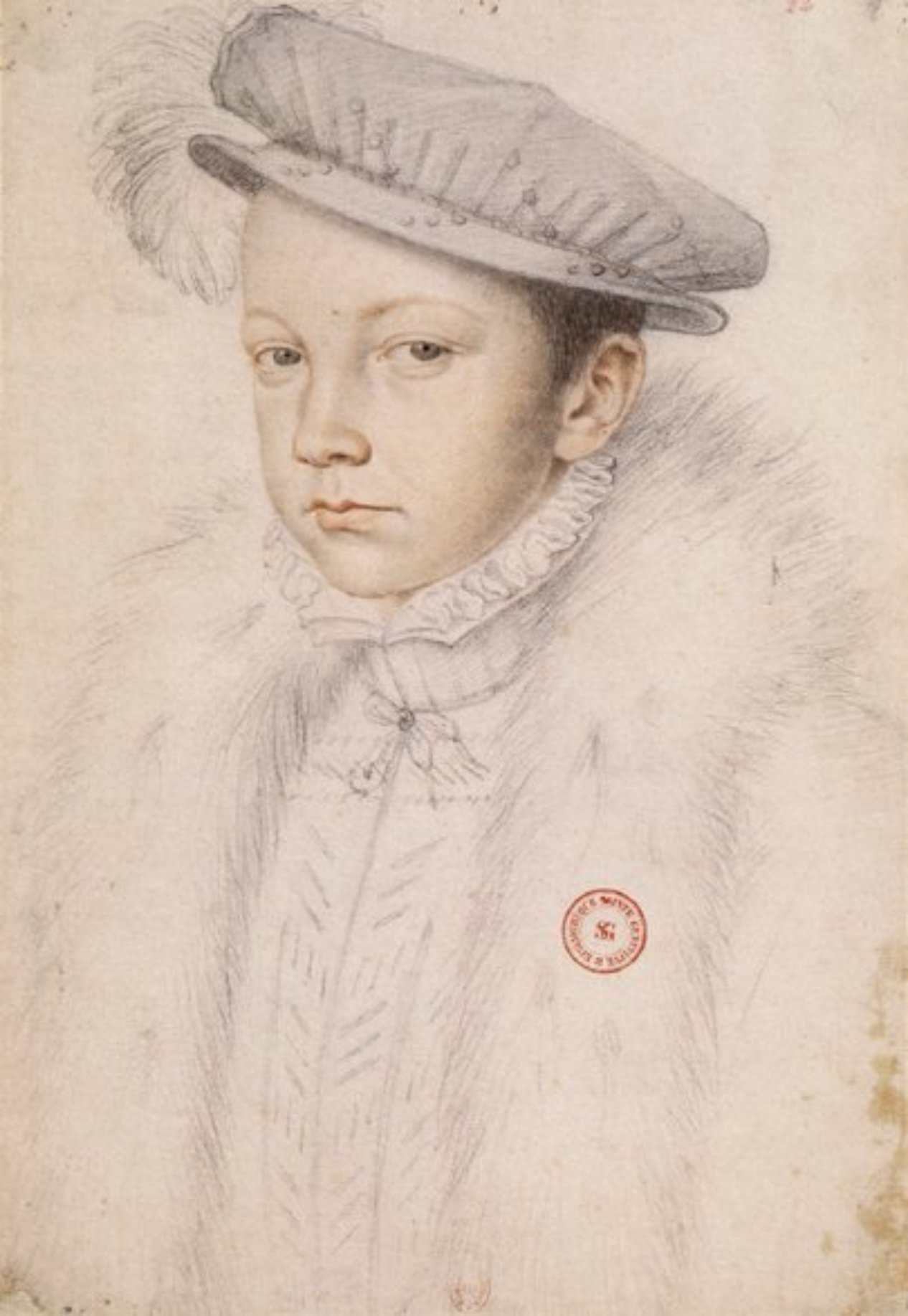
Francis II
It was around the beginning of Francis's rule that friction between the Catholic French and Huguenot Navarre royals truly began to whip up. Just a year into the Scotland-manipulated reign, Huguenot rebels sensed the vulnerability of the throne and pounced on the chance to eject Francis from his coveted seat. Luckily for him, the plot was discovered, and all 57 conspirators were sent to their immediate deaths.
When the sickly 16 year old king died from complications of an ear infection the year after, his 10-year-old brother, Charles IX, took his place. Deciding that it was high time for her to shine, Catherine eagerly accepted the available post of regency.
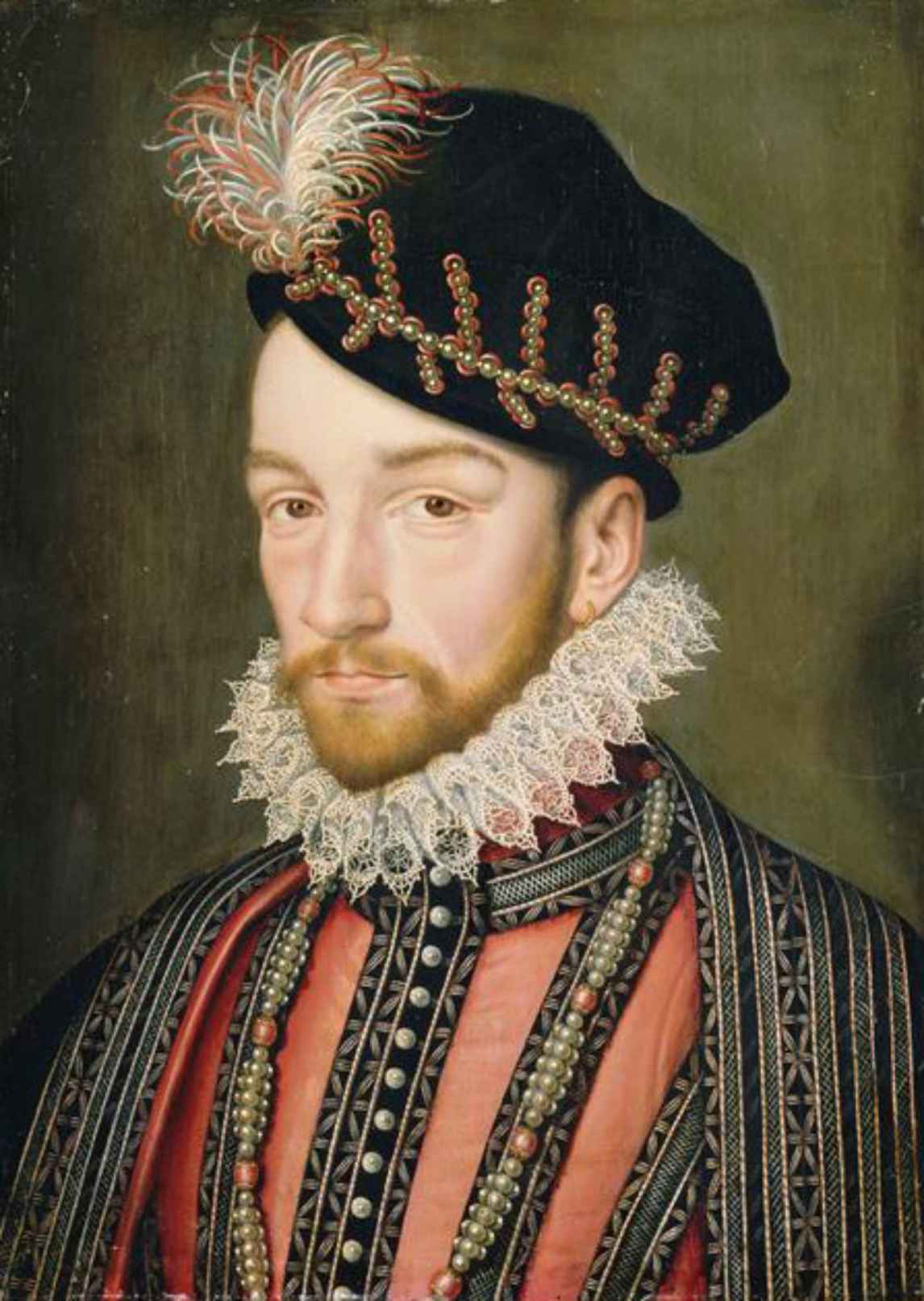
Charles IX
Another influential individual at this juncture was Jeanne d'Albret, the Catholic-raised cousin of the French royals, and the daughter of King Henry II of Navarre. At the age of 14, she, too, would be married off to William, the Duke of Cleves. Jeanne was strongly opposed to this decision, and heartily protested the marriage until her wedding day; in fact, the princess was said to have been so defiant that she had to be swept off her feet and carried to the altar, kicking and screaming. To Jeanne's relief, before the marriage could be consummated, the union was annulled with a papal stamp of approval, and in 1548, the 20-year-old Jeanne instead married the French royal Antoine de Bourbon, the Duke of Vendôme. The pair produced 2 children: Henry IV and Catherine de Bourbon.
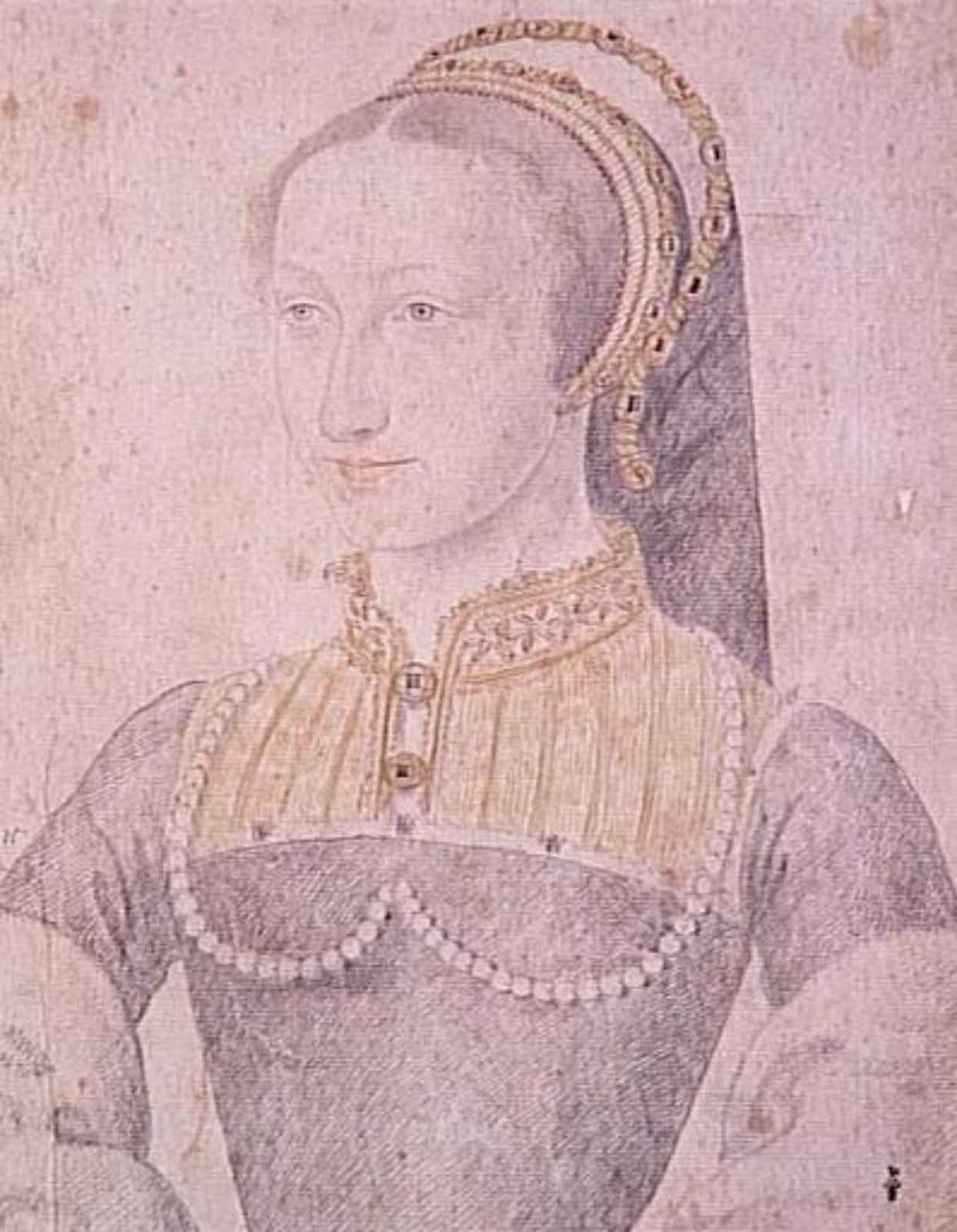
Jeanne
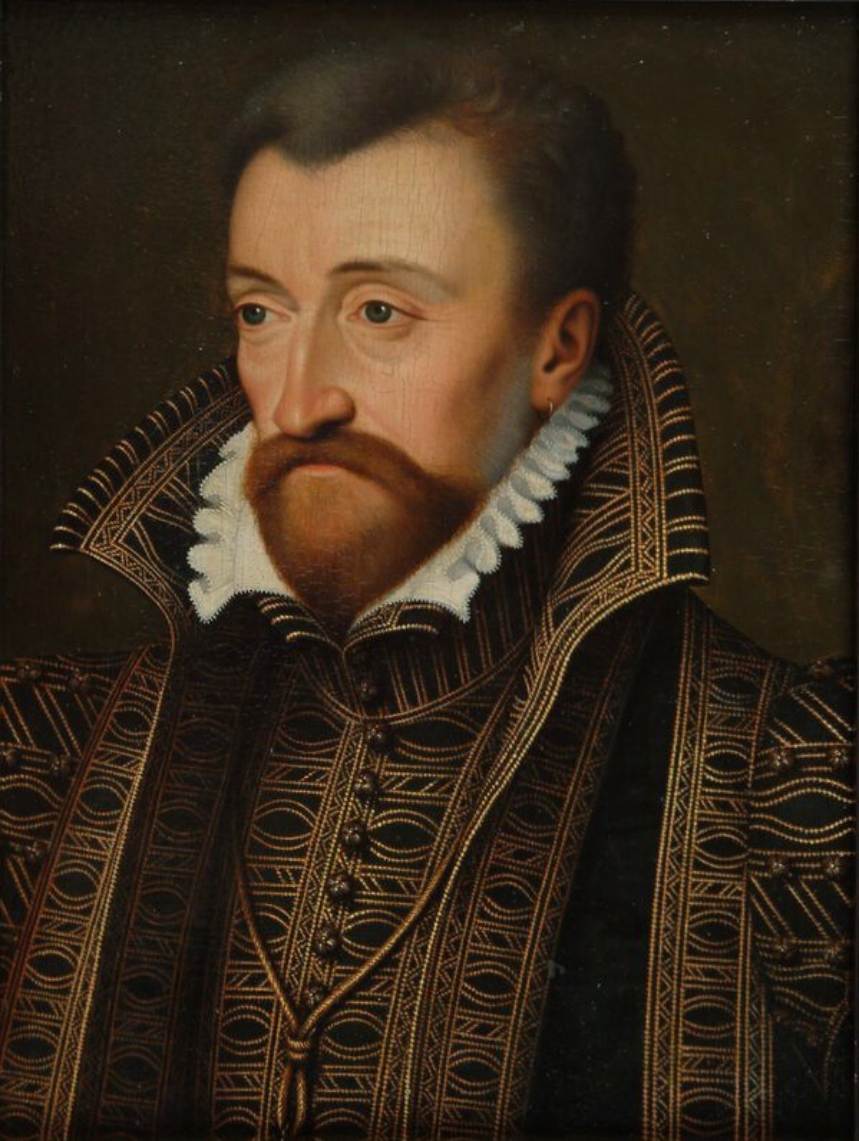
Antoine
Jeanne became the Queen of Navarre upon her father's death in 1555, and on Christmas Day five years later, she announced her conversion to Calvinism for the first time and declared it the official religion of her kingdom. This bold move made her the highest-ranking Protestant in all of France, and the Catholic Church just as quickly labeled her public enemy number one.
Jeanne displayed an unswerving discipline many never would have imagined from such a small, unassuming woman. She outlawed Catholicism, shut down one Catholic church after another, and banished nuns and priests by the dozens. She then ordered for a translation of the New Testament and distributed them among her subjects. At first, though it appeared as if her husband had also been converted, he did an about-face when he was offered dominion over Sardinia, an Italian island then owned by the Catholic King of Spain. But even then, Jeanne's shatterproof support remained with the Huguenots.
Apart from the dampening duo's religious differences, Jeanne and Antoine's amicable marriage began to crumble as they began to bicker over how they would raise their son, Henry. Antoine, under pressure from his own family, was said to have verbally and physically assaulted his wife repeatedly over this issue, often dangling the subject of divorce over her head. Antoine had even once flown into such a rage that he shoved her into a room and locked her up for days, but Jeanne would not falter from her new faith. She continued to promote Protestant teachings and hosted Huguenot ceremonies in her home.
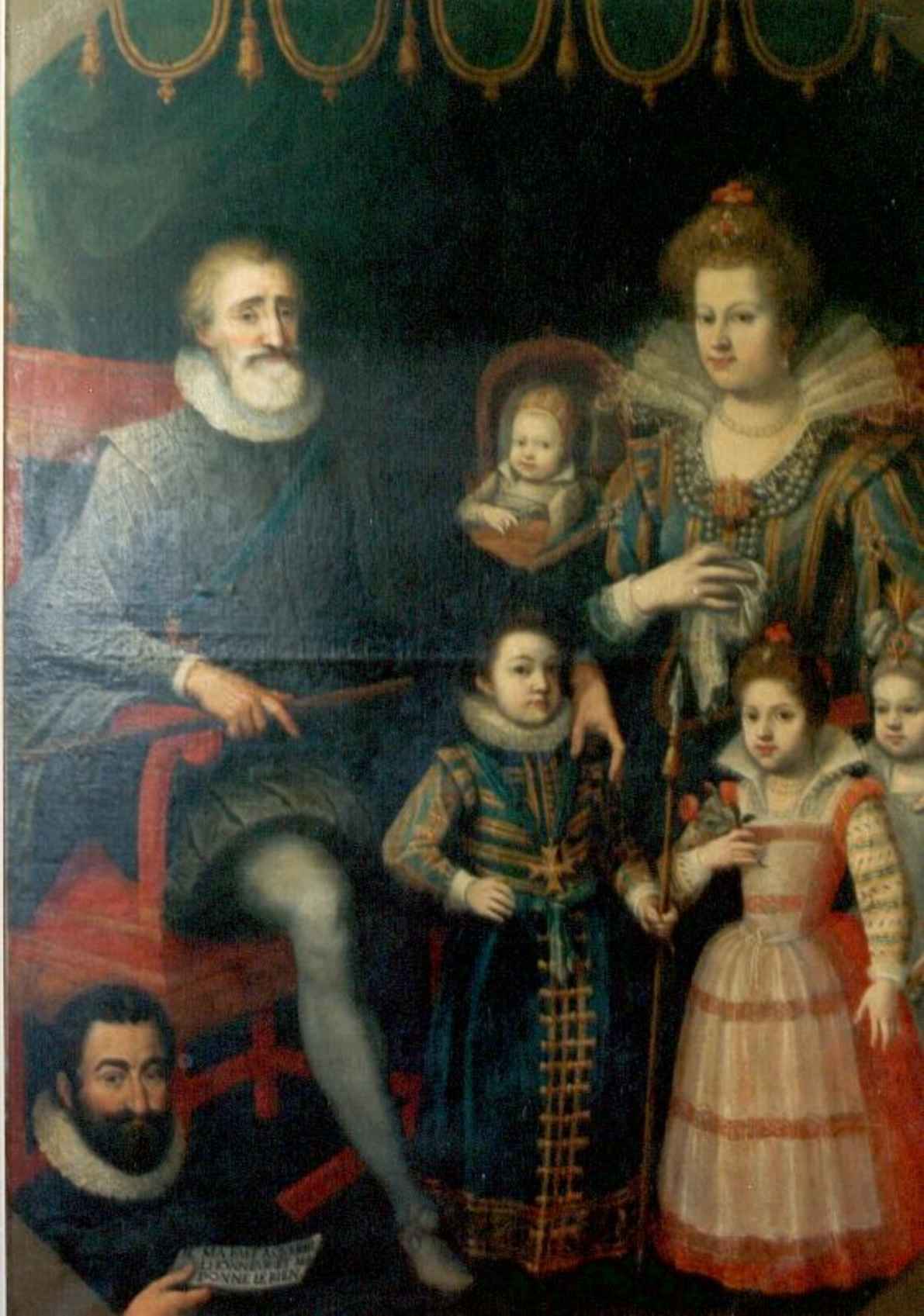
Henry IV
Word of the quarreling couple's abusive marriage eventually spread, and when Catherine de' Medici learned of their marital issues, she reached out to Jeanne and pleaded with her to heed Antoine's words and reconvert to the Catholic faith. However, all attempts fell flat, and Jeanne's loyalty to the Huguenots would never be forgotten. Today, she is hailed as one of the first leading figures and religious reformers of the Huguenot movement.
Throughout the 1560s, Catherine, as regent, had chosen to keep her nose out of the ongoing Protestant and Catholic wars, but the swelling population of Huguenots could no longer be ignored. By 1562, there were an estimated 2 million of the “heretics” in France. It was time to get her hands dirty.
In 1563, her dead husband's brother, Francis, the Duke of Guise, attempted to reclaim Orléans from the Huguenots but was fatally wounded by an assassin. A French admiral and avid Huguenot, Gaspard II de Coligny, along with another Protestant pastor, were accused of engineering the plot. The scoffing admiral swiftly asserted his innocence, but the embittered deceased's son, Henry I, who would soon be upgraded to the Duke of Guise, began to bear a jaundiced grudge against Coligny. Coupled with Queen Jeanne's protection of the Huguenots, who fought to seize control of France, the building tension between the Catholics and the Huguenots boiled over in 1562, spawning 8 civil wars in succession. These conflicts are now known collectively as the French Wars of Religion.
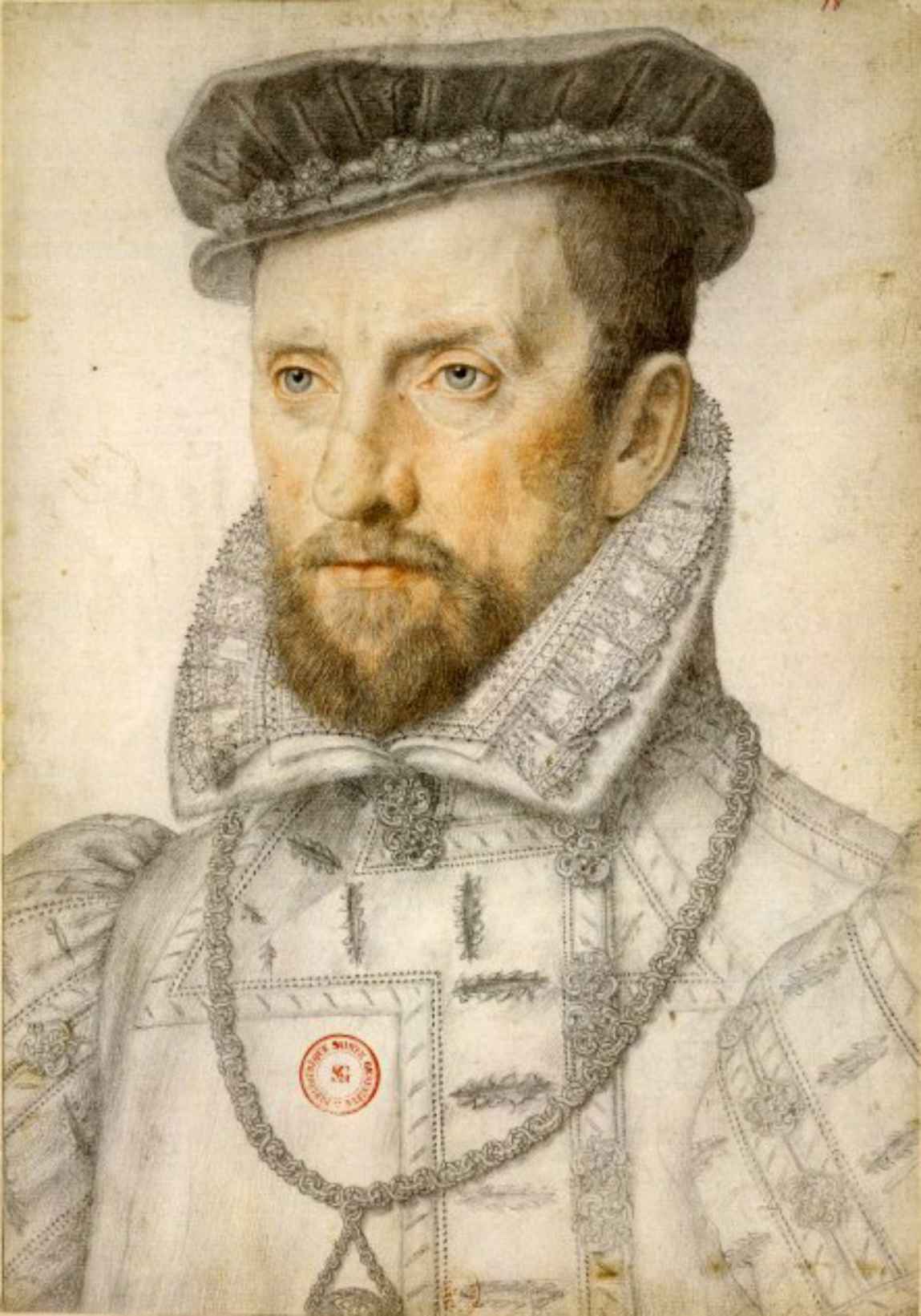
Admiral Gaspard II de Coligny
In 1570, the signing of the Peace of St. Germain halted the wars with a relatively brief interval of harmony and order. The terms of the treaty were made official through the arranged marriage of Catherine's daughter, Marguerite, and Prince Henry, Jeanne's son, which was scheduled for mid-August in 1572. As per the treaty, the Huguenots received dominion over several portions of southern France, which included Cognac, Montauban, La Rochelle, and La-Charité-sur-Loire. Another stipulation saw Admiral Coligny making his way back to his seat in royal court.
French Catholics were appalled by the decision to allow a Protestant back in court, and both the pope and King Philip II of Spain were among the most outspoken critics of the decision. Catherine knew full well of the controversy but bit the bullet anyway, hoping that Coligny would use his reinstated position to help quell the Huguenot outcries. Meanwhile, she would do her part with the Catholics.
The French public, both Protestant and Catholic, also took issue with the upcoming wedding. Devastated by unproductive harvests and a spike in food prices, they blamed the monarchs for the failing economy, and they were also aware the extravagant wedding would be funded with the taxpayers' money, which left a bad taste in their mouths. John Calvin's Readings on the Prophet Daniel, published 3 years prior to his death in 1561, did not help matters, as it firmly declared that all monarchs who disobeyed God “automatically abdicate[d] their worldly power.” The Huguenots took this to heart, intensifying their resentment towards the Catholic monarch.
Catherine was reluctant to face the critics among her Catholic counterparts, but she soon began to regret her decision. Coligny had grown suspiciously close to King Charles IX, solidifying that bond as her son's personal adviser and most trusted confidante. It is believed that Catherine feared that her impressionable and naive 22-year-old son would fall victim to Coligny's Huguenot influence. Worse yet, she suspected that Charles was nothing more than a pawn for Coligny, who she believed was planning either another Huguenot uprising or a war with Spain.
On the 22nd of August, just 4 days after the royal wedding, Coligny was making his way home from the Louvre Palace when he was shot from a 2nd story window. As Coligny, who was only wounded, stumbled off for help, the perpetrator elbowed past the panicking mob, and vanished. Today, many are still unsure about who it was that contrived the assassination attempt, but the bulk of historians agree that it had been Catherine who approved it.
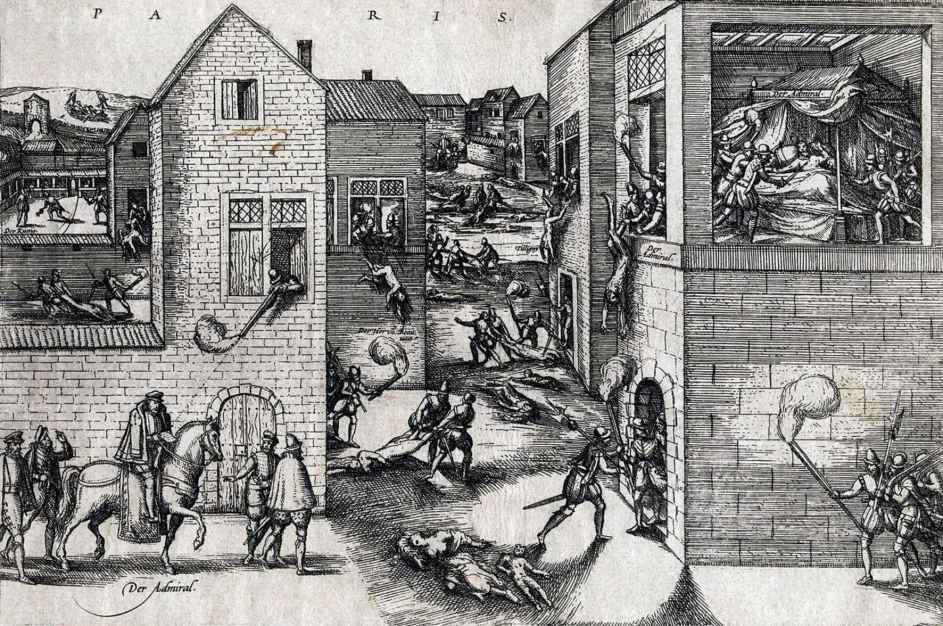
A contemporary engraving depicting the assassination attempt
An enraged King Charles set out to investigate the attempted murder to appease the Huguenots, but when he tried to pay his ailing friend a visit, Catherine quickly put a cork in it, severing all communication between the two. Once she had calmed Charles down, she managed to convince her son that the Huguenots were only a hair's away from mutiny, and she dragged Coligny's name through the mud, citing his alleged plans to seize control of the Catholic court. The king was livid. According to his brother's diary, Charles growled, “Kill the Admiral if you wish, but you must also kill all the Huguenots, so that no one is left alive to reproach me. Kill them all!”
Coligny's name was the first on the hit list. On August 24th, before dawn had even cracked, a vicious rabble, headlined by the surviving members of the Guise family, burst into Coligny's room. The dazed Coligny was pounded to a pulp before his attackers flung him out of the window, ending his agony. Catholic rebels all across Paris cried for Huguenot blood and took to the streets, rioting and joining in on a bloody killing spree immortalized today as the “St. Bartholomew's Day Massacre.” King Charles issued a decree to cease the killings the following day, but the killings continued to spill into various provinces, tapering out only in October.
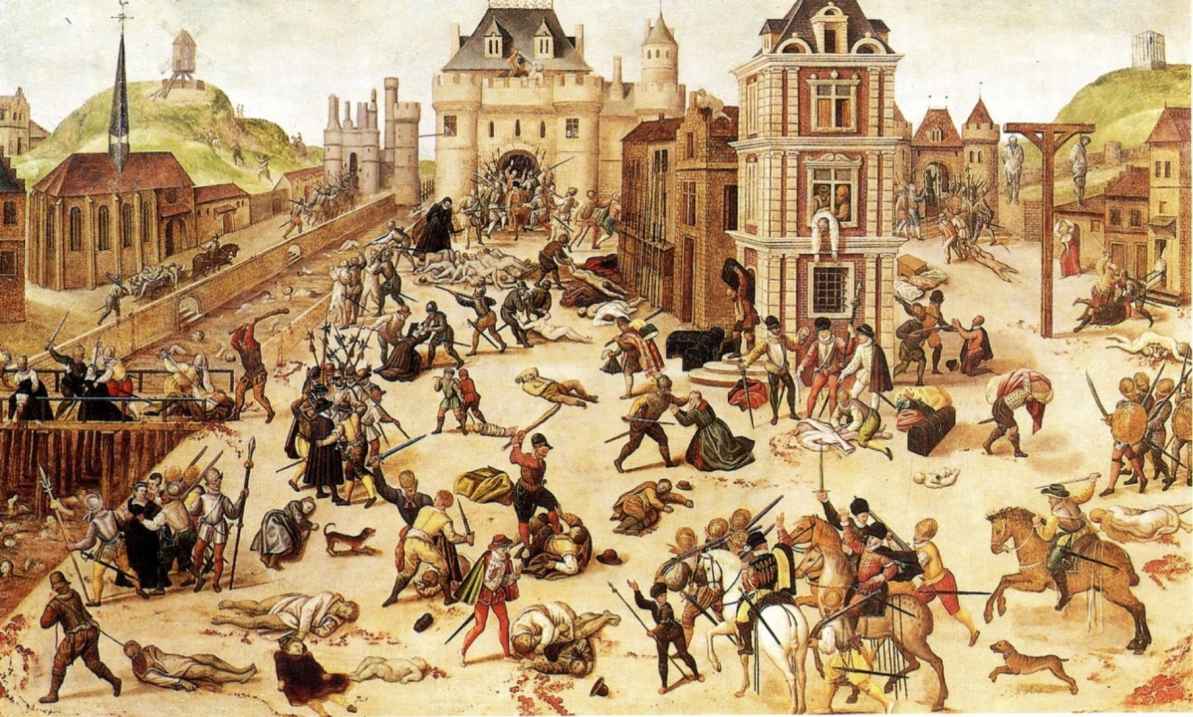
A painting depicting the massacre
The death toll from the massacre continues to be disputed, but historians estimate that 3,000 Huguenots died in Paris, and 70,000 in France as a whole. Bodies drifted down the Rhône River for months before the rotting corpses were finally cleared away. King Charles grew increasingly delirious day after day, haunted by nightmares and the cries of the dead in his ears. He once clung to his nurse, wailing, “What bloodshed, What murders! What evil counsel I have followed!” Never the same, Charles blamed his mother and himself until the day he died in May of 1574, at age 23.
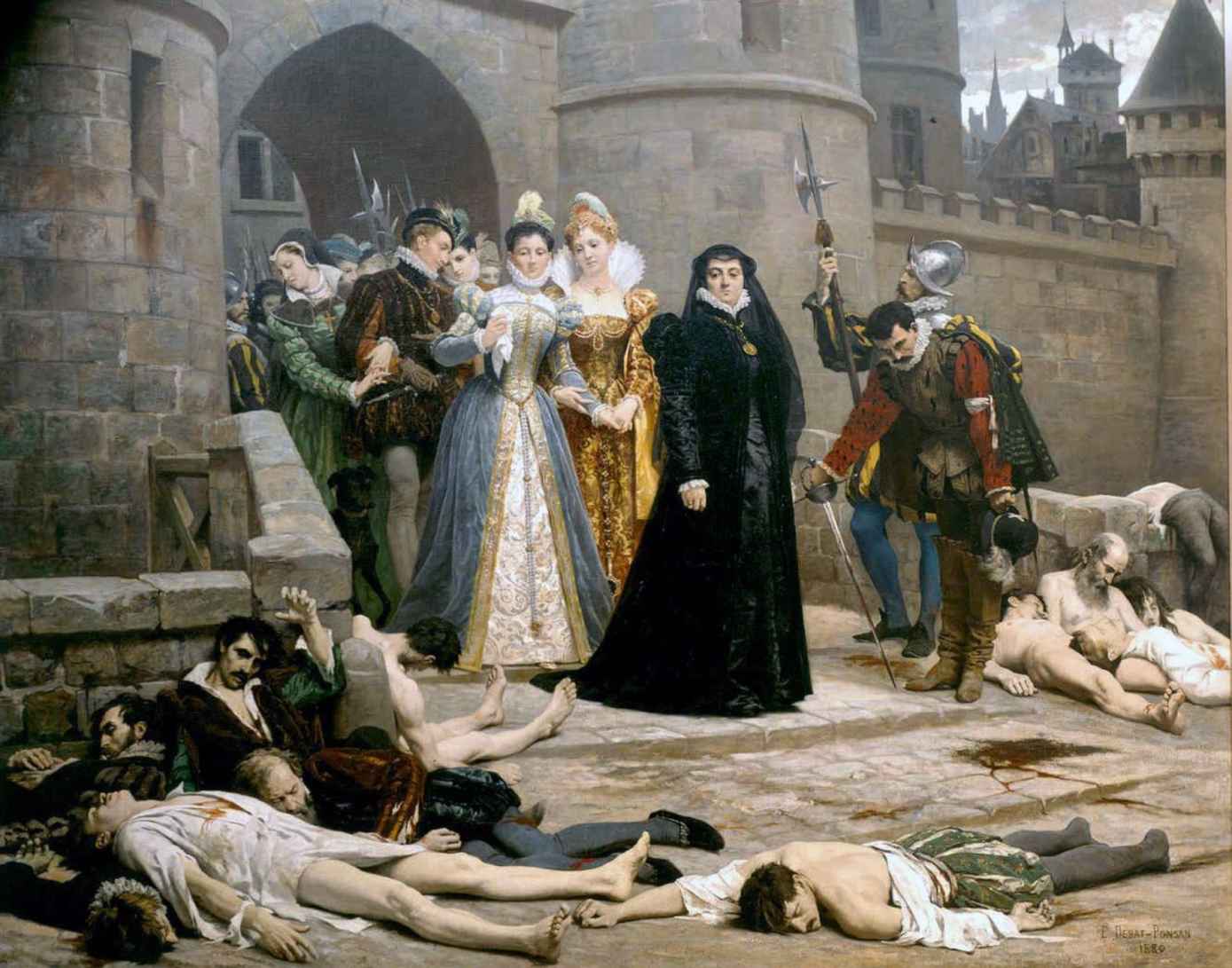
A depiction of Catherine seeing the carnage outside of the Louvre
When Charles passed on, his brother and the fourth of Catherine's sons, Henry III, claimed his seat on the throne, and he would rule until his assassination in 1589. A demented Dominican friar, who had with him forged documents, was granted permission to the king's chambers. The friar requested for the guards to stand back, claiming the document to be of utmost confidentiality. When the guards tentatively obliged, the friar sprung forth and plunged a knife into the childless king's abdomen. Since Francis, the Duke of Anjou and the last of Catherine's sons, had died 5 years ago, all eyes fell upon the son of the famously Huguenot Queen Jeanne – King Henry IV of Navarre.
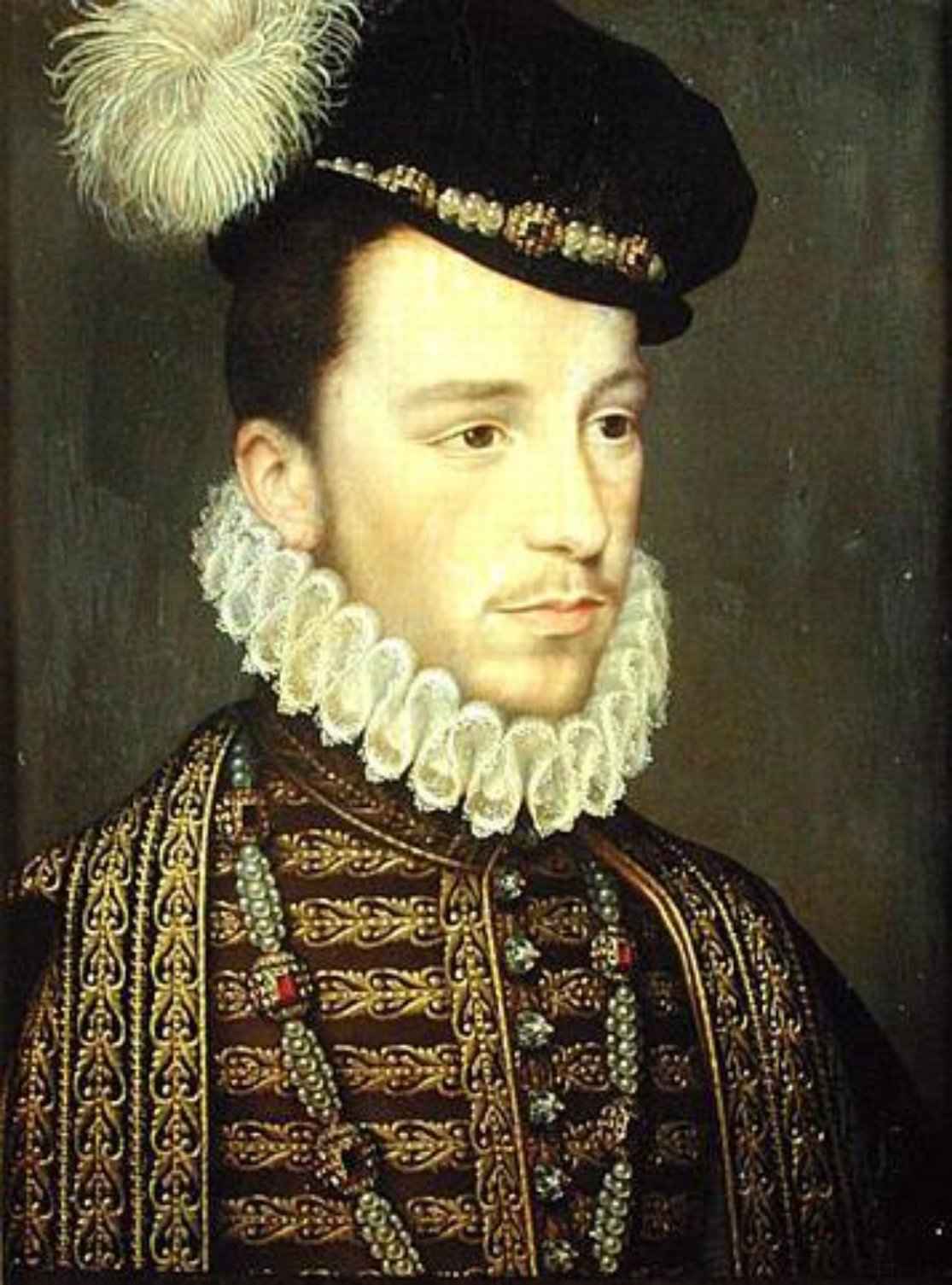
Henry III
In 1589, Henry became the first Bourbon king of the nation, and from then on, he was known as King Henry IV of France. He had born witness to the previous king's uncalculated decision-making skills – more precisely, an event in 1588 that contributed to his demise. The French Catholic public had grown discontented with the Catholic predecessor's seeming procrastination to establish solid laws that would protect France from Protestantism. Court officials were deemed lazy and incompetent. Others were convinced that the former Henry had been fraternizing with the Protestants, and was laying out the foundations for the Huguenot Henry of Navarre to succeed him. he people grew even more disconcerted by the presence of Swiss and French guards in Paris, placed there by Henry III. The uprising that ensued is now known as the “Day of the Barricades,” which saw the disgraced king's ugly defeat in Paris. The humiliated Henry III vengefully ordered the deaths of several prominent Catholic members of the Guise family, including his own brother, a decision that would ultimately cost the king his life.
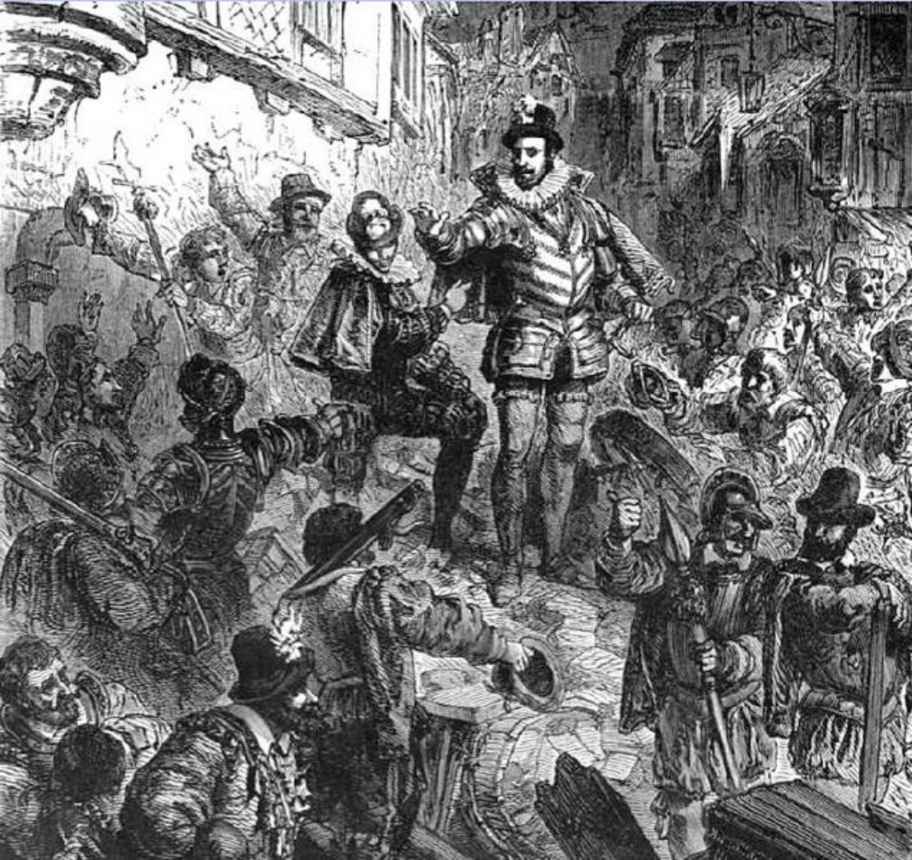
A depiction of the Duke of Guise during the Day of the Barricades
Now that he was in charge, King Henry IV hoped to bring an end to all the religious hostility. The only way to achieve this, he believed, would be to establish a society that ensured equality for all. Thus, on April 13, 1598, Henry signed the Edict of Nantes. The signing of this treaty ended the French Wars of Religion, which had taken the lives of over 3 million already. The document contained 92 articles that promised political and social equality for all of France, even the Huguenots. The Huguenots were now free to practice their religion, either in private, or publicly on Protestant-owned land, with no repercussions. As accepted members of society, they were granted equal education and health care, and were now allowed to inherit land and property. On May 2, amnesty was bestowed upon both sides of the war. Furthermore, the new king recompensed Protestant pastors, and provided financial support to 50 Huguenot towns.
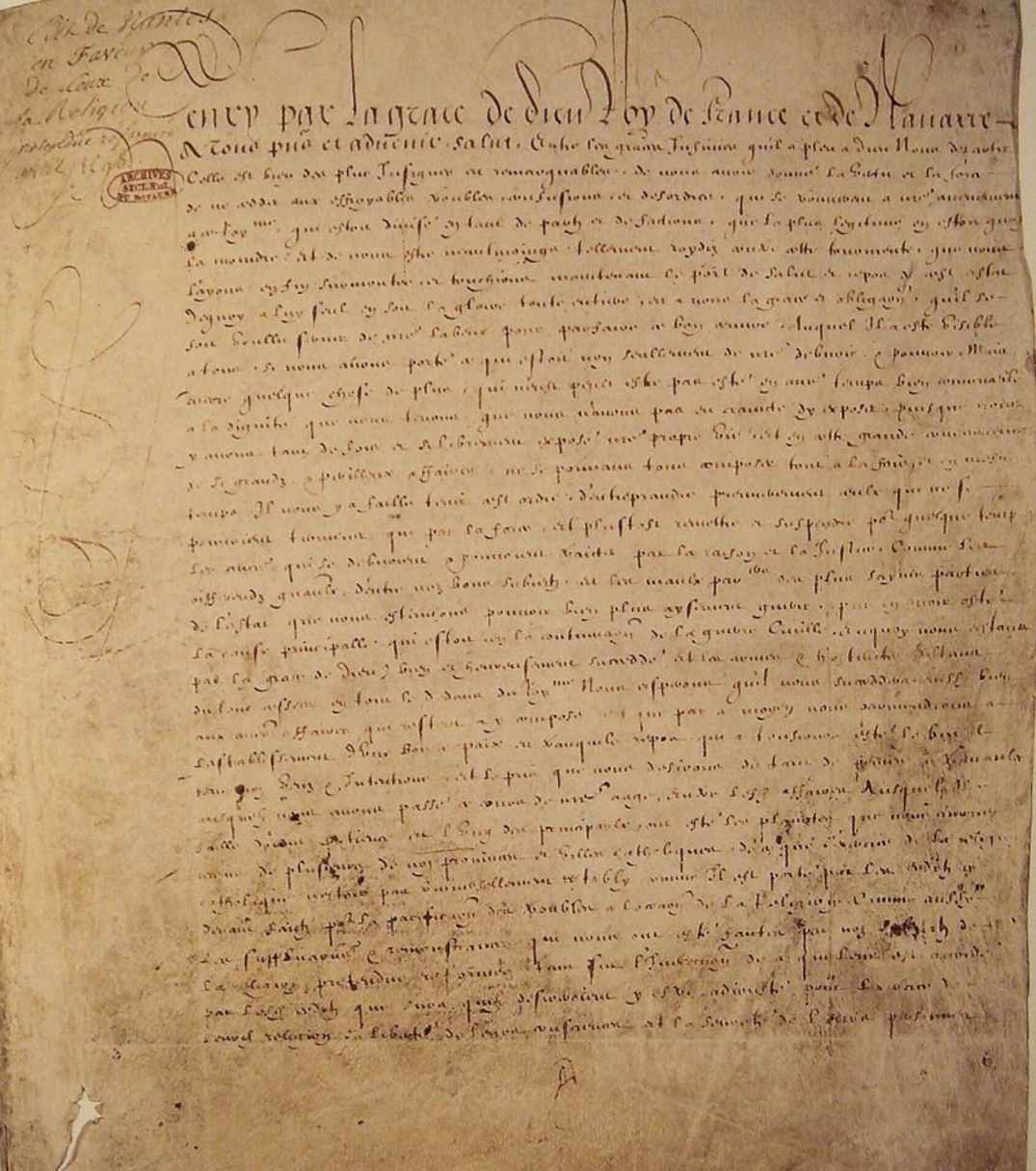
A copy of the Edict of Nantes
Despite Henry's attempt at peace and toleration, not everyone was bouncing with glee. Henry's marriage to Marguerite was an unhappy one, and both had already decided to part ways long before he became king. In his separation, he fell head over heels for his favorite mistress, the fair-haired and intoxicating Gabrielle d'Estrées. Besides being one of his most faithful cheerleaders, Gabrielle, a Catholic, always had a way with Henry. Her opinion was held in such high regard that she was able to persuade Henry to renounce his Huguenot faith and convert to Catholicism, which was then his only obstacle before the crown.
Legend has it that Henry was quickly swayed, apparently shrugging it off with the nonchalant remark, “Paris is well worth a mass.” He soon shed his Huguenot leanings and became a reformed Catholic convert. Though this would win the respect of his new, predominantly Catholic subjects, the Huguenots were less than impressed with him for jumping ship. Many saw the king's edict as a coward's way out.
To Henry's dismay, Gabrielle suddenly died after a stillborn birth in 1599, ending their plans of marriage. The next year, the heartbroken Henry had his union with his first wife, Marguerite, officially annulled. Later that same year, he married yet another Catholic with a familiar name – Marie de' Medici.
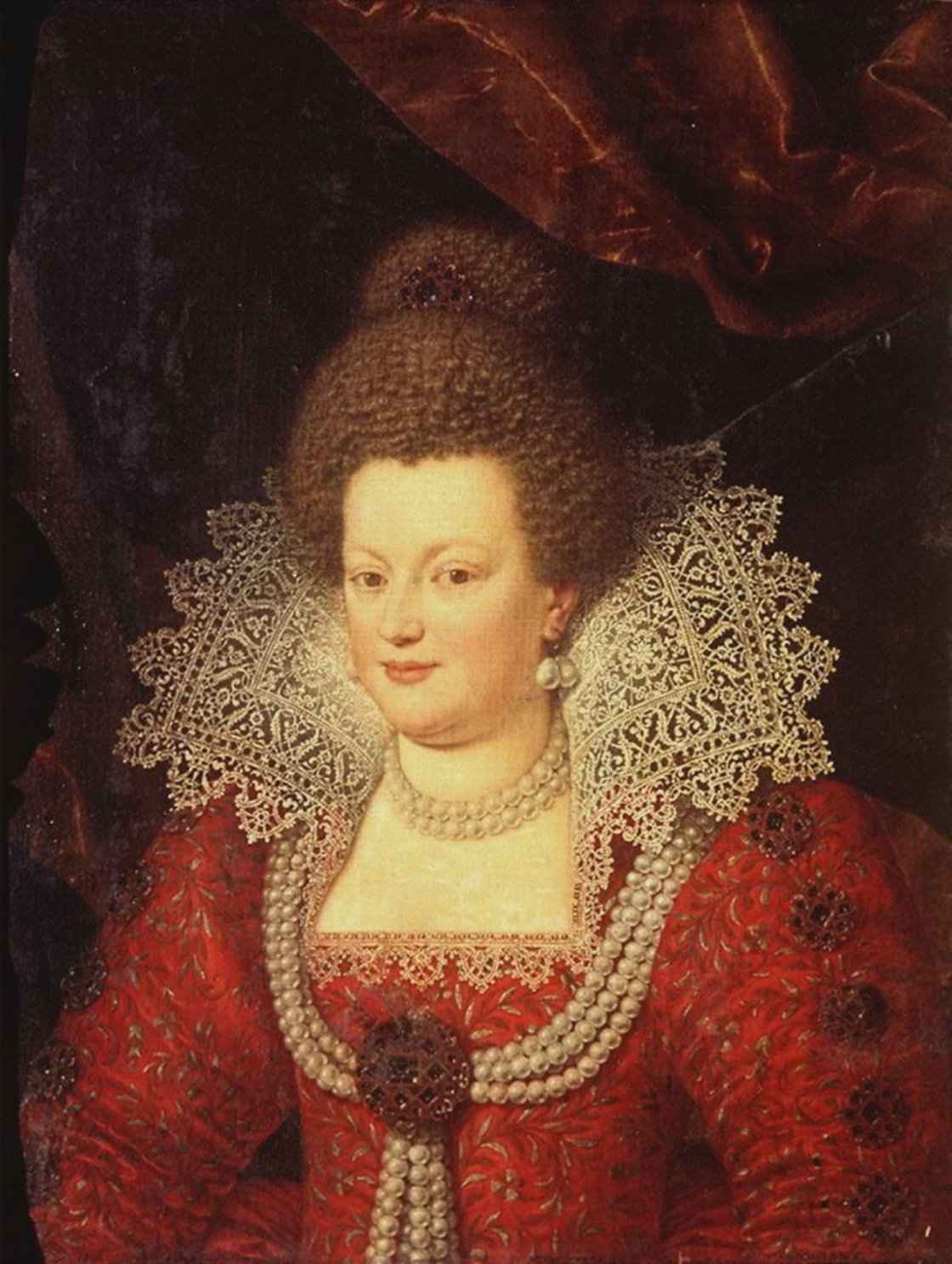
Marie
Throughout Henry's reign, he worked hard to maintain the new wave of peace and prosperity in his kingdom, and for a while, the people seemed to respond to him, with some even calling him “Good King Henry.” Henry not only refilled the royal funds, he created reservoirs for future use. He modernized military training and equipment, and he ordered for the reconstruction of several governmental and art centers.
However, as much as he had hoped to curb the Catholic and Huguenot tensions, the animosity towards him lingered. The Catholics saw him as a secret Huguenot and greedy double-agent who had no real intentions of living the Catholic lifestyle. Huguenots, on the other hand, labeled him a treacherous traitor for his failure to stay true to his faith, as his mother, Queen Jeanne, had done.
As a result, Henry became the target for multiple assassination attempts, and the the third one would succeed. On May 14, 1610, the royal coach came skidding to a halt, and seemingly out of nowhere, a Catholic assassin lunged forth and drove a knife into the king's chest, killing him.
King Louis XIII
“To know how to dissimulate is the knowledge of kings.” – Cardinal Richelieu, French clergyman and royal advisor
Louis XIII, the oldest son of King Henry IV and Marie de' Medici, was barely 9 years old at the time of his father's untimely death. In October of 1610, the child replaced the fallen monarch, and regency was granted to his mother, Marie. As a child, the pale and feeble Louis shivered and stuttered as he spoke. This led many to draw the conclusion that he was “taciturn,” or in today's terms, autistic.
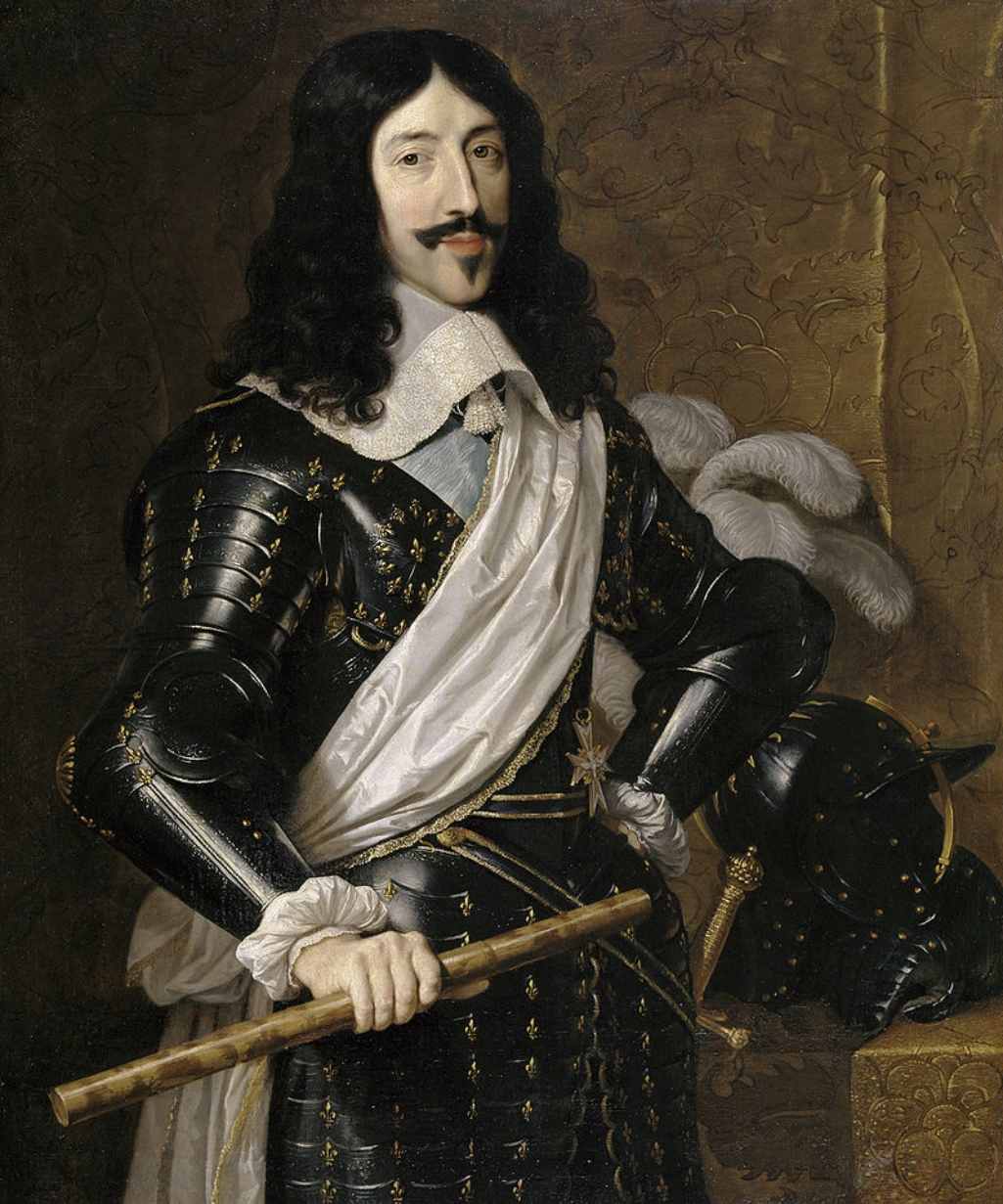
Louis XIII
In 1615, Marie arranged for the marriage of 14-year-old Louis and Anne of Austria, the teenager daughter of King Philip III of Spain. Their marriage was the final knot tied to honor the Treaty of Fontainbleau of 1611. The treaty guaranteed a 10-year alliance and mutual defense pact between France and Spain.
Louis and Anne would bear 2 children of their own: Louis XIV and Philippe I, the Duke of Orléans. The pair reportedly shared a cordial relationship with one another, but they lived in separation throughout most of their marriage. As a matter of fact, some speculate that Louis might have been homosexual or bisexual. Throughout his teenage years and well into adulthood, Louis was believed to have engaged in multiple romantic relationships with an array of court officials. Regardless of his much-publicized trysts with men, the king was nicknamed “Louis the Chaste” for never taking a female mistress.
By 1614, 13-year-old Louis had come of age. He fought for his right to lead France on his own accord, but Marie refused to let go of the reins and continued on as the “de facto ruler” for 3 more years. As the effective ruler, Queen Marie chose to retain most of the officials in her husband's court, barring Maximilien de Béthume, the Duke of Sully and a proud Huguenot. Even with the expulsion of de Béthume and the new restrictions on certain Huguenot practices, Marie chose to level tensions by maintaining her husband's edict to some degree.
Despite Marie’s attempts to keep the peace, the Catholic and Huguenot rebels were less than amused by the meddling queen's antics. Henri, the Prince of Condé, was next in line to the throne after Gaston, Henry and Marie's second son, and the temptation of royal instability seized him, kindling the renegade inside of him. Henri proceeded to assemble a small band of mutineers and launched a coup, hoping to do away with the monarchs, but he received almost no support from the public and was quickly defeated by Marie's forces.
The flummoxed queen attempted to squash tensions by assembling the Estates General, a legislative and consultative body designed to tackle urgent national matters. Only, no issues with Huguenots and rebels were ever truly resolved, as the ineffective team dwelled on topics about France's relationship with the papacy instead of brainstorming legitimate solutions.
The next year, Marie made matters even more complicated when Concino Concini, an Italian politician and one of her husband's most trusted ministers, joined her entourage. Concini might have been a Catholic, but many tensed up at the thought of a foreigner in the country's cockpit.Marie's friendship with Concini triggered another rebellion led by Henri in 1616. This time, he had the full support of Huguenot leaders. Louis, who looked on from the sidelines, took this as a sign of the Huguenots' dishonorable nature; the event instilled in him the belief that none of the Huguenots could be trusted.
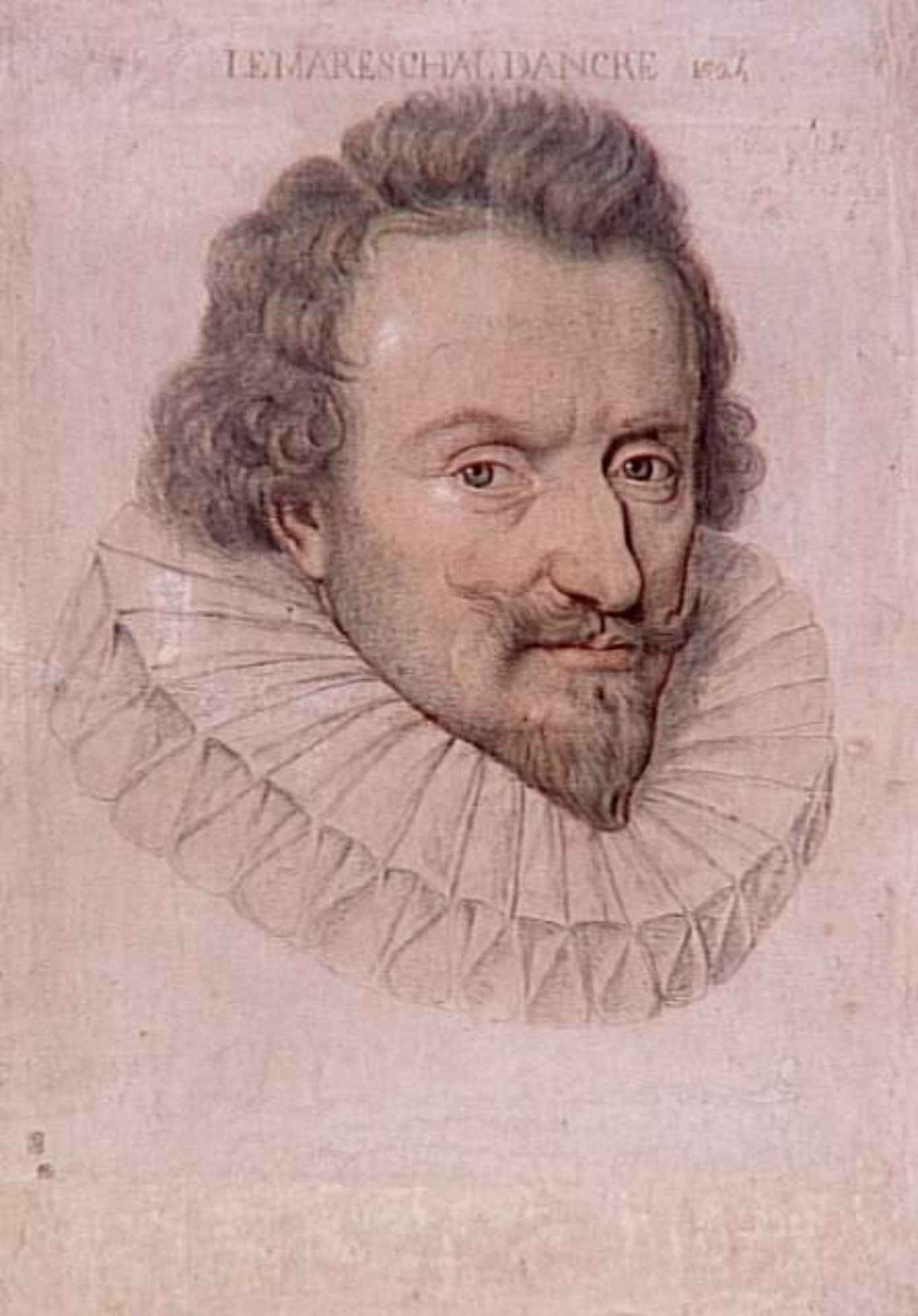
Concini
Marie and Henri eventually settled their differences with the Treaty of Loudun. The treaty's terms ensured that Henri would be given more power, and therefore deepened his involvement in the government. In exchange, Concini would be allowed to remain in court.
Even with Henri's new status in court, more grousing nobles turned up the flames under Queen Marie. Protests multiplied, calling for the dismissal of Concini, and Marie began to fear for Concini's life. Still, instead of backing down, the stubborn Marie had Henri cuffed and thrown behind bars, which only served to enlarge the already conspicuous targets on the backs of Marie and Concini.
In the meantime, 16-year-old Louis had struck up a close – and some say, romantic – relationship with the 38-year-old Charles d'Albert. Charles was the Grand Falconer of France, a high-ranking position within the royal household, responsible for tending to the king's birds, as well as organizing and administrating royal falcon hunts. The charming falconer began to criticize Marie's overbearing nature. He warned Louis that his mother had no intention of giving up her regency, and encouraged him to make his move before it was too late.
In late April of 1617, Louis led an aggressive uprising within the palace. Concini was slain by palace guards. His wife, Eleonora Galigai, was classified as a witch, and beheaded, her corpse torched 3 months later. Finally, Louis shunned his own mother from the kingdom and appointed Charles as the Duke of Luynes.
The palatial coup proved to accomplish nothing, as Charles proved to be every bit as spurned as Concini. He would later cancel the paulette tax. The judicial and other governmental departments were no longer required to cough up 1/60 of their annual earnings to the crown, which only provoked more discontent from the public.
The abnormally rapid passing of the royal torches left the people disoriented and aggravated, and it would not take long before they began to pick apart the new king's flaws as well. Just a year after Louis seized control of the throne, central Europe spiraled into a series of cutthroat military, political, and religious conflicts, now known as the “Thirty Years War.” Louis found himself trapped in the middle. As the king of France, the longstanding French rivalry against the Austrian royals produced an incentive to ally with the Protestants. Alternatively, as a Catholic, he felt liable to show his support for the Holy Roman Emperor. The public wrote him off as an indecisive leader, one that could not stick to his guns.
Besides the cancellation of the paulette, the Huguenots' patience was dwindling. Louis had inherited quite a dilemma. When Henry IV converted to Catholicism, he promised Rome that he would restore Béarn and Navarre, 2 of the most prominent Huguenot strongholds, to the Catholic faith, and the ambitious Louis decided that the crown would fulfill that promise. As soon as he had been granted full supremacy of France, he called for the reinstatement of Catholic rights, along with the restoration of all Catholic property in Béarn. He hoped to smoothen the process by offering generous sums to the landowners, but the Huguenots would not budge.
Louis was irritated, but undaunted. He steered his sights towards Navarre, where he issued the same proclamations, effective immediately. By the end of 1619, he had succeeded in regaining control of both Béarn and Navarre. When Louis started on his journey back to Paris, however, the rebels slunk out of the shadows once more. Deciding that enough was enough, under the king’s instruction, a swarm of royal soldiers descended into both regions. Huguenot leaders and rebels were rounded up, and the majority of them were forced into exile. The streets rang with the hollers and whoops of the king's Catholic supporters, who proceeded to loot and vandalize Huguenot cemeteries and places of worship.
The First Rebellion
“For the time will come when they will not tolerate sound doctrine, but according to their own desires, will multiply teachers for themselves because they have an itch to hear something new. They will turn away from hearing the truth and will turn aside to myths.” –2 Timothy 4: 3-4
The Huguenots had grown frantic, terrorized by the fear that the rights and equal footing they had worked so hard to achieve was slowly slipping from their grasps. It was bad enough that Béarn had reverted to French Catholic territory, but the government of the once Huguenot city underwent a complete reshuffling, and after that it became a purely Catholic body. The tides were turning, and it seemed there was no time to left to squander, for they could be flushed out by the incoming wave of absolute Catholic suppression at any given moment.
On December 25, 1620, all available Huguenots were invited to a meeting by Henri, the Duke of Rohan, and his younger brother, Benjamin, the Duke of Soubise. The noble-born brothers have always been a formidable force. Their parents, René II of Rohan, the Prince of Leon, and Catherine de Parthenay, the heiress to an affluent Protestant family, were something of a power couple of their own. As a unit, the Rohan nobles were one of the most esteemed and widely-connected families across the entire continent.
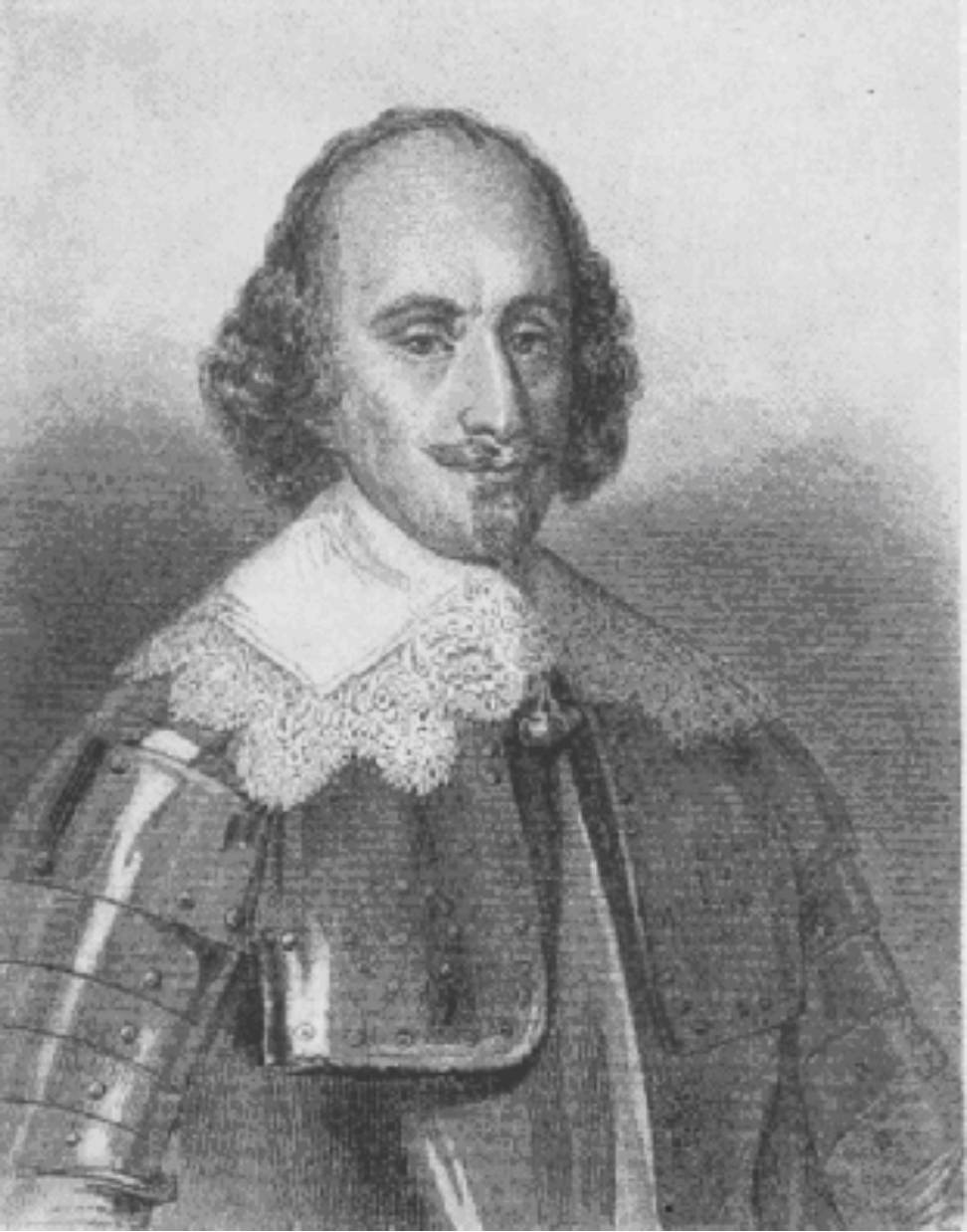
Henri

Benjamin
The brothers received a home-schooled education from their mother, Catherine, a brilliant mathematician and one of the most gifted scholars of her time. Many believe it was Catherine who whipped her sons into shape, preparing them for the greatness that lay in store for them. A high standard of education, Catherine believed, was only half of the equation, as resilience could only be achieved through the proper training of mind and body.
And so, when the Huguenot brothers reached their teenage years, they enlisted themselves in the military. Benjamin served an apprenticeship as a soldier under Maurice, the stadtholder of all Dutch Republic provinces and the future Prince of Orange. His older brother, Henri, seemed to have a natural penchant for the force. Henri excelled in almost every aspect of his military career, earning the respect and admiration of his various superiors. At age 16, Henri was said to have been blessed with a polished set of leadership skills, as well a flair for befriending characters from all backgrounds. He had even formed a close bond with King Henry IV, a notorious Catholic convert, and was said to have been one of the king's favorite associates. As Henri's military tours took him across Europe, he would also form an alliance with the English monarchs. The Huguenot was knighted in England, and he was later appointed godfather to the future King Charles I at the royal baptism.
Henri journeyed back to France in 1603, at the age of 24. Shortly after his arrival, King Henry IV invited him into the peerage by offering him the title of Duke. Henri, radiating with pride, gladly accepted. Previous plans that had been made of his marriage to Princess Catherine of Sweden fell through. That year, he married Marguerite de Béthume, the daughter of the future Duke of Sully. This was the very same Maximilien de Béthume who was removed from his post during Marie's Huguenot cleansing of the royal courts.
Henri proved to be an extraordinary addition to King Henry IV's military force, playing a significant role in leading the victorious campaign against the Duke of Bouillon in the early 17th century. Later, the brothers would also fight alongside Prince Maurice's troops to help subdue the Spanish armies. Henri's future looked brighter than ever, at least until the assassination of King Henry IV.When Queen Marie was granted control of France, she began a brutal campaign to stamp out the Huguenots. Under her reign, the influence of the so-called “Pious Party,” a name designated to the rabidly anti-Protestant politicians, experienced a dramatic surge.
Henri was torn. The deeply patriotic Huguenot had always patted himself on the back for his unbiased loyalty to the crown, but Marie's anti-Huguenot campaign had careened out of control. This was followed by an even more suffocating reign enforced by King Louis XIII, which was certainly testing not only his faith but his character. Henri began by reducing himself to a shadow in government, keeping only a passive role as a form of subtle protest. But as the Huguenot morale worsened, Henri could sit on his hands no longer. Whether or not he had ever intended it, he would become the spearhead and face of the Huguenot resistance.
The forced conversions of Béarn and Navarre had been the final straw. The meeting organized by the Rohan brothers, which came to be known as the “General Assembly at La Rochelle,” reached a consensus in no time: they vowed to snatch back what was rightfully theirs. To turn this desire into reality, they would assemble a group of the finest Huguenot soldiers, train them to a tee, and equip them with the most premium of weapons and equipment they could afford.
It was time to retire the monarchy, and erect a “state within a state.” In this new community, the Huguenots would be independent from French rule, free to establish their own taxes, and free to build a proper army of their own. The Huguenots recalled John Calvin's endorsement in flouting any royal authority that sullied the word of God. After all, the Dutch, now a grand republic, had already once succeeded in doing so when they resisted and defeated their Spanish invaders. Towards the end of the meeting, captaincies and responsibilities were dispensed to those present at the meeting.
Word of the incoming Huguenot resistance managed to slither its way to France, and before long, King Louis XIII was alerted about the rumors. The flustered king scrambled into action, hastily piecing together his troops. In May of 1621, the first of Louis' troops posted themselves on the borders of the Huguenot city of Saumur, and the surrounding royal army laid siege to the undefended commune nestled in western France, cutting off all essentials, supplies, and aid to the city. Even though the Huguenots at Saumur had shown no inclinations of challenging Louis, the paranoid king decided not to take any chances, and he aimed to contain the madness before it spread. As expected, the unprepared city was an easy score.
Next, Louis directed his troops to the Huguenot stronghold of Saint-Jean-d'Angély, a small city tucked away in the southwestern region of country. Henri's less experienced brother, Benjamin, was entrusted with heading the defense. Benjamin had been stationed there in the hopes of weakening the royal forces before they could force their way into the main stronghold at La Rochelle. The younger Rohan put up a fight and stuck it out for 26 days before their inevitable surrender on June 24, 1621.
2 months later, the king and his forces marched on to the Huguenot stronghold of Montauban, but it was here that Louis XIII's luck began to wane. At 25,000, the size of his army was commendable, but the men were wobbling on their last legs. The men had grown disillusioned, malnourished, dehydrated, and generally exhausted from the nonstop fighting, and morale had sunk to an all-time low. The Huguenots of Montauban caught on to this and resisted the disintegrating royal forces. It took another 2 months before the French king finally admitted defeat and grudgingly retracted his troops.
Back home, Louis devoted his time to rebuilding and improving his forces. In June of the next year, the king was informed that one of his royal agents, who had been left in the Huguenot city of Négrepelisse, had been killed. And so, the king resumed his campaign with a fresh vengeance. He was keener than ever to teach the Huguenots a lesson, kick-starting one of his most merciless sieges yet. The new batch of royal troops poured into the city, looting, raping, and slaughtering the inhabitants and anything that lay in their wake, regardless of age, gender, or creed. Once they were finished, the riotous troops set the ruined city ablaze. These atrocities were carried out with the full support of Louis, who allegedly stated, “I command you to give no quarter to man, because they have irritated me, and shall be served as they have treated others.” It was only after the city lay in smoking ruins that Louis realized that no such royal agent had existed, but what was done was done.
The guilt may have nibbled away inside of him, but outwardly, the king appeared remorseless. Just one month later, he proceeded to direct his troops to the vastly populated Huguenot city of Montpellier. Here, Louis and Henri tried their hand at a truce and began the negotiation of a peace treaty through a middleman, Marshal General Lesdiguières. On August 22, 1622, Louis and Henri signed the first draft.
In spite of Henri's encouragement, the hesitant Huguenots of Montpellier wanted no part of the deal and denied entry to the royal forces. For one, they could be in jeopardy of an unannounced attack by Henri, the Prince of Condé, who they believed had weaseled his way into the king's innermost circle. The Huguenot Henri tried to reason with them, but the residents of Montpellier insisted that they would only open their borders if King Louis agreed to a number of degrading conditions. Naturally, a disbelieving Louis refused and promptly ordered the immediate siege of the city, replacing Lesdiguières with Henri of Condé to head the mission.
Etienne d'Amérique, one of Henri's best agents, was elected to head the Huguenot defense for Montpellier. D'Amérique's extensive military background proved fruitful, as he managed to hinder the advancement of the royal troops for quite some time. Louis succeeded in overtaking Saint-Denis, the fortified base of Huguenot operations in Montpellier, but the Huguenots reclaimed their territory the very next day, exterminating 200 of the king's men in the process. On the same day, under the authority of Galonges, the head of the Montpellier garrison, 400 Huguenots emerged victorious over a royal army of 1,000.
The Huguenots' winning streak carried on. In early October, the Huguenots triumphantly countered 3 different attacks from the royal army. 300-400 of the 5,000 French soldiers were killed in the Huguenot retaliation, and thousands more were wounded. Supplies began to run low, and a great portion of the wounded royal soldiers petered out from infections and diseases. Louis finally hung his head and swallowed his defeat. Lesdiguières was once again tasked with creating the second draft of the treaty. On October 8, 1622, the Huguenot Henri arrived at Montpollier, bringing with him 4,000 men, outfitted with food, medicine, and other supplies. On the 19th of October, Henri and Louis shook hands and finalized the Treaty of Montpollier.
Louis agreed to reinstitute the Edict of Nantes and adhere to it once and for all. As for the Huguenots, they agreed to surrender their strongholds in Nîmes, Uzès, and Montpellier. The next day, King Louis returned to Montpellier, but this time, he came unarmed, and his forces slowly began to disassemble the Huguenot fortifications. The Citadel of Montpellier was built in its place and stocked with the Louis' most trusted underlings, which made it easier for the king to keep an eye on the town.
Take Two
“Secrecy is the first essential in affairs of state.” – Cardinal Richelieu
For a while, it seemed as if the Treaty of Montpellier introduced a new chapter of peace and solidarity in France, but when Armand Jean du Plessis de Richelieu was appointed the king's Chief of Minister in 1624, it only spelled trouble for the Huguenots.
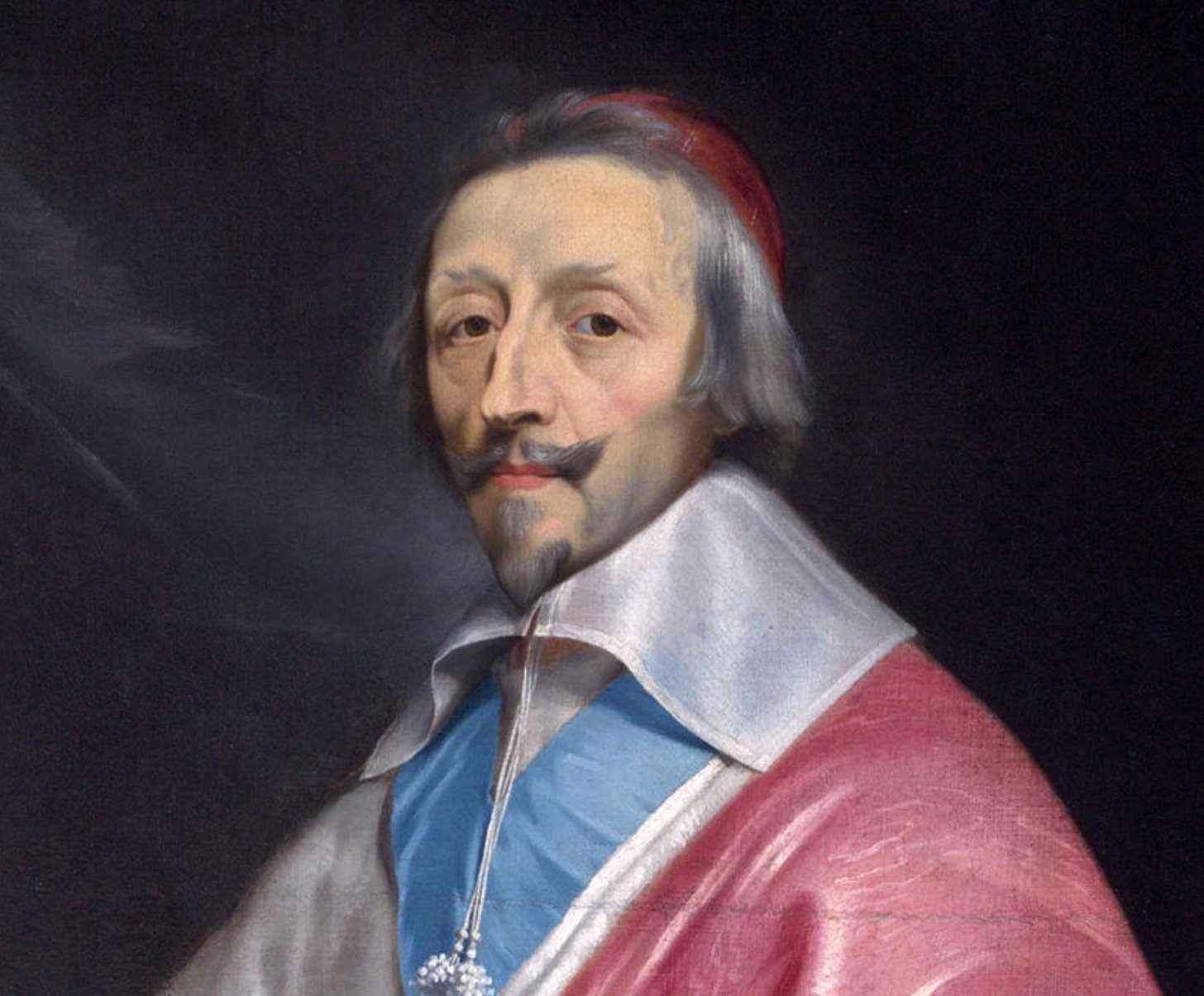
Cardinal Richelieu
Richelieu was born in Paris, the youngest son in a family of 7. The du Plessises were not noble men but fit snugly into the middle class. Richelieu's father was a soldier who was later appointed the Grand Provost of France, a powerful judge in the royal house who held jurisdiction over all its officers. His mother was the daughter of a notable law writer.
Tragedy struck when Richelieu was 5. His father had become a casualty during one of the battles of the religious civil war, news that sent his mother buckling to her knees. With the breadwinner deceased, debt quickly stacked up. It appeared that his father had not died in vain, as the crown swooped in and granted them royal aid, keeping them afloat. The monarch's assistance in their family's greatest crisis fostered Richelieu's growing respect and admiration for the crown.
Like Louis, Richelieu was a sickly and “delicate child,” but he was by far the most academically gifted of all the du Plessis children. At age 9, he was admitted into the College de Navarre in Paris, where he explored the field of philosophy, and later, at 17, he took an interest in theology. With his studies behind him, he followed in his father's footsteps, and like many young men of his day, joined the army.
Apart from the royal aid granted to them by King Henry III, the du Plessises were elevated to a bishopric household, giving them authority over the diocese of Luςon, a Roman Catholic commune, as well as the Luςon Cathedral. Richelieu's mother had chosen to devote most of the financial aid to themselves, which quickly raised the local clergymen's ire. In an effort to placate the clergymen, Richelieu's mother offered to make her son, Alphonse, the bishop of Luςon. When Alphonse declined, choosing to becoming a monk instead, Richelieu's hand shot up. Not only was he a staunch Catholic, he was prepared to take this as another academic challenge.
In 1606, King Henry IV nominated 21-year-old Richelieu for the bishopric of Luςon, but Richelieu still required papal approval since he was still years under the age limit. The pope eventually awarded his blessings, and by the next year, Richelieu was a formally ordained bishop. He returned to Luςon in 1608, where he soon earned a reputation as a no-nonsense reformer and a champion of the reforms generated by the Council of Trent.
The Council of Trent was the core of the Counter-Reformation, the Catholic Church's response to the Protestant Reformation. It was an assembly of bishops who met together regularly between 1545 and 1563. Here, they identified Protestant heresies, outlined their beliefs for a better reaffirmation of their faith, and designed consequences for wayward Catholic leaders. Several changes were introduced, which included punishments and penalties for the crimes of simony, indulgences, and the housing of more than one diocese. Background checks for incoming priests became more meticulous, and all training on biblical knowledge and discipline more refined. Moreover, the council declared the Nicene Creed the official Catholic prayer, reinforced the doctrines of the Old and New Testaments, and established 7 sacraments. Catholic authorities applauded Richelieu's resolve to promote the new reforms and his admirable demonstration of leadership skills.
The young Richelieu later dipped his toe into the pool of politics. In 1614, he was invited to join the board of the Estates General, and swiftly became known as a vehement defender of Catholicism and the Trent reforms. Richelieu was also the first to argue in favor of tax exemption for the Catholic Church, and fought for the increase of bishopric influence in court. Catholic authorities began to see Richelieu as their equal, and even chose him to deliver the final speech during the last assembly.
After the scrapping of the Estates General, Richelieu began to involve himself with the crown. Louis XIII's wife, Anne of Austria herself, had taken notice of Richelieu and made him the Grand Almoner, or the director of religious affairs, of the royal household. He welcomed the new endeavor and continued to make strides, later scaling the ranks as a direct understudy of Marie de' Medici's partner in crime, Concini. Richelieu reached another milestone in 1616 when he was appointed the Secretary of State, granting him authority and management over foreign affairs. During this time, camaraderie evolved between Richelieu and Marie.
Richelieu's power would soon come crashing down. Following Concini's death and Marie's banishment in 1617, Richelieu was released from his post as Secretary of State. The next year, Louis, who singled Richelieu out for his very public friendship with Marie, ousted him to Avignon. His ego was bruised, but Richelieu kept his head down and spent his exile churning out one work of literature after another. Perhaps he knew that it would only be a matter of time before power came back to him.
As he no doubt hoped, when Marie broke free from house arrest in 1619, a desperate Louis pleaded with Richelieu to return and talk some sense into the queen. He served as a medium for Louis and Marie, a task he handled with ease and flying colors. In a team effort with Louis' alleged lover, Charles, the Duke of Luynes, the pair managed to convince the squabbling mother and son to sign the Treaty of Angoulême. Through the terms of the treaty, the pair vowed to set aside their differences. What was more, Marie would be pardoned and granted her full freedom if she agreed to respect her son's authority.
The Duke of Luynes died suddenly from a fever 2 years later, and it was then that Richelieu began to inch closer to Louis. He gradually won the king's trust, and in 1622, he was nominated as a candidate for cardinal, which was later approved by the pope that same year. When the Huguenot Rebellions began, Louis repeatedly turned to Richelieu for counsel, and regarded his advice with the highest esteem. It seemed that only Richelieu was on the king's wavelength; the cardinal once wrote, “So long as the Protestants of France are a state within a state, the King cannot be master of his realm or achieve great things abroad.”
In April of 1624, Richelieu's presence was requested at the king's royal council of ministers once more. As Richelieu settled into the familiar seat of power, the observant and shrewd cardinal sniffed out a rat. He published articles and pamphlets outing the Chief Minister and Superintendent of Finances, Charles de La Vieuville. When these rumors of Vieuville's corruption were validated, the discredited official escaped the gallows and fled to the Netherlands for refuge. Richelieu dusted off the vacant seat of Chief Minister and remained the nominal president for the council for years, until he was officially granted the title in 1629.
Often hailed as one of the greatest French politicians of all time, Richelieu was an ardent monarchist who aimed to consolidate his beloved nation of France in a unified and centralized government. In 1624, there remained 8 Huguenot circles, each piloted by their own commander-in-chief. This was essentially a republic inside a monarchy, otherwise known as the crown's nightmare-come-true. The Huguenots even had the gall to create their own general and provincial assemblies, which Richelieu lambasted as a “political monstrosity.”
As a loyal Catholic, Richelieu had never made it a point to suppress his disdain for the Huguenots, but he knew that in order to achieve the harmonious, centralized society he so thirsted for, he would have to treat the Protestants with toleration and civil decency. Though the sight of the heretic Huguenots worshiping in public made his skin crawl, he respected the edict and kept his lips sealed. However, when the Huguenots decided to wreak havoc on the crown, Richelieu decided he would tolerate them no more.
Not long after the construction of the Citadel of Montpellier, Louis began to backpedal from the terms of the treaty. Louis had agreed to dismantle the royal fortifications in certain Huguenot strongholds, but instead, under the king's instruction, a marquis was tasked with strengthening the crown-owned Fort Louis in La Rochelle. To make matters worse, Louis was in the process of assembling a naval fleet in the nearby Blavet River, by the northwestern region of Brittany. Benjamin summoned the equally perplexed Huguenot leaders of La Rochelle. The suspicious circumstances provoked a quick conclusion. The king's push for peace was anything but sincere – once the Huguenots lowered their guards, the royal fleets would block off the ports to the city, making it easy to invade.
In early 1625, a manifesto penned by Benjamin began to circulate, warning the Huguenots about the pending attack and calling for a second insurrection. Benjamin sprang into action. First, he led his troops to the Isle of Ré, near La Rochelle, and took control of the island. There, he managed to amass a humble fleet of 12 small, but sturdy boats, and a crew of 100 sailors and armed soldiers. Later that January, Benjamin sailed towards Blavet, where his fleet fenced in the 6 stupefied vessels of the French Navy. The handsome, glinting ships may have been decked out with fresh paint and dozens of bronze cannons, but their stockpile of manpower and ammunition were nowhere near enough to ward off their attackers. The navy raised a white flag and surrendered several of their ships. The Huguenots' prized booty of the day was the La Vierge, a 500-ton beast of a vessel armed with 80 cannons.
Back at the harbor, the rattled Duke of Vendôme rolled out the boom, a barrier in the form of a strong, floating chain, and reeled it from one side of the harbor to the other. The Huguenot fleet refused to back down, and after a relentless 2-week effort, the chain finally snapped. At this point, Benjamin appeared a promising victor, commanding a splendid fleet of 70 ships.
For 3 weeks, the Huguenots fought to take control of the fort at Brittany, but they ultimately failed to secure the base. Defeated but undeterred, Benjamin retreated to the island to recuperate and went back to work. This time, he took 15 ships with him to the Isle of d'Oléron, and succeeded in occupying the new island. Benjamin's brave ventures did not go unnoticed, and soon, many began to look up to him as the new unofficial leader of the Huguenots. He, too, had dubbed himself the “Admiral of the Protestant Church.” With the French Navy virtually extinguished, the Huguenot victory seemed imminent.
Not surprisingly, the French king flew into a rage when he heard of his navy's embarrassing failure to restrain the Huguenots. He promptly sought out the guidance of Charles, the Duke of Guise, and together, the pair formed a plan to retrieve the islands. They appealed to their allies for aid and were able to secure 20 Dutch warships. Richelieu even managed to organize a tit-for-tat with the Parliament representatives from England. Pursuant to the terms of the agreement, England would loan France 8 English vessels, and in return, France vowed to support the English forces in their campaign against Spain. The latter exchange would trigger a controversy of its own, as this meant that the Anglican king would be contributing to the destruction of a fellow Protestant force, but after much goading from Parliament, the reluctant King Charles I of England agreed.
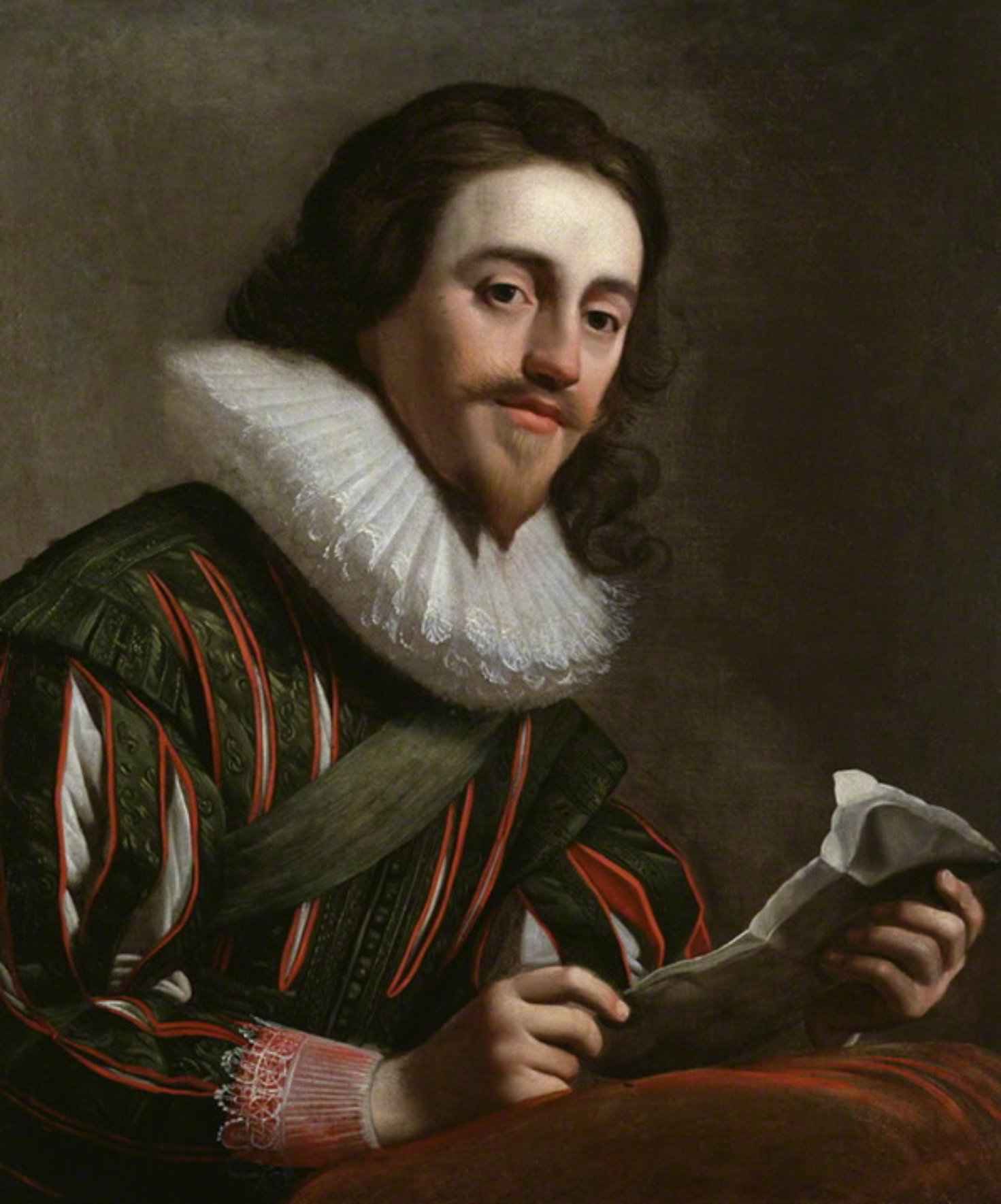
Charles I of England
Thanks to all these moves, the French Navy resurfaced, stronger than ever, and set sail for the islands. The Huguenot fleets were ready to receive them, but they had clearly underestimated the size of the retaliating forces. Nevertheless, the Catholic and Huguenot fleets faced off. In July, a hail of cannons and artillery fire from Benjamin's fleet rained upon a Dutch ship, blowing up the vessel and all 300 soldiers inside of it. The month after, the Huguenots of La Rochelle linked forces with Benjamin in a collaborative effort to sink the French Navy. In September, all efforts of resistance were rendered futile when the French royalists conquered what was left of the Huguenot vessels in Les Sables d'Olonne. 3,000 royal soldiers paraded into the islands, and the crown assumed control once again.
When things eventually simmered down, both parties began a lengthy session of peace negotiations. In February of 1626, Louis and the Huguenots shook hands once more, finalizing the Treaty of Paris. Religious freedom for all was both reaffirmed and restored, guaranteed only if those at La Rochelle agreed to disband their fleet and retire one of their forts in Tasdon. As for Benjamin, the disheartened Huguenot disappeared to England.
The Final Stand
“I die a Christian according to the profession of the Church of England, as I found it left me by my father...I have good cause and I have a gracious God. I will say no more.” – King Charles I of England
The nation of England was deeply offended by their king's decision to provide support for the Catholic French. A brooding King Charles I was tormented by his own decision, his gut twisting with regret.
His countrymen's aversion towards his new bride, Henrietta Maria of France, only sprinkled more salt into the wound. Henrietta Maria was the youngest daughter of King Henry IV and Queen Marie, a plain-faced princess with a passion for the arts. In mid-June of 1625, shortly before her 16th birthday, Henrietta was wedded off to 25-year-old Charles. In that same ceremony, Charles was officially crowned the new king of England.
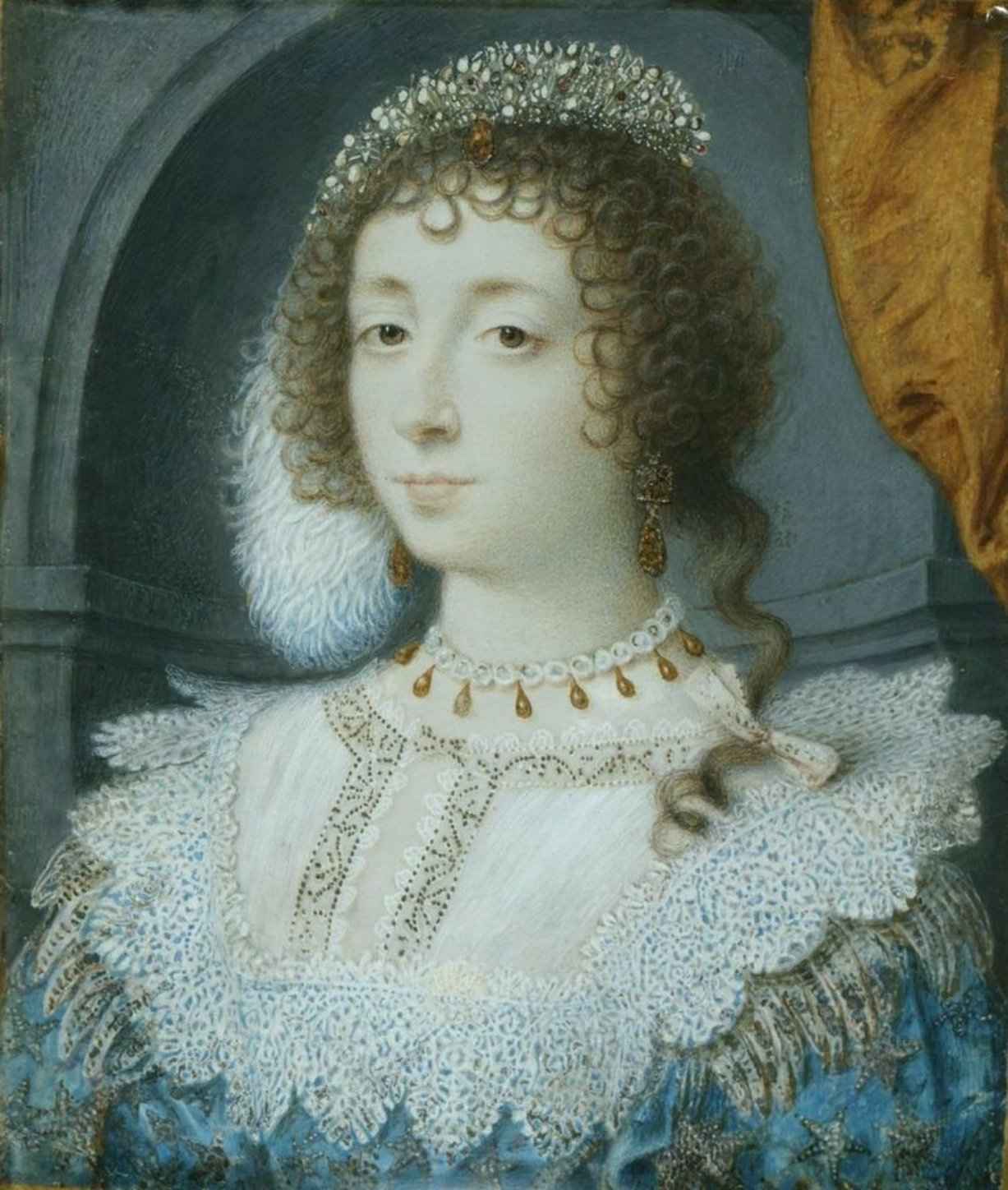
Henrietta Maria of France
Not unlike most arranged marriages, the couple got off to a rocky start. Henrietta did not speak a lick of English, and she would never fully grasp the language, let alone attempt to assimilate or educate herself on traditional English customs. She was “unapologetically” Catholic during a time when admitting to the faith in England could mean a death sentence. The young princess also had an insatiable appetite for luxury, demonstrated by the chests of jewels, diamonds, embroidered gowns in satin and velvet, and other valuables she had brought from home.
Apart from her heretical faith and hedonistic tendencies, those who despised Henrietta colored her as an “intrinsically apolitical, undereducated, and frivolous” queen. Many began to speculate that Henrietta was either a plant or a French spy, one conspiring to hand the key to England's kingdom over to France. Even as Charles and Henrietta eventually began to click and grew closer over time, the public still questioned the new king's support of the Protestant Church of England and did not appreciate his blossoming alliance with his Catholic wife.
Bearing this in mind, Charles was determined to refresh his public image. In 1626, shortly after the signing of the Treaty of Paris, rumors of a secret alliance between France and Spain began to make its rounds. This angered the already troubled Charles, for he now believed that the French, who had promised their support in England's ongoing war against Spain, had gone back on their word. When Charles' officials informed him that France was rebuilding their naval forces, the king was convinced France and Spain were plotting against him.
England's thorny relationship with Spain had taken a turn for the worse 3 years prior. Before Henrietta, Charles had been obsessed with Princess Maria Anna, the sister of the Spanish King Philip IV. His infatuation with the breathtaking princess was so strong that he felt compelled to travel to Spain. There, he approached Philip to request his sister's hand in marriage. In response, Philip commanded Charles to convert to Catholicism and remain in Spain for a year as a symbol of the future English-Spanish alliance, but Charles would not have it. He turned him down, and soon after, he declared war on Spain. Charles had hoped that he would have better luck with an alliance with the French, but it seemed as if history was only repeating itself.
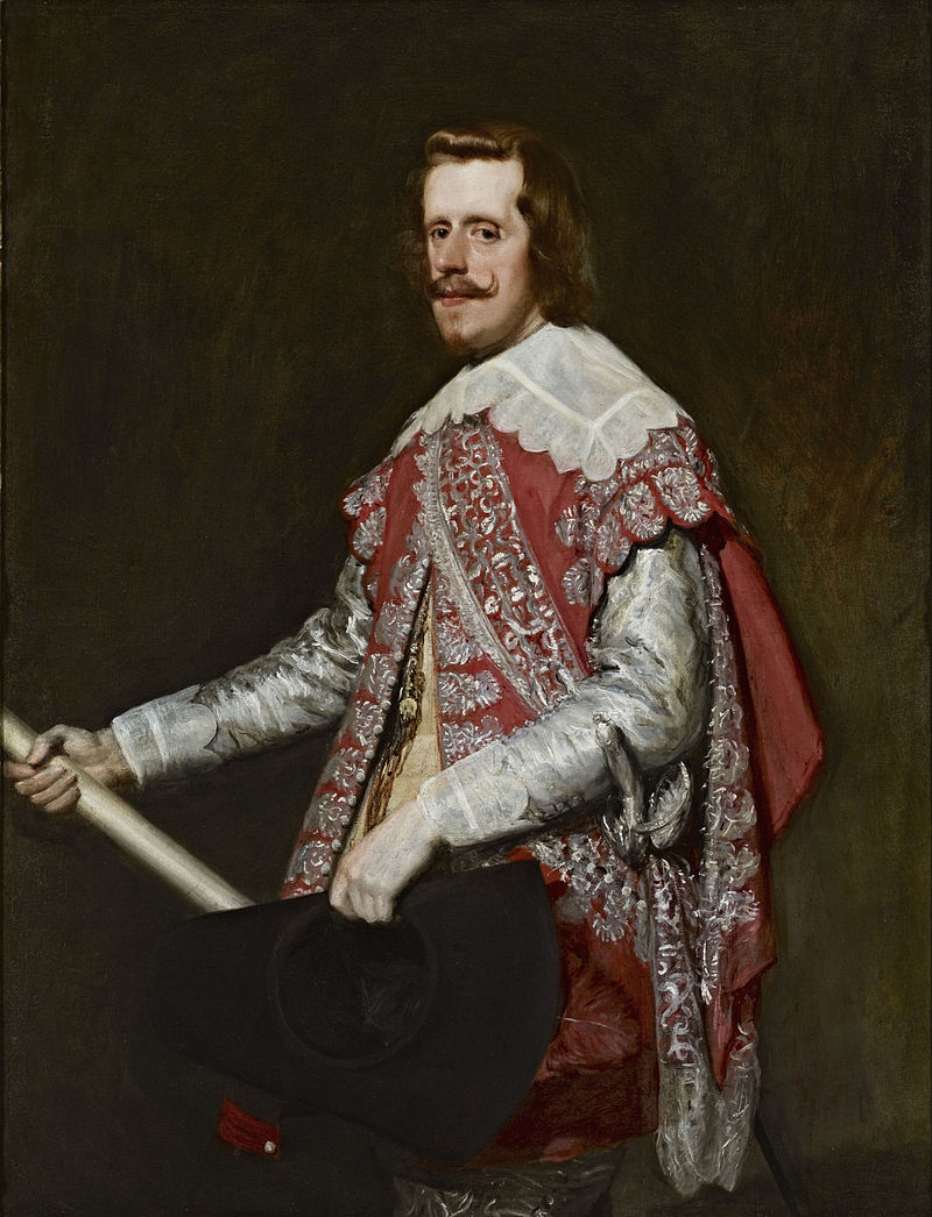
Philip IV
In June of 1626, Walter Montagu, an English secret agent, was sent to La Rochelle, where he called for a meeting with the Rohan brothers and other Huguenot leaders. The attendants drew up plans for a third rebellion, the greatest one of them all. Montagu gave the Huguenots his word – this time around, they would have the full backing of the English troops.
A year later, the English royal George Villiers, the 1st Duke of Buckingham, parked his fleet of 100 ships and 7,000 men on the shore of the Isle de Ré. Villiers' high spirits were dulled when he realized that in the time that had passed, many of the Huguenots now had cold feet, and those at the island were no different.
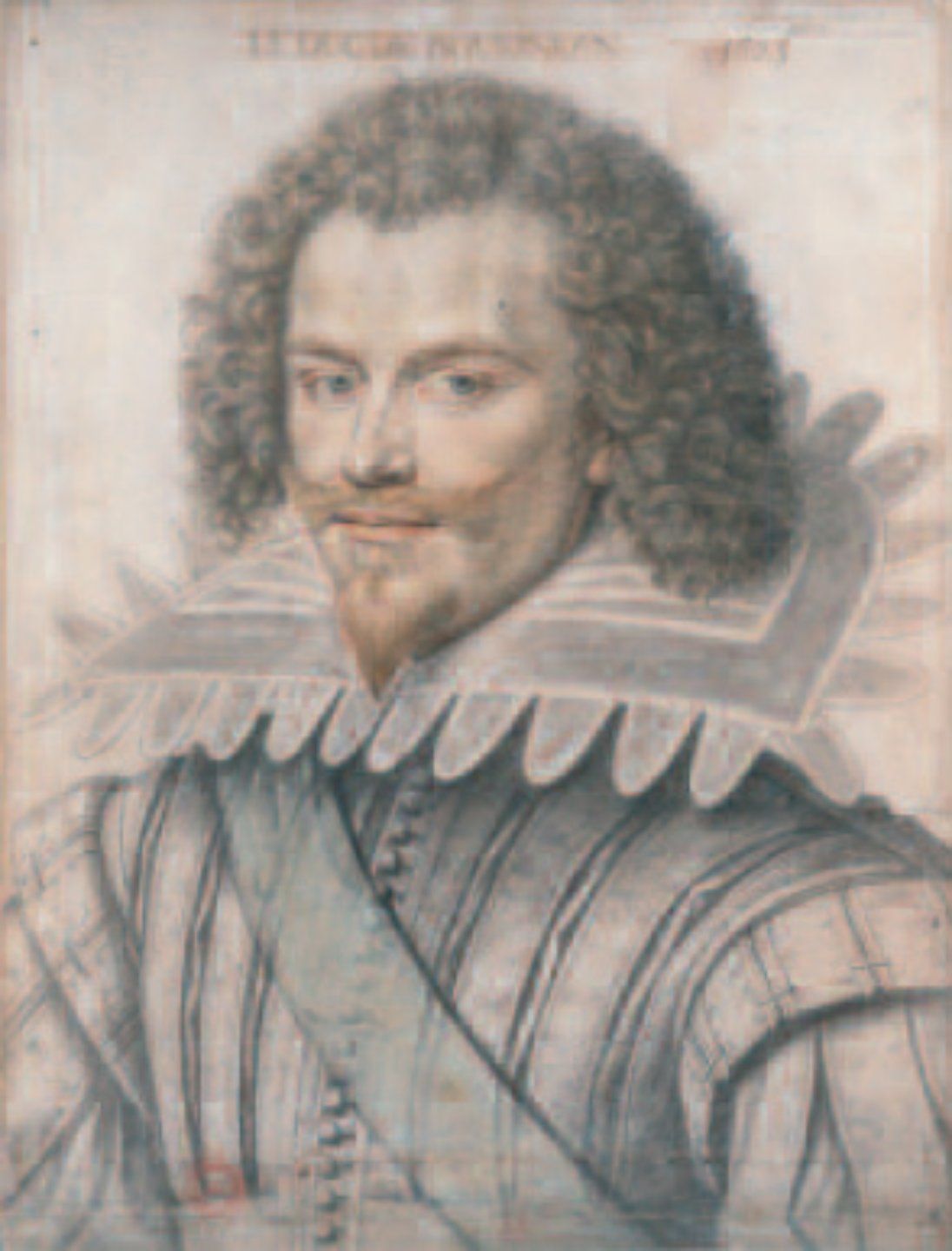
Villiers
Be that as it may, Villiers was here on a mission, and he intended to see it through. He gathered his forces and forged on to seize the monarch-owned fortress of Saint-Martin, a move that kicked off the Anglo-Dutch War of 1627. The 1,200 foot soldiers and 200 horsemen stationed in Saint-Martin sounded the alarm bells and hastened into position, resisting the barrage of English troops. The back-and-forth dragged on for weeks, eating away at the supplies and ammunition of the English. Backups consisting of Scottish and Irish troops were delayed, and many of the vessels were gobbled up by unanticipated storms.
Conversely, the French troops, given a home court advantage, found it much easier to restock on supplies. Richelieu knew that the capture of Saint-Martin could very well mean the end of the French monarchy, so he exerted himself and managed to scrape together 20,000 more soldiers for the defense. Next, he offered an attractive reward to anyone in the kingdom who could first succeed in transporting 50 barrels of biscuits, corn, and flour to the French troops.
On the 5th of November, Villiers and his troops staggered back to Saint-Martin and attempted a final shot at redemption, but the withering army could only scratch up the walls of the fortress before they were driven out by the French troops. They bolted to the northern corner of the island, staving off the French troops along the way. By the end of the ordeal, Villiers had lost almost 5,000 of his 7,000 men. 3 days later, the remaining English troops filed into their battered vessels and sailed back home to England.
While Villiers and his men attempted to seize Saint-Martin, the crown's emergency plans had been set in motion. Back in August of 1627, a royal force consisting of 7,000 soldiers, 600 stallions, and 24 grand cannons were directed to the Huguenot center of La Rochelle. There, the preemptive troops began to secure and amp up the defense of the Fort Louis and Bongraine fortifications.
Now that the Isle of Ré had been recovered, Richelieu pinned his focus on La Rochelle. Richelieu, the second-in-command to Louis, was given complete authority over the French troops. His plan to barricade the enormous city's ports seemed almost absurd, but Richelieu ignored the naysayers and unfurled the blueprints. The new barricade was inspired by the causeway (a raised track above the water) Alexander the Great had built during the Siege of Tyre. Construction began in October, and by the next month, the French troops had erected a whopping “siege line” stretching 7 miles long, complete with 11 improved and 18 new fortifications.
The causeway was completed in January of 1628, and at last, Richelieu unveiled his floating barrier of 56 tethered and fully-armed royal vessels around the border of La Rochelle. In March of that year, the Huguenot leaders in the city gathered and elected Jean Guiton as mayor. Guiton wasted no time and quickly designed a defense strategy.
2 months later, additional English reinforcements arrived, headed by Lord Denbigh, but a week later, when Denbigh learned that a Spanish naval force was on its way to shore up the defense for the French troops, the English packed up and left abruptly. In late September, a larger English fleet made an attempt to deliver food, supplies, and more ammunition for the Huguenots, but they were deflected by French troops at the border. They were left with no choice but to make a dramatic U-turn and sail back to where they came from, without ever once setting foot on shore.
The Huguenots at La Rochelle resisted for several months, but aid from the English slowly began to fizzle out. Gradually, the French, bolstered by their Dutch and Spanish comrades, trounced the Huguenot armies. By the end of the 14th month, the population in La Rochelle had plummeted from 27,000 to 5,000. Henri of Rohan struggled to push the rebellion back on its tracks for some time, but the Huguenots were defeated in the sieges of Privas and Alès. Submission was inescapable, and in June of 1629, the Huguenots finally surrendered.
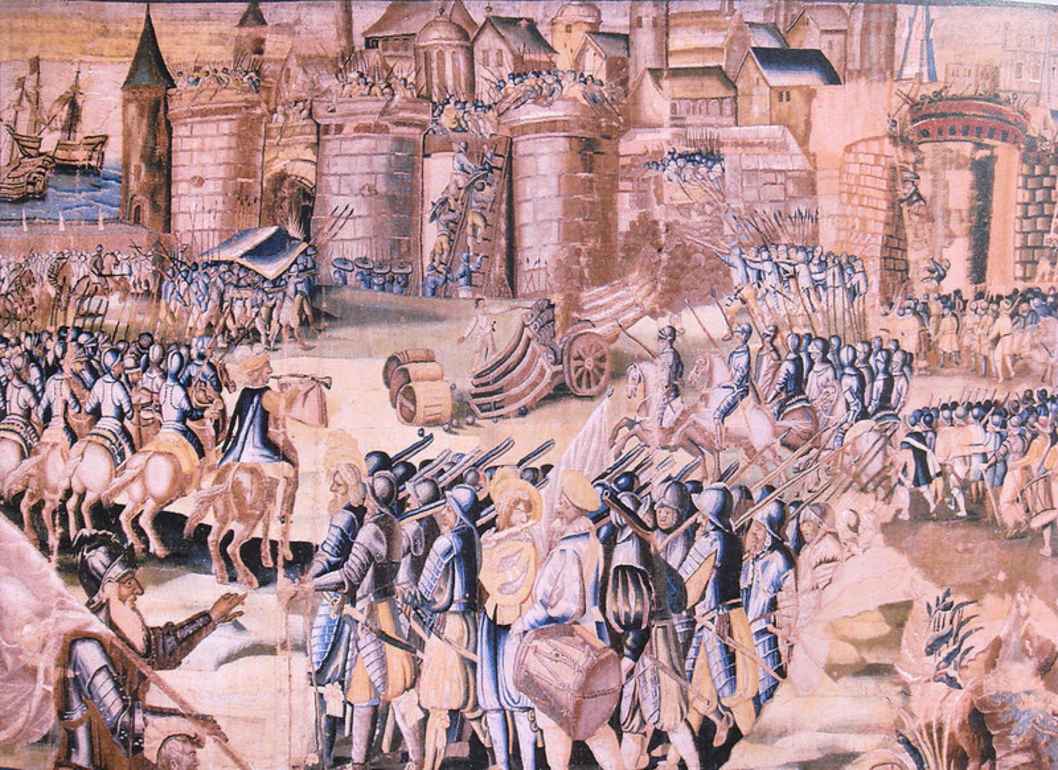
A depiction of the Siege of La Rochelle
3 months later, on the 27th of September, King Louis XIII and the Huguenot leaders reached a truce in the Treaty of Alès, otherwise known as the “Edict of Alès,” or the “Edict of Grace.” The document guaranteed freedom of worship to all the Huguenots of France, under the condition that they relinquish all political and territorial rights. No longer were they allowed to own French land or property, and they were now banned from participating in public office. In addition, all Huguenot fortresses were to be destroyed, and dominion over previously Huguenot cities was returned to the crown.
As Louis and Richelieu had always hoped, France was once again an absolute monarchy with sovereignty across the country. Moreover, these new changes drained the power of the Huguenot movement, leaving them utterly defenseless against the next wave of oppression. In 1685, King Louis XIV, the son of Louis XIII and Anne, nullified the Edict of Nantes, and with that, the legendary Sun King unleashed another era of Huguenot persecution. Consequently, 200,000 Huguenots would skedaddle to Protestant-friendly countries such as Prussia, Britain, and the Netherlands.
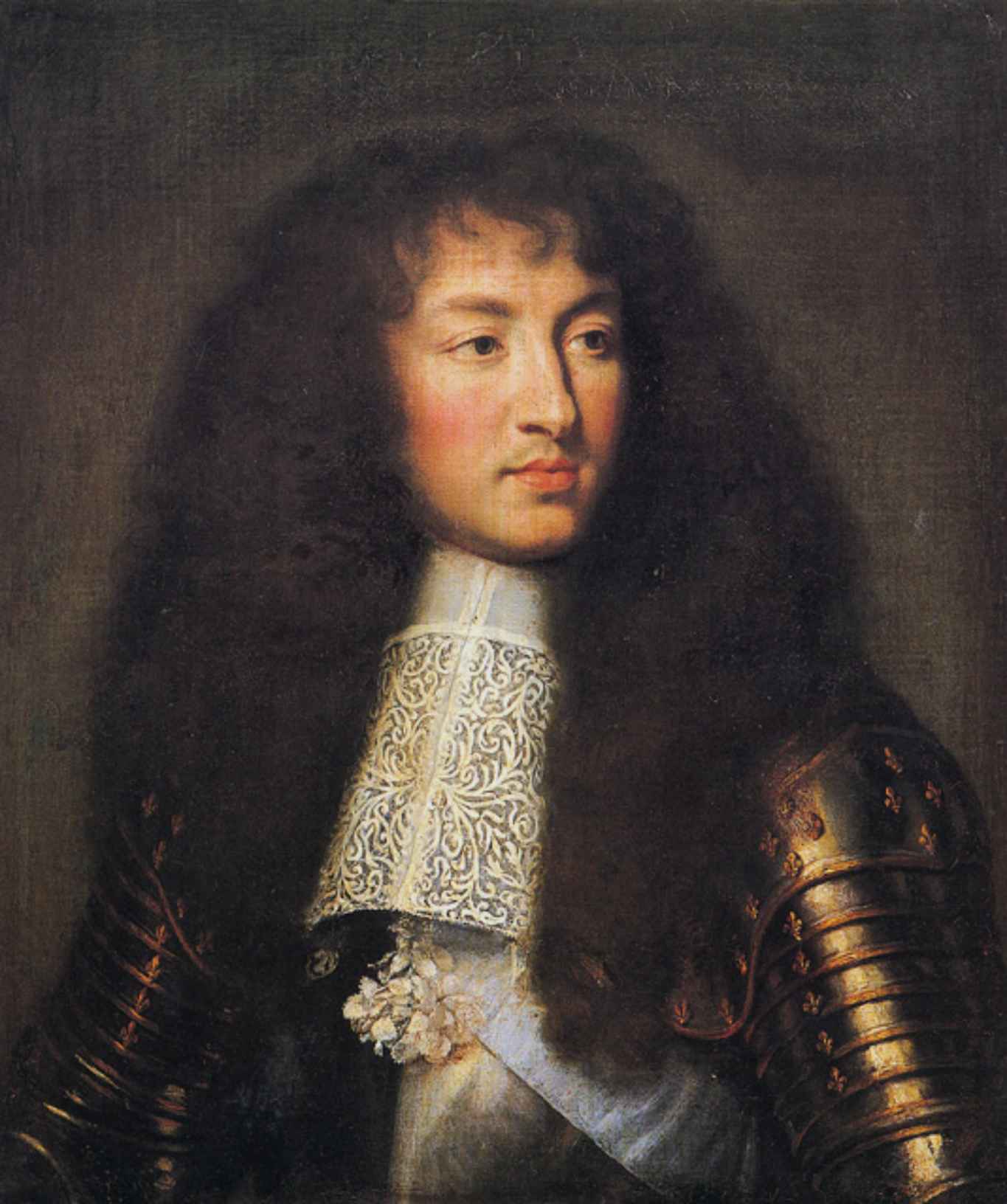
Louis XIV
Modern Developments at Carcassonne
“Carcassonne, a memory full of glory,
Radiant name in a sky of clarity,
Let's learn to read your great story,
In front of the towers of the ancient city.” – J.F. Jeanjean, “Carcassounéso”
In 1659, the Treaty of the Pyrenees, which was finalized at the Pheasant Islandon by the Bidasoa River, settled what had become a centuries-long territorial dispute between the French and Spanish sovereigns. As stipulated by the historic treaty, Roussillon, Perpignan, Carcassonne, and the 33 villages of the Cerdagne were granted to King Louis XIV of France. To balance out the Spanish territorial losses, King Philip IV of Spain was awarded the County of Barcelona and the historic villa of Llívia. Additionally, the French king vowed to renounce his support for Portugal, and he further agreed to a strategic union with Princess Maria Theresa of Spain, the daughter of his nemesis. In exchange for a hefty dowry, Maria Theresa was expected to withdraw herself from the queue to the Spanish crown. This dowry, however, was never settled, a major factor that led to the War of Devolution 9 years later.
Following the implementation of the treaty, the official military command center of the French government was transferred from Carcassonne to Perpignan. All frontier fortresses, including the hilltop citadel and the Five Sons of Carcassonne, were deserted and left to collect dust. As time progressed, local builders began to pilfer stones and other materials of varying sizes from the Cité rubble, recycling them as construction materials for new buildings. With the military chapter of its history now closed, the Carcassonnians were allowed to direct their focus to the local industries.
In October 1666, the newly-appointed French Minister of Finances, Jean-Baptiste Colbert, commissioned the construction of the Canal du Mudi. This 223 mile complex of man-made waterways, interspersed with 328 aqueducts, bridges, locks, tunnels, and more, was designed by Pierre-Paul Riquet. The canal, which flowed through the heart of Carcassonne, connected the Mediterranean to the Atlantic, thereby serving as the perfect platform for the thriving trades to grow.
By the 1800s, the hilltop fortress in the Cité had become nothing more than a glorified military base, inhabited by only a handful of royal soldiers at a time to guard the small arsenal Napoleon had installed there. On the other side of the River Aude, the Ville Basse had evolved into a bustling residential and industrial center that specialized in wool, wine, liqueur, and wheat.
The decaying fortress atop the hill had fallen into such disuse that the French government began to make preparations for its disassembly in 1849, only to be swamped with protests from locals who wished to preserve their “national heritage.” By 1853, respected historian Jean-Pierre Cros-Meyrevieille, the president of the newly formed Administration of the Arts, had garnered more than enough support and funds from wealthy patrons to restore the fortress. Local architect Viollet le Duc, who was assigned to oversee the project, defended the restorations, asserting, “I doubt that there exists anywhere in Europe as complete and formidable a system of defense of the 6th, 12th, and 13th centuries, as interesting a subject or study, and more picturesque situation.” One of Viollet's students, Paul Boeswillwald, inherited the responsibility of supervising the restorations upon the death of his mentor.
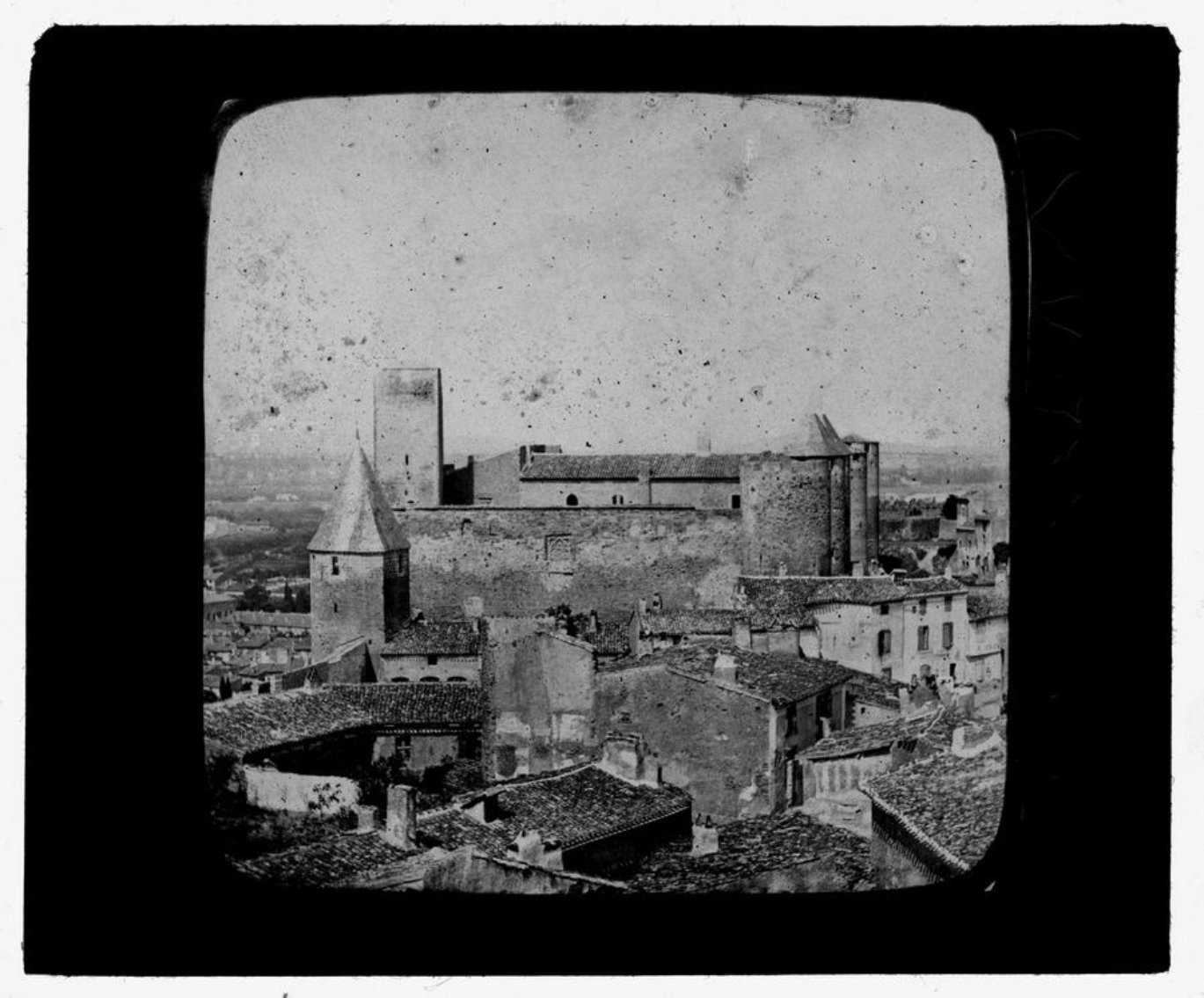
A late 19th century picture of Carcassonne
Another architect by the name of Nodet would later pick up where Boeswillwald had left off. In the early 1960s, several of the towers were rebuilt into U-shaped structures, overlaid with soft, pink brick, and crowned with “sloping, terracotta tiled roofs” so as to reflect a more traditional, Romanesque style.
In 1996, the Canal du Midi was formally classified as a UNESCO World Heritage site, and the same distinction was awarded to the Medieval Cité a year later. Today, nearly 50,000 residents (including the 50 or so who reside in the mdeival city) call Carcassonne home, making it the second-most populated city in the Aude, after Narbonne.
Online Resources
Other books about Catholic history by Charles River Editors
Other books about French history by Charles River Editors
Other books about the Huguenots on Amazon
Other books about the Cathars on Amazon
Bibliography
Editors, S. T. (2016, June 2). The Story of Lady Carcas. Retrieved January 25, 2018, from https://thestorytellershat.com/2016/06/02/the-story-of-lady-carcas/
Editors, C. L. (2015). Carcassonne – A tale of two Languedoc towns. Retrieved January 25, 2018, from http://www.creme-de-languedoc.com/Languedoc/city-guides/carcassonne.php
Editors, F. F. (2015, October 17). 10 Facts About Carcassonne. Retrieved January 25, 2018, from https://factfile.org/10-facts-about-carcassonne
Editors, A. O. (2011). La Cité Médiévale de Carcassonne. Retrieved January 25, 2018, from https://www.atlasobscura.com/places/la-cite-mediavale-de-carcassonne
Mach, A. (2014). 10 Amazing Facts About the French Medieval City of Carcassonne. Retrieved January 25, 2018, from http://fiveminutehistory.com/10-amazing-facts-french-medieval-city-carcassonne/
Editors, T. P. (2016, January 22). On This Spot: France's Flying Pig of Carcassonne. Retrieved January 25, 2018, from http://www.nola.com/travel/index.ssf/2016/01/on_this_spot_the_flying_pig_of.html
Editors, T. C. (2012). The Legend of Dame Carcas. Retrieved January 25, 2018, from http://www.tourism-carcassonne.co.uk/discover/history-carcassonne/legend-dame-carcas
Editors, T. C. (2014). History of Carcassonne. Retrieved January 25, 2018, from http://www.tourism-carcassonne.co.uk/discover/history-carcassonne
Munson, S. (2015). Visiting Carcassonne: France’s famous Medieval Walled City. Retrieved January 25, 2018, from https://www.francetravelguide.com/visiting-carcassonne-frances-famous-medieval-walled-city.html
Editors, U. (2016). Historic Fortified City of Carcassonne. Retrieved January 25, 2018, from http://whc.unesco.org/en/list/345
Editors, W. W. (2012, June 18). Preview: Carcassonne. Retrieved January 25, 2018, from http://www.nevworldwonders.com/2012/06/preview-carcassonne.html
Palau, P., Benoist, P., Cadet, P., & Roche, J. (2017). CARCASSONNE WORLD HERITAGE SITE. Retrieved January 25, 2018, from http://de.media.france.fr/sites/default/files/document/press_kit/Carcassonne_Press%20pack_EN_2017.pdf
Editors, D. B. (2012, February 9). Petit Bonus : Dame Carcas......La légende ? Retrieved January 25, 2018, from http://www.divagations-et-balades.com/article-petit-bonus-la-dame-carcas-la-legende-98945273.html
Editors, M. (2007). La Legende de Dame Carcas. Retrieved January 25, 2018, from http://mescladis.free.fr/dame-carcas.htm
Editors, P. O. (2011). The Aude - Carcassonne . Retrieved January 25, 2018, from http://www.panoccitania.com/aude2.html
Editors, D. C. (2017). Discovering the famous Dame Carcas legend. Retrieved January 25, 2018, from http://www.tourisme-carcassonne.com/news/english-news/copy_of_outdoor-pleasures
Luzi, G. (2017, February 9). 6 Spectacular Things to See & Do in La Cité, Carcassonne. Retrieved January 25, 2018, from https://theculturetrip.com/europe/france/articles/6-spectacular-things-to-see-do-in-la-cite-carcassonne/
Riding, A. (1997, August 24). Carcassonne, City of Stone. Retrieved January 25, 2018, from http://www.nytimes.com/1997/08/24/travel/carcassonne-city-of-stone.html
Hurtado-Ròs, S., & Zuchetto, G. (2010). La légende de Dame Carcas à Carcassonne. Retrieved January 25, 2018, from http://www.patrimoinevivantdelafrance.fr/index.php?mact=News,cntnt01,detail,0&cntnt01articleid=39&cntnt01returnid=27
Editors, L. M. (2008, September 24). Carcassonne, The medieval walled city. Retrieved January 25, 2018, from http://lcmccabe.blogspot.tw/2008/09/carcassonne-medieval-walled-city.html
Sudakov, D. (2013, August 19). Pig as weapon of psychological attack. Retrieved January 25, 2018, from http://www.pravdareport.com/society/stories/19-08-2013/125425-pig_psychological_attack-0/
Editors, C. M. (2010). Gates & Barbicans. Retrieved January 25, 2018, from http://www.castlesandmanorhouses.com/architecture_04_gates.htm
Editors, C. L. (2015). A guide to the citadel of Carcassonne. Retrieved January 25, 2018, from http://www.creme-de-languedoc.com/Languedoc/sightseeing/carcassonne-citadel.php
Editors, E. B. (2017, October 16). Carcassonne. Retrieved January 25, 2018, from https://www.britannica.com/place/Carcassonne
Editors, C. T. (2017). History of the Château Comtal in the Medieval City of Carcassonne. Retrieved January 25, 2018, from https://castles.today/france/carcassone/history/
Carr, K. (2017, July 30). Carcassonne – medieval castles. Retrieved January 25, 2018, from https://quatr.us/medieval/carcassonne-medieval-castles.htm
Editors, L. (2016). Location and History of Carcassonne (continued). Retrieved January 25, 2018, from http://www.lechappeebelle.co.uk/history.html
Editors, L. F. (2015). Historic Cities: Carcassonne . Retrieved January 25, 2018, from http://www.languedoc-france.info/030101_carcassonne.htm
Editors, L. F. (2015). The History of the Languedoc: the Celts. Retrieved January 25, 2018, from http://www.languedoc-france.info/1002_celts.htm
Editors, M. F. (2015). The Pre-Roman Period. Retrieved January 25, 2018, from http://www.midi-france.info/03010101_carcassonne.htm
Editors, B. (2012). The Gallo-Roman era. Retrieved January 26, 2018, from http://bbcp.pagesperso-orange.fr/english/cite/archimed/architecture.html#1
Editors, G. C. (2017). Une occupation humaine très ancienne. Retrieved January 26, 2018, from http://www.grandsite-carcassonne.fr/en/lhistoire
Editors, B. (2012). History of the walled city of Carcassonne: The Origins. Retrieved January 26, 2018, from http://bbcp.pagesperso-orange.fr/english/cite/histoire/hist.html
Editors, E. B. (2017, October 27). Neolithic Period. Retrieved January 26, 2018, from https://www.britannica.com/event/Neolithic-Period
German, S., PhD. (2014). The Neolithic Revolution. Retrieved January 26, 2018, from https://www.khanacademy.org/humanities/ap-art-history/global-prehistory-ap/paleolithic-mesolithic-neolithic/a/the-neolithic-revolution
Editors, W. A. (2016). Carcassonne Castle. Retrieved January 26, 2018, from https://en.wikiarquitectura.com/building/carcassonne-castle/
Editors, T. F. (2016, April 8). Visigothic. Retrieved January 26, 2018, from https://francetaste.wordpress.com/2016/04/08/visigothic/
Field, H. (2013, June 23). Carcassonne in South West France – Sleeping Beauty’s ‘real life’ castle? Retrieved January 26, 2018, from https://www.vintagetravel.co.uk/blog/carcassonne-in-south-west-france-sleeping-beautys-real-life-castle/
Editors, T. C. (2017, June 20). When – and why – did people first start using money? Retrieved January 26, 2018, from https://theconversation.com/when-and-why-did-people-first-start-using-money-78887
Editors, M. (2015). History of Carcassonne. Retrieved January 26, 2018, from http://mescladis.free.fr/ANGLAIS/pages%20html/history.htm
Editors, C. (2011). THE ROMAN TOWN OF CARCASO. Retrieved January 26, 2018, from http://www.carcassonne.culture.fr/en/hc200.htm
Bailey, R. (2015). Guide to Carcassonne and Surrounding Region. Retrieved January 26, 2018, from http://www.rosemarybailey.com/travel-writing-2/carcassonne-and-surrounding-region/
Labate, V. (2016, August 31). Roman walls. Retrieved January 26, 2018, from https://www.ancient.eu/article/942/roman-walls/
Editors, P. P. (2004). What Happened in A.D. 508? Retrieved January 26, 2018, from http://www.patmospapers.com/daniel/in508.htm
Hardy, F. W. (2016, October 10). Clovis and the Year AD 508 . Retrieved January 26, 2018, from http://www.historicism.org/Documents/Clovis_and_508.pdf
Editors, W. T. (2002). The Baptism of Clovis—1,500 Years of Catholicism in France. Retrieved January 26, 2018, from https://wol.jw.org/en/wol/d/r1/lp-e/2002165
Wasson, D. L. (2014, November 10). Clovis I. Retrieved January 26, 2018, from https://www.ancient.eu/Clovis_I/
Editors, H. W. (2001). The Franks. Retrieved January 26, 2018, from http://history-world.org/franks.htm
Jaffus, F. (2017). CARCASSONNE AND THE TREASURE OF ROME. Retrieved January 29, 2018, from https://www.rhedesium.com/la-citeacute-de-carcassonne.html
Editors, M. F. (2012). The History of the Languedoc: The Moors (or Saracens). Retrieved January 29, 2018, from http://www.midi-france.info/1011_moors.htm
Norwich, J. J. (2007). Carcassonne . Retrieved January 29, 2018, from http://www.colindaylinks.com/france/carcassonne.html
Editors, E. T. (2012). Carcassonne – Medieval City. Retrieved January 29, 2018, from http://www.europeanadventuretravel.com/carcassonne-medieval-city/
Hosey, B. (2015, Spring). Carcassonne: A Medieval Citadel Rich in Historical Eloquence. Retrieved January 29, 2018, from https://scholarlycommons.obu.edu/cgi/viewcontent.cgi?referer=https://www.google.com.tw/&httpsredir=1&article=1019&context=history
Editors, N. L. (2009). VISCOUNT OF CARCASSONNE. Retrieved January 29, 2018, from http://netlibrary.net/articles/Viscount_of_Carcassonne
Editors, T. C. (2016). The Medieval City. Retrieved January 29, 2018, from http://www.tourism-carcassonne.co.uk/discover/parks-and-outdoor-spaces/medieval-city
Editors, D. W. (2017). Basilica of St. Nazaire and St. Celse, Carcassonne. Retrieved January 29, 2018, from https://www.discoverworld.com/France/Occitania/Aude/Arrondissement-of-Carcassonne/Carcassonne/Basilica-of-St-Nazaire-and-St-Celse:In-depth#Architecture
Editors, G. Q. (2010). What is Arianism? Retrieved January 29, 2018, from https://www.gotquestions.org/arianism.html
Editors, G. D. (2006, March). Newton's Arian beliefs. Retrieved January 29, 2018, from http://www-groups.dcs.st-and.ac.uk/history/Extras/Newton_Arian.html
Editors, R. (2018, January 27). Salian Frankish Mythology. Retrieved January 29, 2018, from https://www.revolvy.com/main/index.php?s=Salian%20Frankish%20Mythology&item_type=topic
Cavendish, R. (2011, November 11). Death of Clovis I of the Franks. Retrieved January 29, 2018, from http://www.historytoday.com/richard-cavendish/death-clovis-i-franks
Editors, R. (2017, March 31). County of Carcassonne . Retrieved January 29, 2018, from https://www.revolvy.com/main/index.php?s=County%20of%20Carcassonne
Editors, E. (2005). Ermengard of Carcassonne. Retrieved January 29, 2018, from https://epistolae.ctl.columbia.edu/woman/25489.html
Cheyette, F. L. (1988, October). The "Sale" of Carcassonne to the Counts of Barcelona (1067-1070) and the Rise of the Trencavels. Retrieved January 29, 2018, from http://www.journals.uchicago.edu/doi/abs/10.2307/2853537?journalCode=spc
Editors, L. F. (2011). The House of Trencavel. Retrieved January 29, 2018, from http://www.languedoc-france.info/1914_trencavel.htm
Editors, T. S. (2009, September 9). Viscount’s Castle, La Bastide St. Louis and Cathars in Carcassonne. Retrieved January 29, 2018, from https://travelswithsheila.com/the_carcassonne_france_viscoun.html
Editors, M. (2013). Les chantes traditionnels. Retrieved January 29, 2018, from http://mescladis.free.fr/chants.htm
Editors, C. (2016). Cathars and Cathar Beliefs in the Languedoc Béatrice de Planissolles, Testimony to the Inquisition. Retrieved January 29, 2018, from http://www.cathar.info/121213_fournier_beatrice.htm
Editors, H. T. (2011, November 27). Cathar Heresy – Count Raymond VI of Toulouse. Retrieved January 29, 2018, from http://historytimeshistory.blogspot.tw/2011/11/cathar-heresy-count-raymond-vi-of.html
Editors, C. (2016). Who's Who In The Cathar War. Retrieved January 29, 2018, from http://www.cathar.info/cathar_whoswho.htm
Cavendish, R. (2009, August 8). Carcassonne falls in the Albigensian Crusade. Retrieved January 29, 2018, from http://www.historytoday.com/richard-cavendish/carcassonne-falls-albigensian-crusade
Editors, C. C. (2016). History - Carcassonne. Retrieved January 30, 2018, from http://www.catharcastles.info/carcassonne.php#history
Editors, M. (2013). The House of the Inquisition. Retrieved January 30, 2018, from http://mescladis.free.fr/ANGLAIS/pages%20html/house-inquisition.htm
Pegg, M. G. (2005, April 2). The Hammer of the Inquisitors: Brother Bernard Delicieux and the Struggle Against the Inquisition in Fourteenth-Century France. Retrieved January 30, 2018, from https://muse.jhu.edu/article/183786
Editors, R. (2018, January 10). Cathar castles . Retrieved January 30, 2018, from https://www.revolvy.com/main/index.php?s=Cathar%20castles&item_type=topic
Editors, S. (2015, October 11). Crusaders Defeat Raymond II of Trencavel in His Attempt to Recapture Carcassone . Retrieved January 30, 2018, from http://skepticism.info/timeline/october-history/9081-crusaders-defeat-raymond-ii-trencavel-attempt-recapture-carcassone.html
Cros-Mayrevieille, J. P. (2016). Carcassonne, Le Pont Vieux. Retrieved January 30, 2018, from http://www.odeaanaude.eu/catalogaude2/carcassonne-le-pont-vieux-p-359.html?language=en
Axelrod, L. (2012). The Walled City of Carcassonne in Languedoc, France. Retrieved January 30, 2018, from https://european-history.knoji.com/the-walled-city-of-carcassonne-in-languedoc-france/
Editors, H. E. (2013, January). The Black Prince: hero or villain? Retrieved January 30, 2018, from http://www.historyextra.com/period/medieval/the-black-prince-hero-or-villain/
Editors, M. N. (2009, January 4). Guide to Carcassonne. Retrieved January 30, 2018, from http://www.medievalists.net/2009/01/guide-to-carcassone/
Editors, S. S. (2012, June 12). The Fortified City of Carcassonne. Retrieved January 30, 2018, from http://southweststory.com/tourist-attractions/the-fortified-city-of-carcassonne
Editors, I. P. (2014, September 2). Carcassonne, medieval anti-Semitism and the Black Death. Retrieved January 30, 2018, from http://irishhistorypodcast.ie/carcassonne-medieval-anti-semitism-and-the-black-death/
Editors, M. F. (2013). The History of the Languedoc: The Treaty of the Pyrenees. Retrieved January 30, 2018, from http://www.midi-france.info/1010_treaty.htm
Editors, U. (2015). Canal du Midi. Retrieved January 30, 2018, from http://whc.unesco.org/en/list/770
Charyn, J. (2017). Little Angel Street. Head of Zeus, Ltd.
McDonald, N. (2013). Mysteries of The Cathar Country. Lulu.Com.
Geography of France. (1992). PediaPress.
Thompson, J. W. (2016). History of the Middle Ages: 300-1500. Routledge.
Cowper, M. (2012). Cathar Castles: Fortresses of the Albigensian Crusade 1209–1300. Bloomsbury Publishing.
Jones, M. (2017). The Black Prince: The King That Never Was. Head of Zeus, Ltd.
O'Shea, S. (2011). The Friar of Carcassonne: The Last Days of the Cathars. Profile Books.
Worker, J. (2016). Travels through History - France. Andrews UK, Ltd.
Graham-Leigh, E. (2005). The Southern French Nobility and the Albigensian Crusade. The Boydell Press.
O'Shea, Stephen (2011). The Friar Of Carcassonne. Vancouver, BC, Canada: Douglas & McIntyre.
Maland M.A., David (1991). Europe in the Seventeenth Century (Second ed.). Macmillan. p.277
Free Books by Charles River Editors
We have brand new titles available for free most days of the week. To see which of our titles are currently free, click on this link.
Discounted Books by Charles River Editors
We have titles at a discount price of just 99 cents everyday. To see which of our titles are currently 99 cents, click on this link.